Text
A (Negative) Review of Tom Taylor's Nightwing Run - What Went Wrong? Dick's Characterization
Introduction
Who is Dick Grayson?
What Went Wrong? Dick's Characterization
What Went Wrong? Barbara Gordon
What Went Wrong? Bludhaven (Part 1, Part 2)
What Went Wrong? Melinda Lin Grayson
What Went Wrong? Bea Bennett
What Went Wrong? Villains
Conclusion
Bibliography
In the previous section, we explored not only who Dick Grayson is and why he is so beloved by his friends, but why many people — including Taylor and others at DC — have a hard time understanding his character. By reducing Dick to a hero who is “good” and transforming into an “everyman” that anyone can project themselves onto, Taylor fundamentally removes that which makes Dick special, transforming him into a different character.
But there are other ways in which Taylor and DC mischaracterize Dick by erasing his history and transforming into a more “palatable” mainstream hero. That is what I wish to explore in more detail now.
Let’s begin by examining how Taylor’s framing Dick’s story in Nightwing (and that of the Titans in Titans) as a coming-of-age tale contributes to a grand erasure of Dick Grayson’s greatness.
In Taylor’s run, Dick is treated as if he were a new superhero. However, even if this run (not the entire title that started in 2016 with Rebirth, but just Taylor’s run) were to become a new stand-in for the 1996 Nightwing solo in which Dick arrives in Bludhaven for the very first time, Dick Grayson should not be portrayed as someone new to vigilantism. Even if one were to generously interpret Taylor’s Dick as being only twenty-two years old after starting as Robin at twelve years of age and only recently having become Nightwing, Dick would still have a decade of experience doing detective and hero work. It is notable that most of that decade was spent with him leading the Titans, serving as Batman’s partner and second-in-command, and mentoring numerous young heroes.
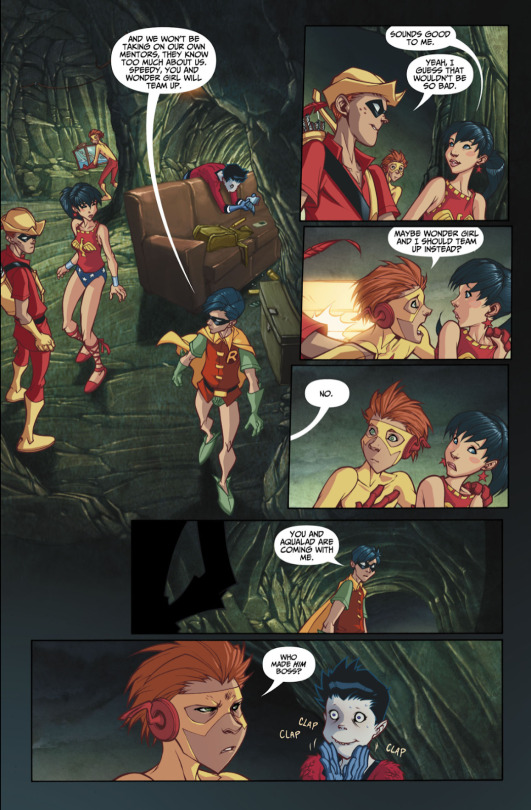
(Wolfram, Amy, writer. Kerschl, Karl, illustrator. In the Beginning… Part Three. Teen Titans: Year One no. 03, e-book ed. DC Comics, 2008. pp. 09)
One of Dick’s core traits is that he is a natural, if at times reluctant, leader. Many key moments in his character history are defined by Dick feeling the weight of the responsibilities placed upon him and having to push through his personal reservations for the sake of others.
Dick was the first child hero. He was the first sidekick. Out of universe and in universe. (In the introduction to Dick Grayson, Boy Wonder: Scholars and Creators on 75 years of Robin, Nightwing, and Batman, Kristen L. Geaman mentions that some argue Mister America from Action Comics #2 is, in fact, the first side-kick. However, this claim is debated since Mister America played more of a comedic and “Watsonian” role [as Dick Grayson Fan C suggested], and Dick was the one who popularized the formula of the role.) He was the proof that the concept of a sidekick — a partner — could work. Proof that kids could be trained into this life. Proof that they did not need powers in order to be a hero. That is one of the reasons why, in-universe, he is admired by so many characters – because he is the trailblazer who opened the doors for every young hero and side-kick that came after him. Dick’s history is also why he has so many connections — it is because he was the one who opened the doors for everyone else, mentored so many people, and partnered with those who were his age and those who were much older that he gained so much respect in the superhero community.
And yet, that history is called into question in Taylor’s narrative when he frames Dick as a young, new hero who is just beginning to assess what he wants to do with his life. Not only is it bad storytelling to portray Dick’s connections without factoring in the experience tied into them, it also demonstrates a fundamental lack of understanding of who Dick is, what he represents, and why he’s been so beloved for over 80 years.
This lack of appreciation and of respect towards Dick is extended to the other Titans in Taylor’s Titans (2023) run. As he himself pointed out, the first arc is called Out of the Shadows because, in his words, the Titans are “stepping out of the shadows of the Justice League.”
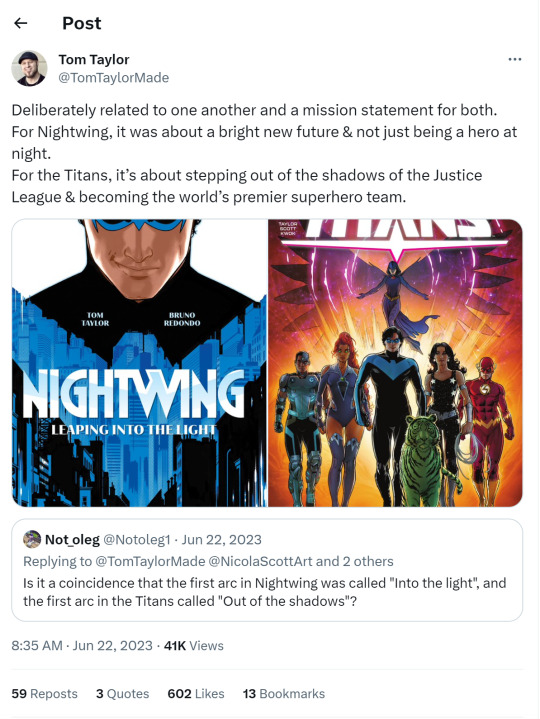
(Taylor, Tom [TomTaylorMade]. Twitter, 22 June 2023, https://twitter.com/jesswchen/status/1636971185782259716?s=20.)
And yet, to its fans, the Titans were never in the Justice League’s shadows. They were not inferior or subordinate to the Justice League, even if they may be less known. In-universe, the Titans may have modeled themselves after the Justice League and they may be allies, but the Titans are still an independent entity. From their very inception they defined themselves in contrast with how the Justice League operates.
In fact, in JLA/Titans #02, Dick himself draws this distinction when arguing with Bruce and calling him out on his condescending behavior towards the Titans.

(Grayson, Devin; Jimenez, Phil, writers. Jimenez, Phil; Brown, Eliot R., illustrator. The Generation Gap. JLA/Titans no. 02, e-book ed. DC Comics, 1998. pp. 23)
Trying to repackage Dick and the Titans as newbie heroes who are only now experiencing independence demonstrates a lack of understanding of their history and who the Titans are meant to be. The Dark Crisis and The Dawn of the DCU attempt to frame Dick’s Nightwing series and Titans as coming-of-age tales, where only now the characters are stepping into adulthood. Taylor’s writing goes a step further and portrays them as making rookie mistakes, coming across as newbies, and as a result, erasing all of the rich history that have built these characters into who they are today.
As I mentioned above, even if we generously interpreted that Dick never lived in Bludhaven before, Dick should still have plenty of experience being a hero and living on his own. The moment in which he transitions from Robin to Nightwing (willingly or unwillingly depending on your preferred Nightwing origin story) is Dick’s coming-of-age moment. By the time he comes to Bludhaven, Dick already knows who he is, what he wants, and he knows how to care for himself. By the time Dick comes to Bludhaven, his internal struggles are not that of a young adult who just left the nest and does not yet feel like an adult, but rather that of an adult who knows his own abilities and is confident in who he is.
And yet, in Nightwing #84, the first issue in Nightwing: Fear State, Taylor has Dick pondering on the responsibilities of taking care of Bludhaven. Right on the first page, he says “Fighting an entire corrupt system? Saving a whole city? There’s no training for that.”

(Taylor, Tom, writer. Rodriguez, Robbi, illustrator. Fear State Part 1 of 3. Nightwing: Rebirth. 84, e-book ed. DC Comics, 2021. pp 03)
Except even the most basic knowledge of Dick’s character shows that he was, in fact, trained to save an entire system and to fight a corrupt system — he was trained to care for Gotham and to take out the corrupt systems that prevail in that city. Not only that, Dick has also been Batman, at which point he was also Gotham’s main protector.
This mistake becomes even more outrageous when one considers that, though Taylor’s run is at times treated as a soft-reboot, Dick is still shown to have lived in Bludhaven while operating as Nightwing. This means that that generous interpretation I’ve been alluding to is not, in fact, compatible with the story as it is written. It is a falsehood, and therefore cannot be used to excuse the “new-in-town” approach Taylor uses when writing Dick.
Dick’s apparent inexperience and, frankly, incompetence, is further highlighted by the amount of times Dick is saved by others, or the amount of times when he is dependent on others to do the work for him. These instances include, but are not limited to:
The people of Bludhaven answering Nightwing’s call when Heartless sets the tent city on fire in #81

(Taylor, Tom, writer. Redondo, Bruno, illustrator Leaping into the Light Part 4. Nightwing: Rebirth. 81, e-book ed. DC Comics, 2021. pp 13)
Dick being knocked out with a single blow and then unmasked during his first attempt to investigate Melinda also in issues #81
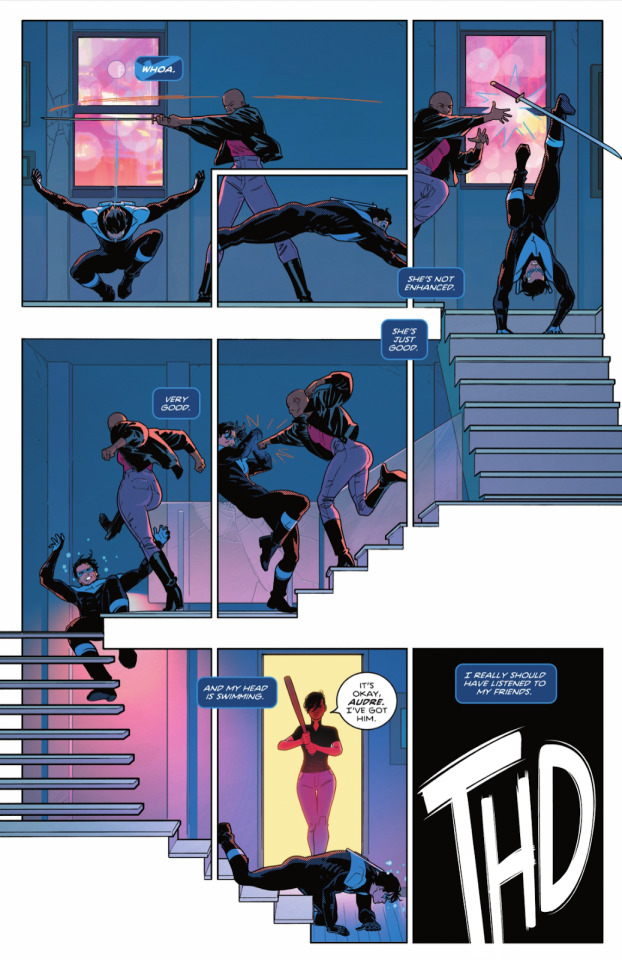
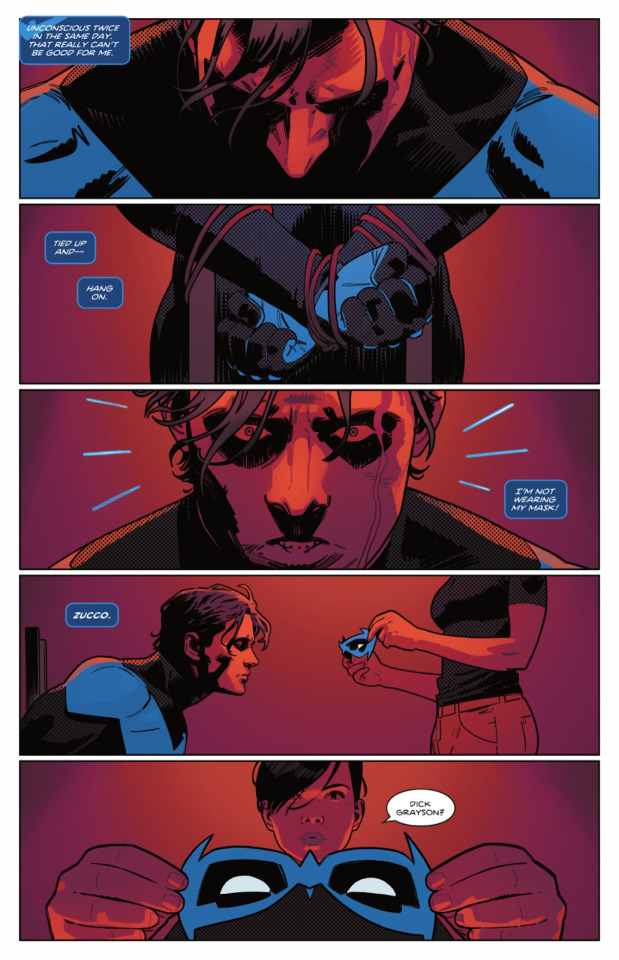
(Taylor, Tom, writer. Redondo, Bruno, illustrator Leaping into the Light Part 4. Nightwing: Rebirth. 81, e-book ed. DC Comics, 2021. pp 20 - 21)
Babs calling people to Dick’s rescue rather than trusting he could get out of it on his own in #82.
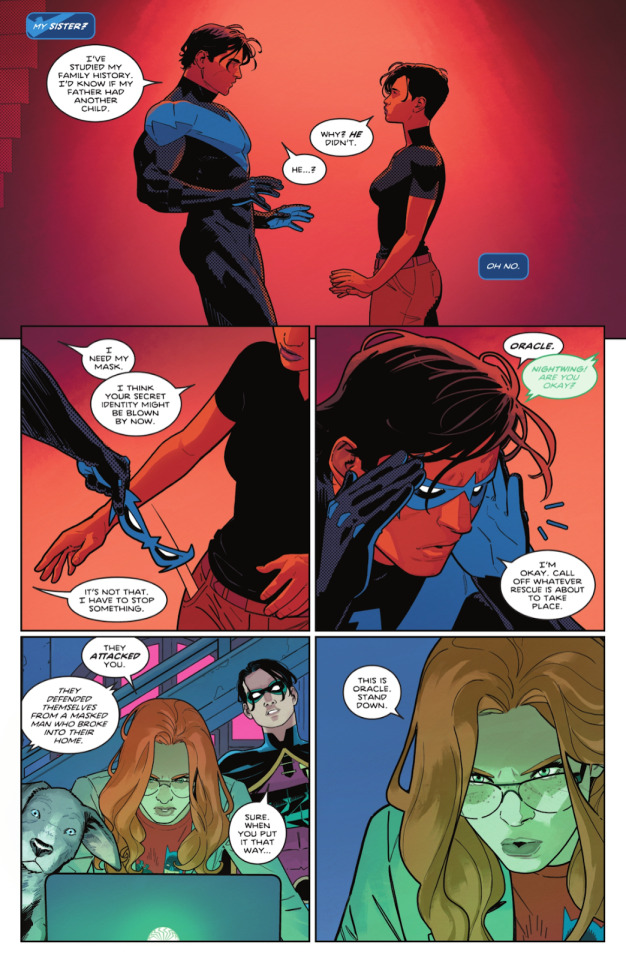
(Taylor, Tom, writer. Redondo, Bruno, illustrator. Leaping into the Light Part 5. Nightwing: Rebirth. 82, e-book ed. DC Comics, 2021. pp 03)
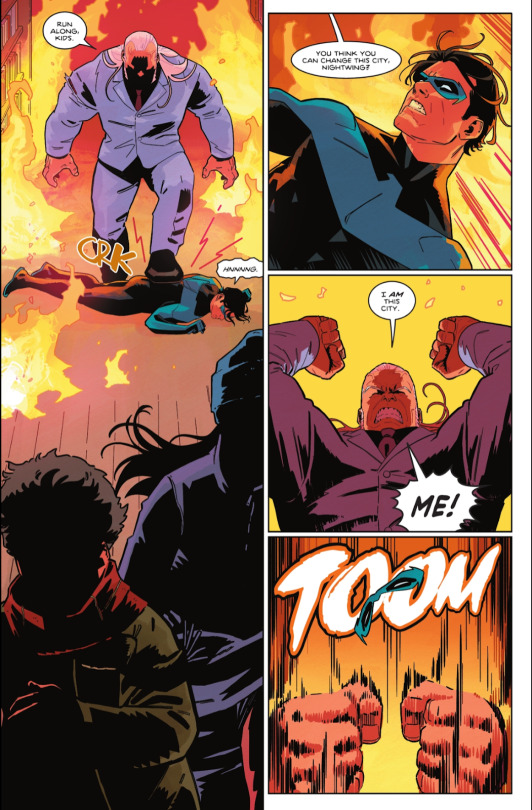

(Taylor, Tom, writer. Redondo, Bruno, illustrator. The Battle for Bludhaven’s Heart Part Four. Nightwing: Rebirth. 95, e-book ed. DC Comics, 2022. pp 24 - 25)
In #90, when his building blew up and Wally came to save him, then proceeded to force him to rest away from Bludhaven instead of letting him take action.

(Taylor, Tom, writer. Redondo, Bruno, illustrator Get Grayson Act Three. Nightwing: Rebirth. 90, e-book ed. DC Comics, 2022. pp 15)
And needing Babs’ help during a car chase in #106,
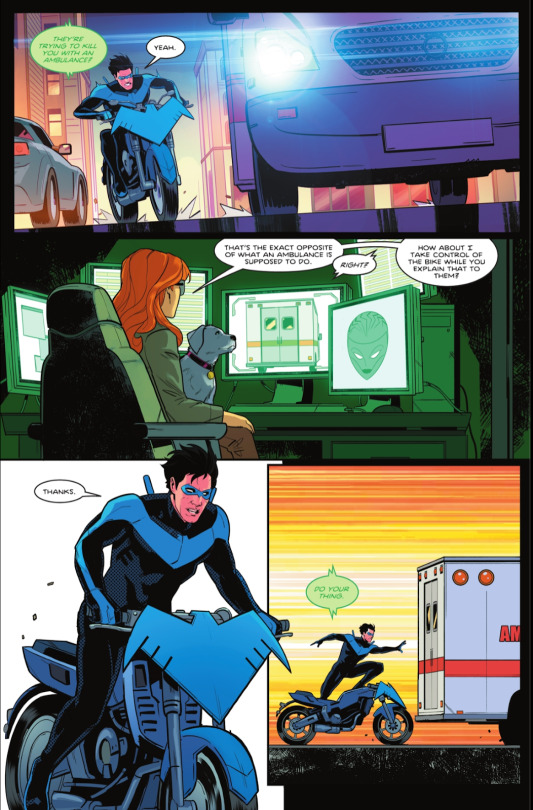
(Taylor, Tom, writer. Byrne, Stephen. The Crew of the Crossed Part One. Nightwing: Rebirth. 106, e-book ed. DC Comics, 2023. pp 16)
Which greatly contrasts how, in #113 of the Nightwing (1996), Dick handles a similar situation while simultaneously mentoring Rose Wilson.
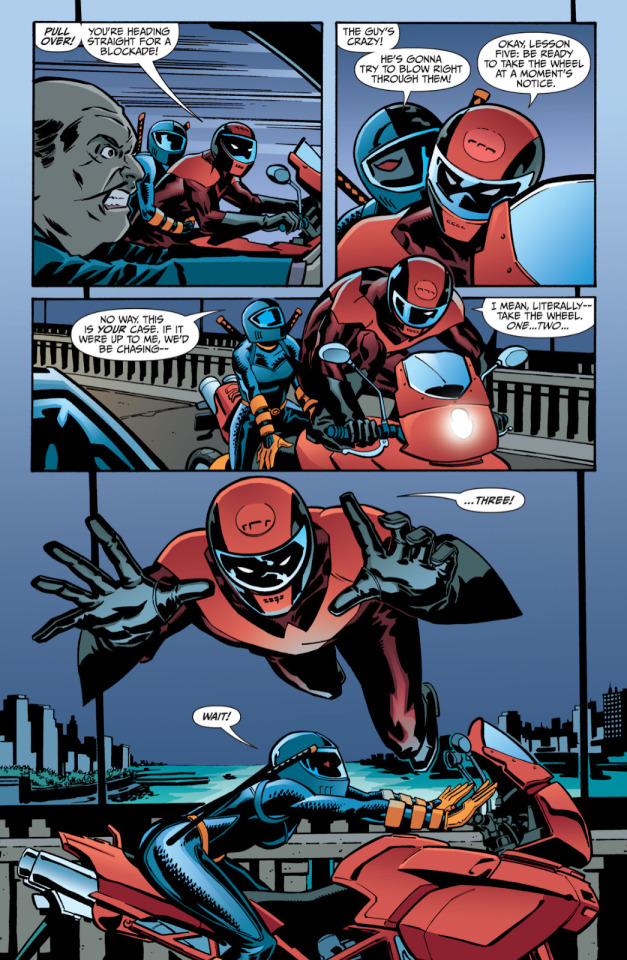
(Grayson, Devin, writer. Chian, Cliff, illustrator The Scorpion and the Frog. Nightwing no 113, e-book ed. DC Comics, 2005. pp. 19)
The thesis of Taylor’s run is that people need to rely on one another — we have to be each other’s safety net. And while that is an interesting theme to explore and one that certainly speaks to Dick’s history of doing things on his own out of fear of putting others in danger, Dick should still, more times than not, be able to do things by himself. After all, this is not an ensemble piece — this is Nightwing’s story and as his fans, we want to read about him. Cameos are fine. They can be fun, in fact. But cameos are different from Dick constantly struggling and needing help whenever he faces a challenge – the former portrays Dick as someone with powerful connections that deeply love him; the latter portrays Dick as being incapable of doing things without someone holding his hand.
This is another thing that Waid understands about Dick and portrays it clearly in World’s Finest. When Kara explains to Clark what first attracted her to Dick, she emphasizes how, despite the fact he had no powers, he could still save himself.
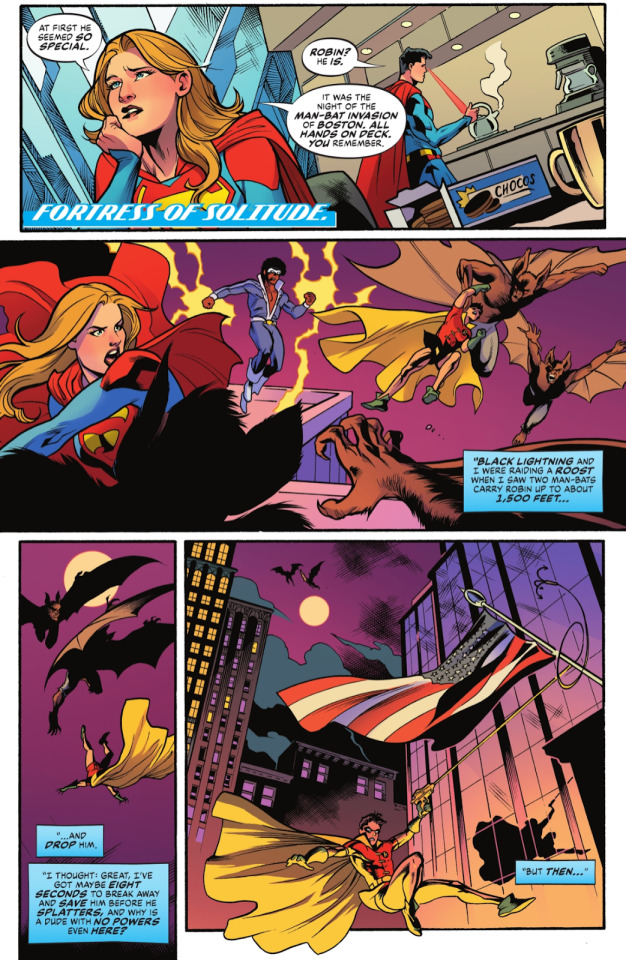
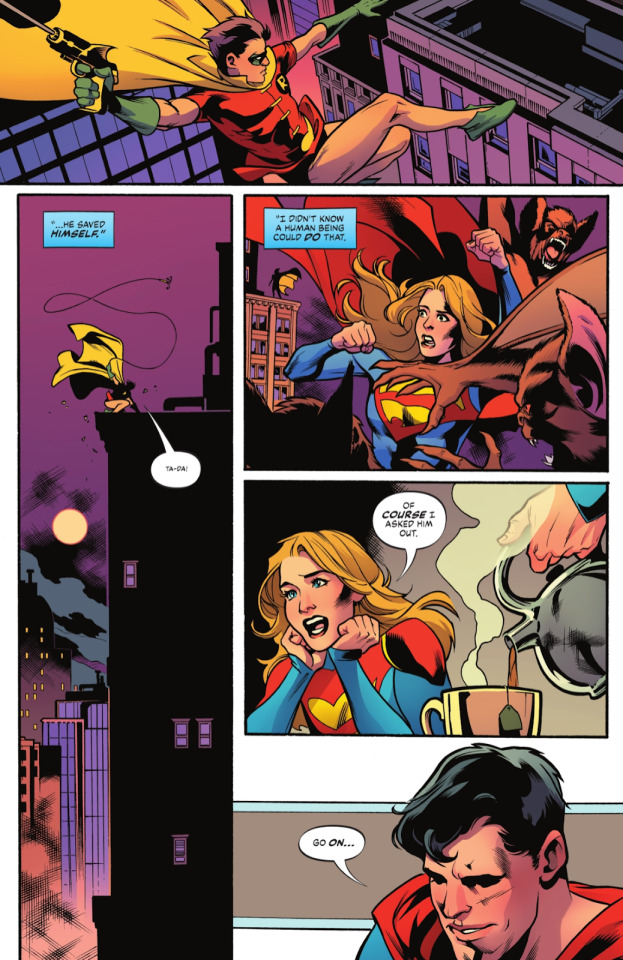
(Waid, Mark, writer. Lupacchino, Emanuela, illustrator. Scream of the Chaos Monkey. Batman/Superman: World’s Finest no. 12, e-book ed. DC Comics, 2023. pp. 06 - 07)
Being not just competent, but exceeding even the highest expectations is at the core of Dick’s character. And, as was pointed out in the previous section, it also serves to feed into his toxic perfectionism — he is one of the top tier heroes, therefore people expect excellence from him. Dick does not want to fail those who put their trust in him, and so he demands perfection of himself to the point of self-destruction.
Beyond that, we cannot give Taylor credit for trying to tell a story about Dick growing out of his perfectionist bad habits by learning to rely on others. After all, if Dick is constantly asking for help, then he is not resisting help. And that removes his chance for growth. A character arc requires development and change, which means one cannot start at the endpoint. Therefore, it cannot be claimed that Taylor’s intentions are for Dick to learn to rely on others, for he has been doing so without hesitation since the beginning.
As a result, the story is not about Dick being Bludhaven’s safety net while learning that he also has a safety net of his own, but rather about Dick always relying on his safety net, always knowing it was there, and having them also shoulder the responsibilities he took when he named himself Bludhaven’s protector. There is no room for Dick to grow because he is already at the end of his journey. And there is no room for Dick to be the hero of his story because others are constantly coming to his rescue when things get too difficult.
Once more, I must clarify that I’m not saying that Dick is not loved, or that Dick is not important to many people. I’m simply stating that the way his relationships are built gives him very little room to rely on them. He is their safety net but he doesn’t trust them to be his safety net. Exploring this requires going into the nuances of each relationship, where conflicts are created, and where people hurt the other in the heat of an argument. It would mean dealing with the messiness of complex human emotions, forcing characters and the audience to sit with uncomfortable feelings as we get to the root of Dick’s perfectionism and his fears.
In June of 2022 a reader on Twitter asked Taylor about his decision to have Dick constantly falling, for, as they pointed out, this makes Dick look incompetent.

(Jonathan [@Nightwingdagoat]. Twitter, 21 June 2022, https://twitter.com/Nightwingdagoat/status/1539267708310765568)
Taylor responded by saying that these instances were Redondo’s call, and that it was their attempt to humanize Dick.

(Tom Taylor [@TomTaylorMade]. Twitter, 21 June 2022, https://twitter.com/Nightwingdagoat/status/1539267708310765568)
In fairness to Taylor, the following criticism will then be directed primarily at Redondo who believed these instances were the best way to “remind people that Nightwing is human.” That being said, as Taylor appears to support such a position, and as he has written numerous incidents where Dick is conveniently knocked over by others, I do believe this can be directed at him as well.
Simply put, to have a character constantly fall is a superficial and lazy way to humanize said character. Casual falls like this, after all, are not failures. They contribute little to the story and have very little consequence.
Nothing happens once Dick falls. The bad guy doesn’t get away, the innocent civilian is not hurt, the crucial piece of evidence needed to crack the case is not destroyed. There are no lasting consequences for Dick to deal with, no conflict that can arise from these falls, no tension to make Dick’s future success more emotionally effective. Furthermore, these falls are completely out of Dick’s control, taking away any responsibility he might have for his mistakes.
If the flaws that are meant to “humanize” Dick are falls which he bears no agency over, then he, the good guy, has no responsibility over his own “failures.” Said “failures” also end up having no consequences to the plot, which gives Dick no crisis to respond to (furthering his passivity), and this robs Dick of character development opportunities.
It creates a stasis in the story where the only conflicts Dick faces are the ones against really bad guys that always – always – lose to Dick and his connections, and ones which do not ask for moments of introspection.
Despite almost never falling in The Untouchable, Dick is far more human there than in Taylor’s and Redondo’s run. This is because Dick is forced to face the consequences of his “failure” to capture the Judge twice in the past. Dick is constantly thinking about the Judge’s victims, forcing himself to carry their lives on his shoulder. He pushes himself to toxic lengths. Whenever the Judge escapes his grasp, the conflict evolves, the stakes are raised, and the tension builds. Dick’s desperation becomes visceral to the reader, and that is what humanizes him to the reader. Similarly, the emotional pay-off of the climactic battle in the end grows with each obstacle Dick faces.
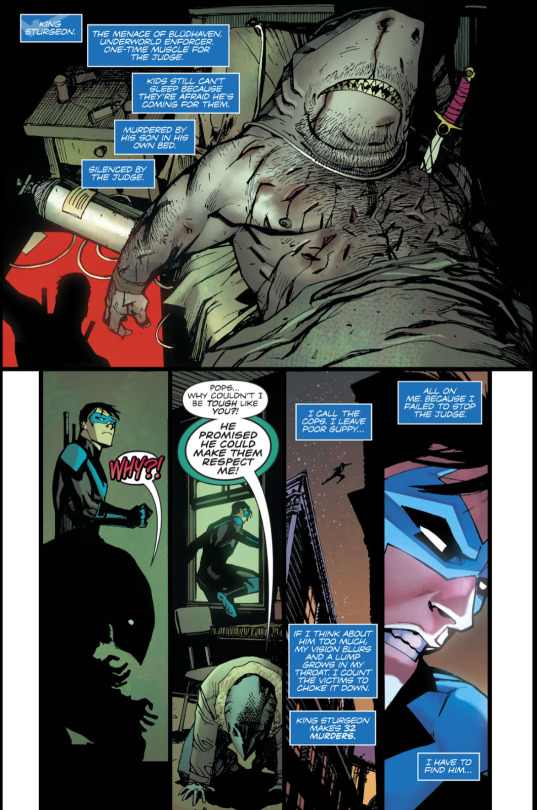
(Humphries, Sam, writer. Chang, Bernard, illustrator The Untouchable: Chapter Four: Infiltration. Nightwing: Rebirth no. 38, e-book ed. DC Comics, 2018. pp. 09)
But Dick’s newbie incompetence is not the only way Taylor mischaracterizes Dick. It is by combining the lighthearted tone of his story, his depiction of Dick as a blank canvas “good guy,” his avoidance of conflict, and his attempts at answering difficult real-world problems that Taylor ends up creating a version of Dick Grayson that is utterly self-absorbed and lacking in foresight.
Telling and not showing is an immense problem in Taylor’s writing. There’s a difference between how a writer attempts to portray a character and how, given their actions in the context of the narrative created, the story shows them to be the complete opposite. In such cases, the story triumphs over the writer. This is why I claim that, though Taylor tells the reader that Dick is caring, intelligent, and a hard worker, he actually shows Dick as as selfish, incompetent, and naive.
Take, as an example, how Taylor sidelines the Heartless storyline in favor of slice-of-life scenes. If Heartless was not there, perhaps those sweet moments could be just that. However, as in the world of the story there is currently a serial killed running around free, making orphans out of the youth Dick vowed to protect, the fact that Dick is not constantly working to catch Heartless is not only out of character, it makes it so it seems he doesn't care what happens to the people of Bludhaven (And now also Gotham, given #111, which was released as this essay was being edited). Rather than stopping crime and bringing justice to Heartless’ victims, Dick would rather spend his nights in his apartment, enjoying a relaxing evening with his girlfriend and his dog.
Please do not take this to mean that I consider a slice-of-life story to be inferior to other genres. My reason for highlighting this is not to undermine the value of slice-of-life, but rather to argue that such scenes do not live in isolation. They exist within the context of a larger narrative, and what would be sweet in a sitcom-style story comes across as something entirely different when other characters are facing life-and-death stakes. It does not matter how much the writer tells us that these characters are caring and compassionate — their lack of action and urgency portrays them as self-centered.
Just as Taylor attempts to write the big climatic moments without properly building the momentum necessary to make them impactful, he similarly forgoes the work required to win the reader’s trust, and instead expects his audience to simply accept that important plot and character developments are happening off-screen. Rather than letting the audience experience the intrigue and devastation of the Heartless mystery by showing us how the horrors of these murders motivate Dick to continuously search for this cruel killer, Taylor instead advances these elements off-screen, opting instead to tell the reader they’ve occurred.
That is not to say that writers cannot streamline plots. They absolutely can and, in some cases, they absolutely should. However, streamlining a subplot is a far more complicated matter than just telling the reader said events happened off-screen and expecting them to simply accept it.
While it is impossible to provide a precise checklist with the step-by-step guidelines on how to properly streamline a subplot, I believe one of the factors one must consider is whether that plot should be streamlined or not. Personally, I believe that Dick investigating the character who was meant to be this run’s main villain is too big and too important of a story to be played off offscreen.
Dick has hardly spent any time attempting to apprehend Heartless. Instead, as time of writing, his investigation of Heartless has practically nonexistent. Instead, after not focusing on him for the majority of the run, we are simply told by Dick and Babs that they’ve been keeping an eye on Heartless, even if their investigation is never shown to us.
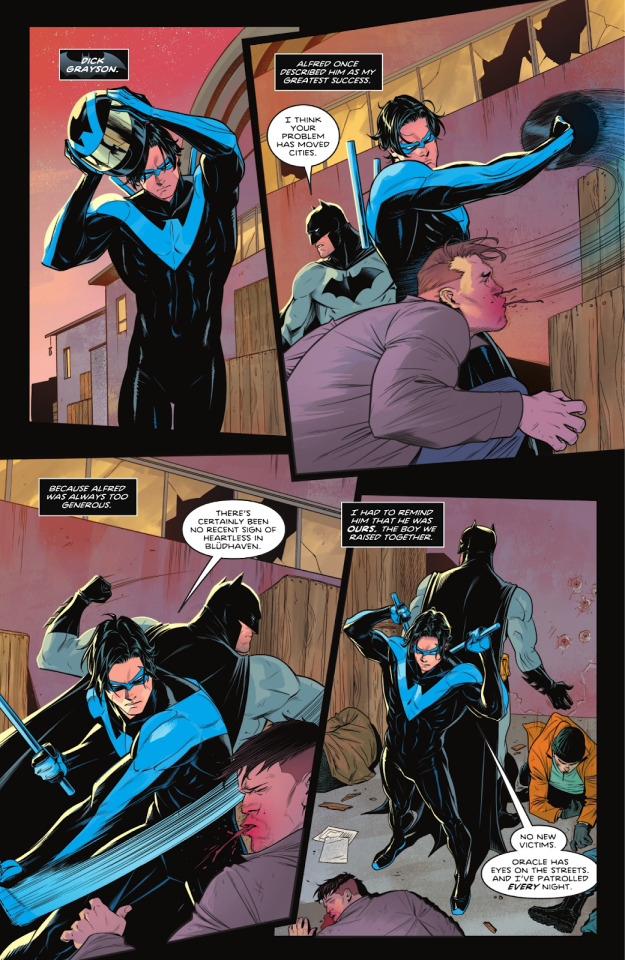
(Taylor, Tom, writer. Basri, Sami Nightwing. Nightwing: Rebirth. 111, e-book ed. DC Comics, 2023. pp 09)
If we, as readers, are to believe that Dick is the selfless detective and hero ��� the Heart of the DCU — that Taylor tell us he is, then finding and apprehending Heartless should be one of his top priorities. If Heartless was meant to be Nightwing’s big nemesis, then their confrontation should always be a source of great tension and conflict. Such importance would be demonstrated by showing Dick working towards stopping him at every moment he has free. But either those moments are not happening at all, or they are happening off-screen.
Having such an important conflict and such a crucial antagonistic dynamic develop does nothing to enrich the plot — in fact, it only detracts from them, for because we do not get to witness this relationship grow and we are only told that it is happening, the pay off that must come when Nightwing and Heartless finally have a big confrontation will be cheapened as a result.
Heartless' actions are so brutal and create such urgency that not prioritizing Heartless' arrest makes it seem like Dick doesn't care about his victims. Batman doesn't wait around when the Joker breaks out of Arkham – he hunts the Joker down. Similarly, Dick didn't wait around on the Judge – he hunted him down.
For Heartless to be the Big Bad, Dick should have put him in jail already and Heartless should have escaped. DIck should have faced him multiple times. He should have been Dick's priority because of how cruel and urgent his actions are.
Finally, there are three particular moments that I wish to discuss to illustrate how ambivalent Taylor is when it comes to Dick’s characterization, choosing to prioritize online discourse over who Dick Grayson’s established history and personality.
The first one comes from a throwaway line. And yet, because this was a throwaway line that demonstrated how little thought Taylor gives to his main character.
When Tim makes his first appearance in Taylor’s run in #80, Dick’s narration says that many would consider Tim to be the best Robin, and that he “totally gets it.”
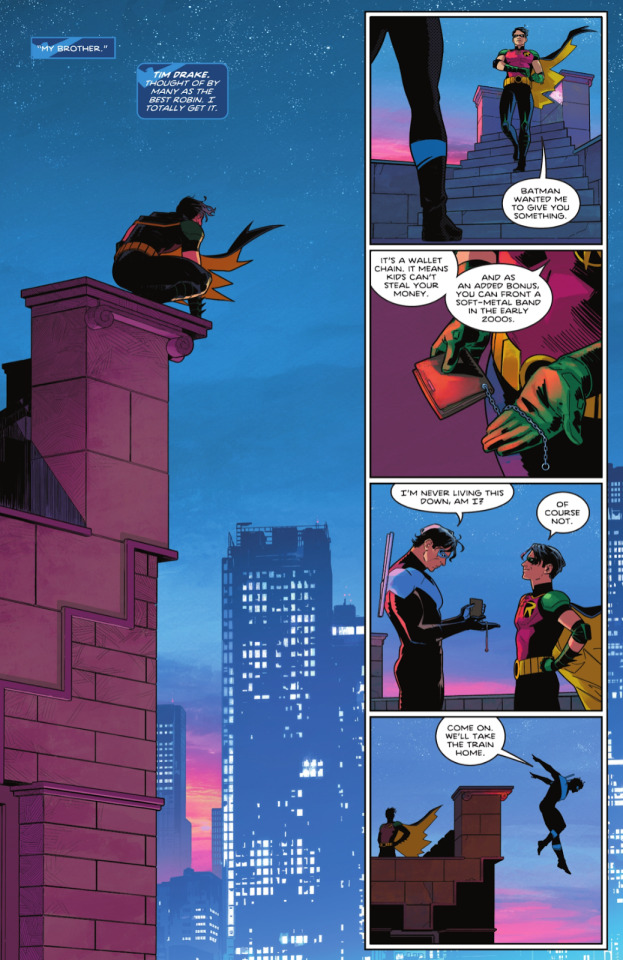
(Taylor, Tom, writer. Redondo, Bruno, illustrator. Leaping into the Light Part Three. Nightwing: Rebirth. 80, e-book ed. DC Comics, 2021. pp 09)
“Who is the best Robin” is a discourse that I, admittedly, care very little for. It serves no purpose other than to get fans to fight one another, bashing each other’s favorite characters in order to prop up their own. When posed on social media, this question becomes a thinly veiled attempt to generate high engagement. In reality, when people discuss “who is the best Robin,” they are, most often than not, truly arguing about who is their favorite Robin. But the question is framed in a way to be purposefully divisive, creating conflict within the fan community. The fact that DC plays into that divisiveness that requires their characters to be brought down so others can be lifted up for marketing material is concerning, but the fact that writers such as Taylor are letting that fan perception bleed into in-universe narration is nothing less than lazy writing that prioritizes online leaning into buzz over good storytelling.
Naturally, as a Dick Grayson fan my opinion is that Tim is not the best Robin. Dick is. But my problem is not that Taylor said that Tim was the better Robin, but that I think Dick would never concede to the existence of a “best Robin.” In fact, not only do I believe that it is out of character for Dick to believe that one Robin can be defined as the best Robin, I would argue that Dick would be offended that such a question could be asked.
Dick, more than any of the other Robins, understands the purpose of a Robin, as he was the one who created the mantle. By seeing so many others inherit his family’s colors and his mother’s name for him, he also understands better than anyone that each person who becomes Robin has their purpose in their own unique way. Dick would understand how each of them made the Robin mantle unique, how they added to its mythos in their own way, and how all of their contributions are equally valid and equally important. He would never single out one of them as the best because he knows that Robin is about an ideal of justice by bringing light into the darkness. Most importantly, understanding how many Robins tied their self-worth to the mantle, Dick would never want others to feel as if they fell short of some arbitrary measure by proclaiming they are not “the best.” Dick would be against that measure, against the very idea of ranking Robins, as if they were interchangeable, as if they each didn’t make relevant contributions. He would hate the idea of the mantle he created in honor of his parents being used to judge and measure the worth of those he loves. Dick would argue that there can never be a "best Robin" because Robin is always about being your best self in the service of those who need your help, and you can't quantify that.
The concept of a “Best Robin” is a marketing strategy and a fan-oriented discourse that Taylor casually imposed into the narrative without considering whether his protagonist would adhere to such ideas. He prioritized internet discourse over characterization, and while the former may be immediately fulfilling as the page is cropped and shared a few thousand times in the first few days after publication, only the latter will leave an impression that will last decades. Taylor is embodying a current DC Comics trend to favor the former over the latter. As scholar Steve Baxi said in his review of Leaping into the Light, that page “doesn’t feel like Dick Grayson appreciating his brother, it feels like Dick Grayson saying what the audience wants to hear.” (Baxi, Steve, “TRADE COLLECTION REVIEW: Nightwing Vol. 1 - Leaping Into The Light” Comics Bookcase, August 2021)
Although they share similar problems, unlike the “Tim is the best Robin” throwaway narration, the second example I wish to discuss in detail became a big plot point in the beginning of Taylor’s run. I’m referring to the choice of having Dick become a billionaire due to the inheritance Alfred left to him.
To be more clear, my problem is not with the fact that Taylor made Dick into a billionaire (after all, Dick inheriting wealth from his parents is not a novel concept), but rather with Dick’s musings on the subject. (Dick’s financial situation is inconsistent across the years. While some like Dixon and Wolfman allude to him having a trust fund his parents set aside and that remained untouched until Dick’s adulthood, other writers like Humphrey who portray him as more middle class and sometimes struggling financially. Then there are the numerous times in which Dick was left homeless, implying that he did not have a safety fund to go to when tragedy struck.) On #79, Dick says, without a hint of irony, that he always thought that Bruce could do more to help Gotham with Bruce Wayne’s money than he does as Batman.
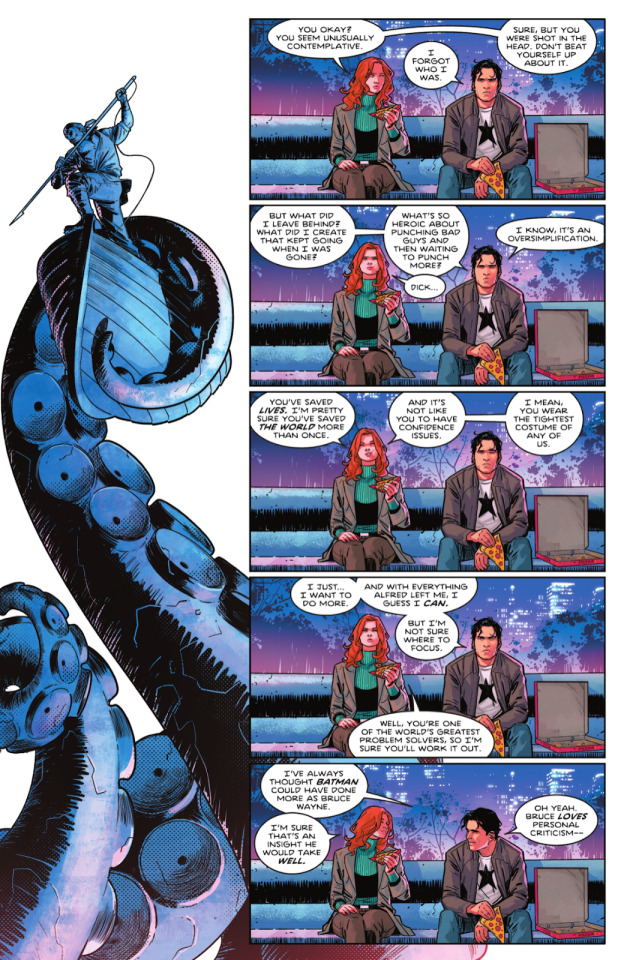
(Taylor, Tom. writer, Redondo, Bruno, illustrator Leaping into the Light Part Two. Nightwing: Rebirth. 79, e-book ed. DC Comics, 2021. pp 07)
This is a popular online discourse that reveals lack of knowledge about Batman and a naive understanding of how corrupt systems function. I understand we are currently very critical (and rightly so) of billionaires and the hoarding of wealth. I understand that this leads many — media critics and everyday fans — to analyzing how wealth is portrayed in the stories that resonate within our culture. But anyone who claims that Bruce has not used his wealth for the benefit of Gotham outside of funding his Batman endeavors has not engaged properly with Batman media. I’m not going to go into the merits of how Bruce’s wealth should or should not be portrayed and how DC has currently been handling this issue (that is the subject for an entirely different essay that is not relevant to this discussion), but I will say that Bruce has, canonically, used a lot of his money to fund safety net programs in Gotham, to invest in small businesses and on individuals, and in trying to make the city more affordable and kinder to those with less.
Twitter user Ashley|TheBatFamily 🦇 (@TheBat_Family) created a comprehensive Twitter thread of examples. These are but some of the ones that stood out to me and that feel most relevant to this essay:
In Cataclysm, Bruce attempted to lobby the US government to offer aid to Gotham after the earthquake;
Bruce used his money to rebuild the city during No Man’s Land;
Bruce invested in the people who were ready to start new businesses so Gotham could offer jobs to its people and rebuild itself without being fully dependent on others;
Bruce created scholarships so more people could attend university;
Bruce funds Leslie’s free clinic as well as other hospitals around Gotham;
Bruce invested on low-income housing developments in Gotham by working with local firms, providing accommodations to local residents so no one would be displaced;
Bruce expanded and modernized Gotham’s public transportation system;
Bruce ensured all Wayne properties were secured against earthquakes (which led to those residences being the only ones standing during NML);
Bruce funds libraries and museums;
Bruce funds green efforts not just in Gotham, but in other places by buying land and making them nature preserves;
Bruce funds orphanages and provided them resources (from educational supplies to toys for the children);
Bruce provided support for immigrants;
Bruce funds appeals for wrongful convictions;
Bruce provides employment for former convicts;
(Ashley [TheBat_Family]. Twitter, 13 October 2020, https://twitter.com/TheBat_Family/status/1316006509923520512.)
In short, Bruce Wayne has done everything and more that Dick claimed he wished to do for Bludhaven. There’s nothing novel about the idea. Batman narratives don’t put as much focus on these endeavors and do not place as much emphasis on Bruce’s philanthropy simply because they Batman stories are, at their core, detective stories first and foremost. Their focus is on investigation and crime solving (Though I would argue that Cataclysm and No Man’s Land put a lot of focus on issues of wealth, class, and examine Bruce’s financial responsibility towards the city).
But just because these examples are not the focus of the stories in which they are present, it does not mean that they do not exist. Neither does it mean that Batman stories do not engage with themes of wealth and class inequality, as well as systemic corruption. In fact, I would argue that many of the best ones know how to use Bruce’s privileged status to explore these issues. The Court of Owls by Scott Snyder, for example, brilliantly uses the Court and the Talons to engage with these themes. (An essay analyzing the Court of Owls through such a lens would be a fascinating study, especially when exploring the parallels and foils between the Court and the Talons, and Bruce and Dick. Alas, this is not the place for it.)
Dick, who not only has always been characterized as knowing Bruce better than most people, but who was also raised by Bruce, would know about every single one of the examples listed above. Dick, of all people, had a front row seat to all the ways in which Bruce helped Gotham with his wealth, both in examples that were covered by the press, and the ones Bruce did secretly without taking credit. Dick attended countless fundraising events, press briefs, boardroom meetings. But most importantly, Dick would have witnessed with his very own eyes that lack of funding is not at the root of Gotham’s problems.
The problem in Gotham is not lack of money or safety nets, but rather, it is that its systems are so corrupt that pumping more funds into it will do nothing to help those in need. Instead, it will only further enrich those who are already in power. That’s why in this comic book world with comic book conventions and comic book logic, Batman is needed. Batman is a disruption to the system, forcing it to change, dismantling it from both the outside and the inside. In Dixon and Grayson’s Nightwing runs, Dick’s understanding of systematic problems can be observed in his motivation to become a police officer, as he joins the force with the goal to weed out the corruption and dismantle the system from within. Money alone cannot save a city if the foundation was purposefully designed to favor those on the top by taking from those at the bottom.
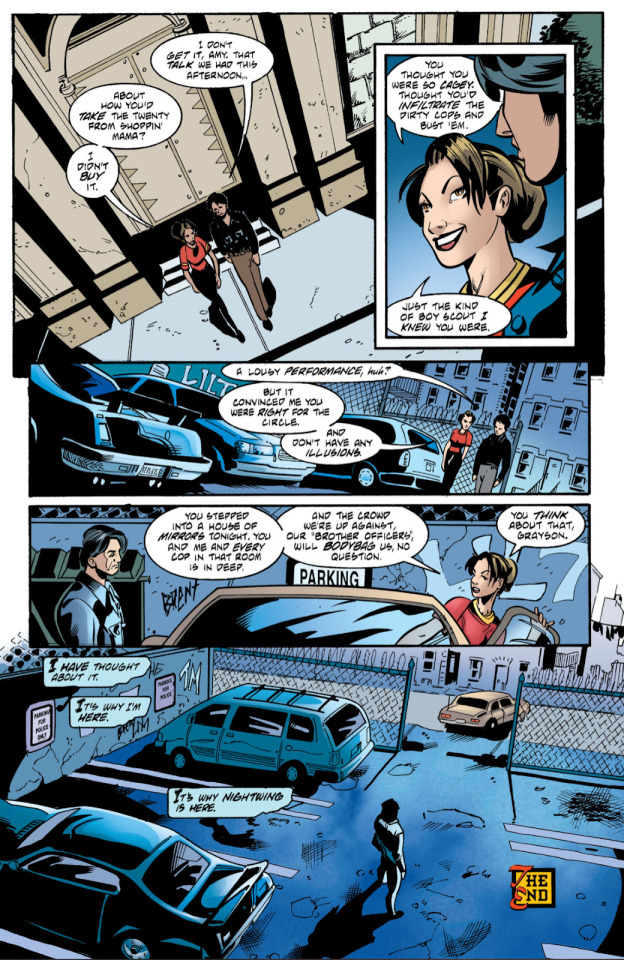
(Dixon, Chuck, writer. McCarthy, Trevor, illustrator The Threshold. Nightwing. 60, e-book ed. DC Comics, 2001. pp 22)
But of course, Taylor never takes a moment to wonder how being raised by Bruce Wayne would influence Dick’s perspective on this matter. Instead, he once more takes a popular online discourse and makes Dick say it out without considering characterization. A more in-character and canonically accurate approach to such a story moment would have Dick comment on all the ways Bruce used his money behind the scenes to help Gotham, and how he wishes to do the same for Bludhaven. A single line change would have demonstrated Taylor's willingness to engage with Dick’s character history rather than just copying the hot takes he sees on social media.
Not only that, this change in dialogue would also establish Bruce and Dick’s closeness as it would show that not only is Bruce a source of inspiration for Dick, but that Dick is one of the few people who have seen this side of Bruce. That would have also made the hug between Bruce and Dick in the #100 more emotionally effective and thematically cohesive, especially as they are in front of Alfred’s grave.
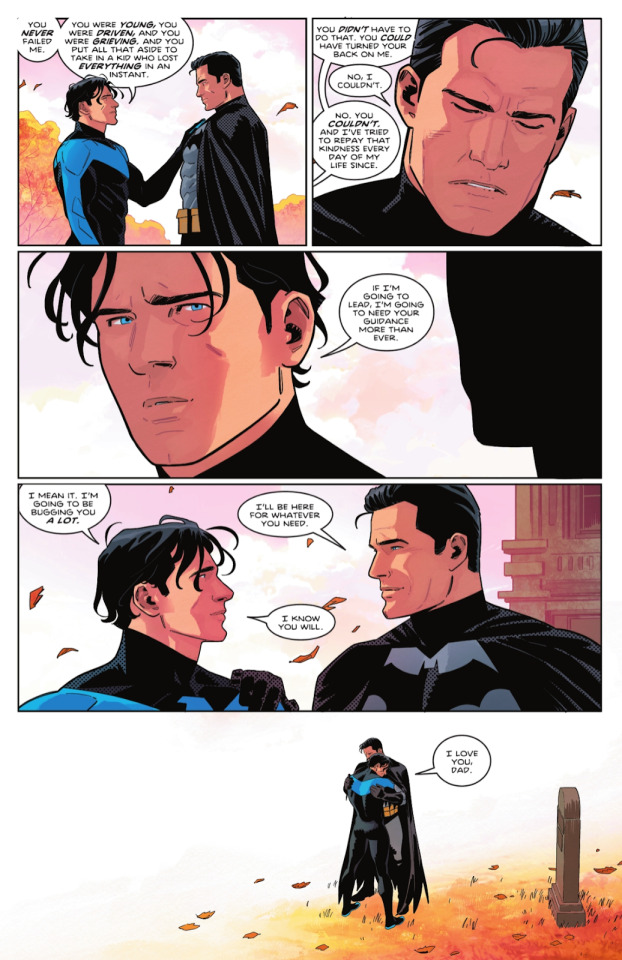
(Taylor, Tom, writer. Redondo, Bruno, illustrator Power Vacuum: Part Four: The Leap. Nightwing: Rebirth. 100, e-book ed. DC Comics, 2023. pp 44)
The truth is that Dick's Haven project engaged with issues homelessness only in the most shallow of manners. Rather than discussing the realities of this matter, it simply used it as a backdrop. It is an appropriation of hardships by someone who is unwilling to engage with the difficulties brought upon by said hardships. It is substance-less writing masquerading as social consciousness.
The third example I wish to cite which demonstrates Taylor’s lack of consideration for Dick’s character or his backstory comes when Haley is taken in #87. Dick’s internal monologue reads that “The last thing I’d want is for anyone to be threatened because they’re close to Dick Grayson,” referring to the fact that he is now a public figure thanks to the press conference he gave about his plans for Bludhaven.
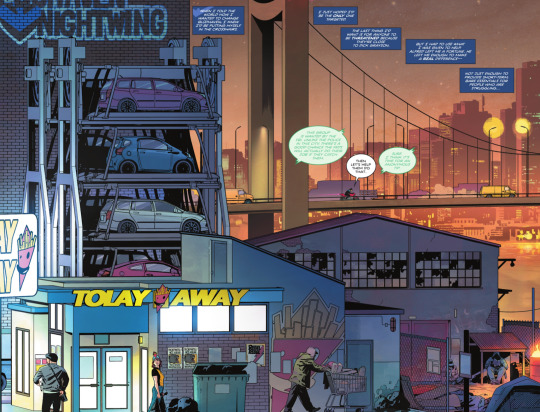
(Taylor, Tom, writer. Redondo, Bruno, illustrator Get Grayson. Nightwing: Rebirth. 87, e-book ed. DC Comics, 2021. pp 09)
The idea that Dick Grayson, billionaire Bruce Wayne’s first child, was unaware of the dangers faced by those associated with a public figure is laughable. The idea that the first Robin, who was often taken hostage by villains who wished to get to Batman (so much so that Frank Miller famously nicknamed him “Boy Hostage”), did not understand the threat posed to those who are close to powerful figures is insulting. After well over a decade as a superhero, and after well over a decade of being associated with a wealthy public figure, Dick should know better than most how such ties can put loved ones at risk.
In-universe, this line makes Dick appear so self-centered that he does not take into consideration how his actions affect his loved ones. It makes him appear dense, unable to think through his actions and strategize contingency plans and safety precautions before taking such a giant risk.
Out of universe, this betrays a lazy way of storytelling, with Taylor going for low-hanging fruits without thinking of how that might affect the characterization of his protagonist. Out of universe, a collection of throwaway, thoughtless lines like this demonstrates just how uninterested Taylor is in giving even the slightest consideration to who Dick Grayson is meant to be, instead putting his focus on the gimmick that will get him noticed on social media.
90 notes
·
View notes
Text
A (Negative) Analysis of Tom Taylor's Nightwing Run - Introduction
Introduction
Who is Dick Grayson?
What Went Wrong? Dick's Characterization
What Went Wrong? Barbara Gordon
What Went Wrong? Bludhaven (Part 1, Part 2)
What Went Wrong? Melinda Lin Grayson
What Went Wrong? Bea Bennett
What Went Wrong? Villains
Conclusion
Bibliography
I want to start this essay by admitting I’m actually embarrassed by its length. Why did I spend so much time on something I dislike? The truth is, I did not begin this with the intention of creating such an extensive, formal study of the Tom Taylor and Bruno Redondo’s Nightwing run and how it reflects the wider problems with DC’s handling of one of their most iconic characters. I was just trying to organize the thoughts that came up during discussions with other Dick Grayson fans. Before I knew it, I had enough material, enough desire to challenge myself, and enough frustrations to vent to properly create this monstrosity.
I did not begin this Nightwing run determined to hate it. In fact, I was ready to love it. As Taylor promoted the run before the first issue was officially released, I was so excited for it. As I read short interviews where he discussed Heartless, I could not wait to have a new, incredible villain. Foolishly, I believed Taylor when he said he loved Dick Grayson.
Needless to say, I was disappointed. Then frustrated. Then angry. The beginning of any story is a period where writer and reader form an indirect bond, and as the story progresses, so do the highs and the lows of said relationship. As such, a reader’s tolerance for negative factors will either increase or decrease depending on their experience up until that point.
In other words, if the writer fails to earn the reader’s trust and instead takes their attention for granted, even seemingly insignificant details become irritating in a way they would not be if presented in a better story. In such scenarios, the reader can no longer overlook those minor moments because there’s little good to balance them out with. It is a death by a thousand cuts.
In the case of Taylor and Redondo’s run, along with those thousand cuts are also broken bones, internal bleeding, head trauma, and severed limbs. A weak plot, simplistic morality that undermines the story’s stated themes, and, most importantly, a careless disregard for Dick Grayson and everything he stands for utterly destroyed my enjoyment of this series.
It is still too early to tell what sort of impact Taylor’s (as of time of writing, still unfinished) run will have on Dick Grayson’s future portrayals. But just because we cannot predict its long term significance, it does not mean we cannot critique it. Currently, we simply lack the benefit of hindsight.
If this essay were to have a thesis, then it is this: Tom Taylor and Bruno Redondo’s Nightwing not only fails to tell a compelling Nightwing story, but it also exemplifies a cynical, self-serving, and shallow approach to storytelling that prioritizes creating hollow viral moments to boost the creators’ own online popularity over crafting a good story, honoring the character in their care, and respecting his fans – fans who have, historically, often been women, queer folk, and other individuals who felt othered by a cisheteronormative patriarchal society. Taylor and Redondo’s thoughtless and superficial narrative not only undermine the socially progressive ideals they supposedly care for by propagating a cisheteronormative patriarchal worldview, but they also demonstrate a lack of love and understanding for the character in their care. At best, Taylor and Redondo have no interest in getting to know Dick Grayson, nor any respect for their predecessor and their contributions to this character. At worst, they despise Dick so much that they wish to reinvent him into something completely different, tossing away everything that was special to his fans in order to appeal to a readership that never cared about Dick Grayson.
I structured this essay so that, hopefully, each part will build on the ones that came prior. Naturally, because all aspects of a story are interlaced, there will be overlaps between each of the sections. As it may have become obvious from this introduction, I’ll be focusing primarily on the writing of this run. That is not to say that I will not address the art, but writing is the field I know most about, and so it feels only fair to focus my critique on that.
I hope that by the end of this essay, I will have successfully proved that this run’s mishandling of different narrative elements betray a cynical appropriation of progressive ideology and a disregard and disinterest in what makes Dick Grayson so special to so many people. This is an attitude that is present within DC Comics’ current ethos as a whole.
Now, who is this essay for? Honestly, it’s probably not for Tom Taylor fans. I do not believe I’ll be persuading anyone with my writing, and, to be quite honest, neither would I say I wish to do so. Taylor and Redondo’s run has won numerous awards and has many dedicated fans who adore it for what it is. If that is you, then I’m glad. I wish I could be among your numbers. I wish more than anything that I could love this story. But I do not, and I know many others agree with me, and it is to them, I think, that I’m speaking to. As Taylor’s run is praised to heaven and back, I needed a safe space to voice my thoughts. This essay became this safe space. And to others who also feel unseen by the constant praise this run is getting, I think this could speak to you, as well. To be cliche and cringe, this will hopefully let you know that you are not alone.
Finally, I want to acknowledge some people whose thoughts greatly contributed to the creation of this essay. For around three years now I’ve been having wonderful interactions with other Dick Grayson’s fans, and those discussions were not only incredibly fun and cathartic, but also provided great insight into what needed to be included in this essay. My best friend especially gave me a space to vent when I got frustrated, and my original outline borrowed a lot from the messages I sent her, as well as notes I took for our discussions.
I’ll also be directly quoting four different Dick Grayson fans (identified as Dick Grayson Fans A, B, and C in order to allow them to keep their anonymity). Their analyses were so critical to the formation of my thesis and for a lot of what will be addressed in this essay that I actually feel like they deserve co-credit in this essay. Dick Grayson Fan B especially deserves a shoutout in helping me track down a couple of pages used as supporting evidence, as I knew what pages I was looking for but was having a hard time remembering in which issue they were located. I’m quoting them with permission, and crediting their ideas and contributions whenever relevant.
Now, without any further ado, let’s get started.
573 notes
·
View notes
Text
A (Negative) Analysis of Tom Taylor's Nightwing Run - Who is Dick Grayson?
Introduction
Who is Dick Grayson?
What Went Wrong? Dick's Characterization
What Went Wrong? Barbara Gordon
What Went Wrong? Bludhaven (Part 1, Part 2)
What Went Wrong? Melinda Lin Grayson
What Went Wrong? Bea Bennett
What Went Wrong? Villains
Conclusion
Bibliography
When asked to describe Dick Grayson’s character, many will say he is good. He is Bruce Wayne’s light, the person he could have been had someone offered Bruce understanding and guidance after his trauma. Dick is a leader. A big brother. A mentor. He is someone people can look up to, someone others can trust. He is “The Heart of the DCU.”

(Williamson, Joshua, writer. Sampere, Daniel; Herbert, Jack; Camuncoli, Giuseppe; Sandoval, Rafa, illustrators. Dawn of the DCU. Dark Crisis on Infinite Earth no. 7, e-book ed. DC Comics, 2022. pp. 28)
Characters, much like real people, are more than just a trait. Jason Todd is more than “angry.” Bruce Wayne is more than just “brooding.” Tim Drake is more than just “smart.” Characters are multidimensional. They have multiple facets, some of which may contradict one another because characters, just like people, are not created out of mathematical equations where two plus two always equals four. Humans are emotional. Their being is informed by past experiences, biology, culture. The intricate combination of these vastly different factors leads to inconsistency in rationality that may not always be logical. Dick being “good” does not mean that Dick can’t be angry, that he can’t make mistakes, or that he can’t lash out or be unreasonable, especially when stressed. Dick being “good” does not mean he can’t brood, does not mean he can’t be suspicious, nor does it mean he will always like everyone. Dick being “good” does not mean he can’t be his own worst enemy, that he can’t be calculative and strategic, that he always needs to be upbeat, or that he can’t be the most intelligent person in the room.
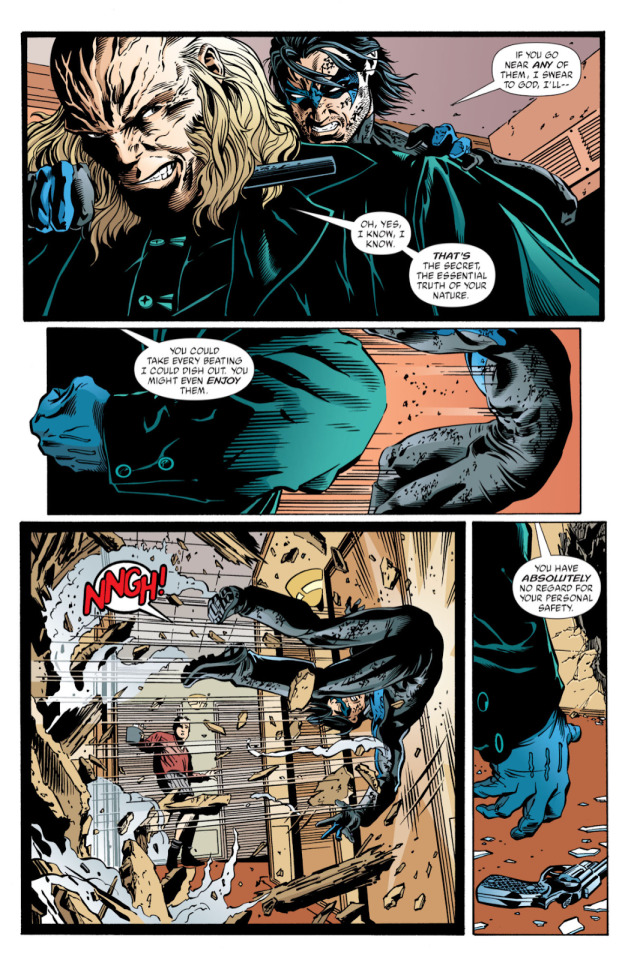

(Grayson, Devin, writer. Zircher, Patch, illustrator. Slow Burn. Nightwing no 93, e-book ed. DC Comics, 2004. pp. 10-11)
Sam Humphries also demonstrated this during his brilliant story, The Untouchable. There, Dick’s relentless determination to save people from the Judge’s machinations grows so intense that it becomes self-destructive. The story demonstrates how Dick’s “goodness” comes from a form of toxic perfectionism that has been with him since he was a child — a perfectionism born of a low self-worth that eats at him from the inside out
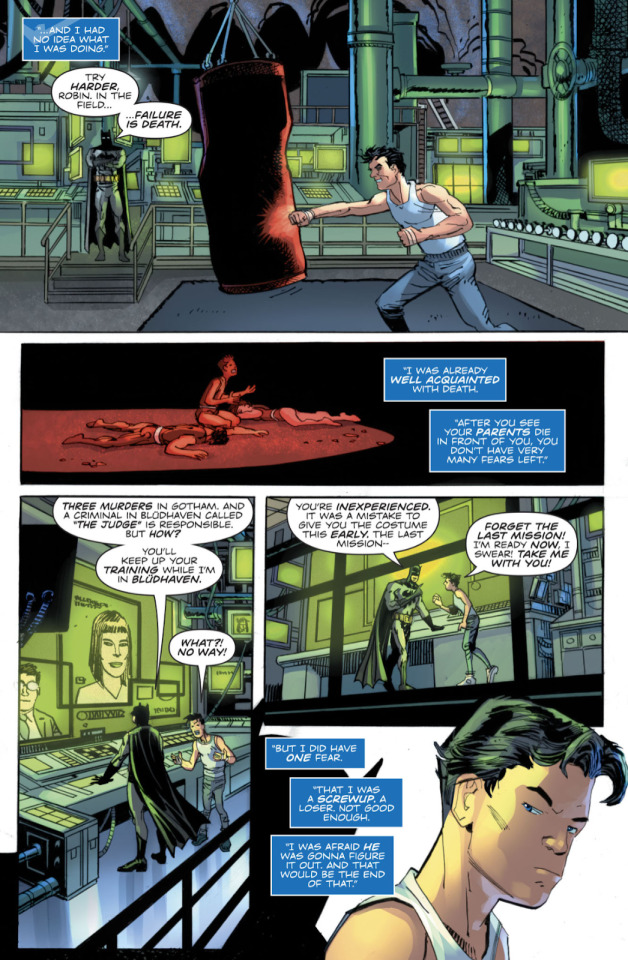
(Humphries, Sam, writer. Janson, Klaus; Campbell, Jamal, illustrators. Ruthless. Nightwing: Rebirth no. 37, e-book ed. DC Comics, 2018. pp. 08)
Even the 2003 animated series Teen Titans understood that in trying to catch the bad guy — almost always Slade Wilson in the case of that show — Dick could sometimes go too far.
Dick’s goodness causes him to see himself as a danger to not just his loved ones, but everyone who stands near him. He carries the world on his shoulders, taking the blame for every tragedy and seeing every death as a personal failure. When pushed to its worst, Dick’s goodness becomes an obsession which pushes others away, leading to isolation as Dick’s entire existence narrows down to accomplishing one specific goal.
It is this reductive characterization of Dick – the idea that his one defining trait is that he is “good” – that leads many to misunderstand the appeal of his character. As I mentioned above, characters are multi-facet, and Dick is no exception. However, the ways in which Dick is multi-facet are very different from the ways in which most characters are multi-facet.
Please do not mistake what I am about to say by claiming these other characters are not complex. Or even that some of them might not subvert popular tropes. What I mean saying is that Dick’s complexity is demonstrated differently than what I believe most people are accustomed to.
For example, everyone knows Bruce Wayne keeps his feelings locked up inside. He compartmentalizes his emotions and his trauma in order to solve the puzzle put ahead of him. But everyone – characters and readers alike – understands Bruce is doing this. Everyone can tell that he is hiding something from others and keeping them at a distance. The reader is always aware of how Bruce’s trauma informs his actions, his interactions, and his thought process.
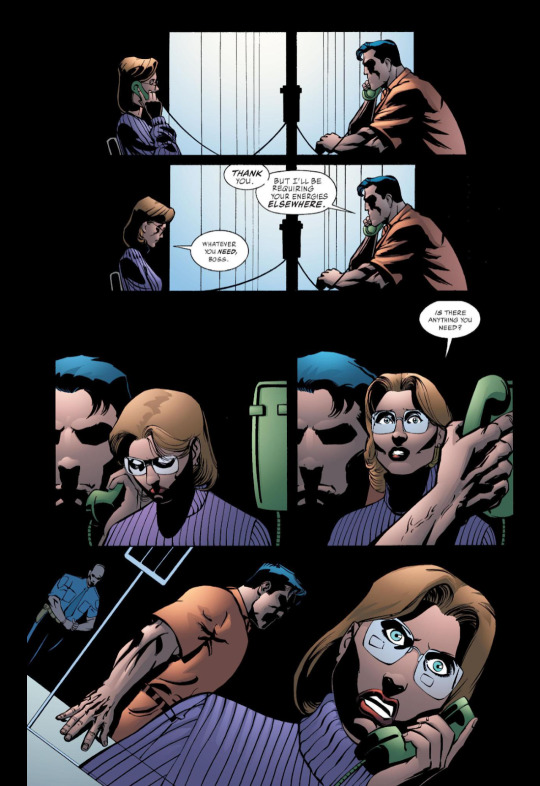
(Grayson, Devin; Barr, Mike W., writers. Davis, Alan; Robinson, Roger, illustrator. Procedure. Batman: Gotham Knights no. 25, e-book ed. DC Comics, 2002. pp. 20)
Take, for instance, Part One of Murderer/Fugitive. Although a major source of tension from the story surrounds the question of Bruce’s innocence, there’s never any question in the minds of the reader and the character that Bruce is hiding something. Tim Drake questions whether Bruce truly did kill Vesper Child and is hiding his motive, while Dick is certain of Bruce’s innocence and instead believes Bruce is hiding his alibi or the clues that would help them find the real murderer. Barbara Gordon, for her part, wavers between the two, but like Tim, Dick, and the reader, she is certain of one thing: Bruce Wayne is hiding something from her, from them… From us.
Similarly, Jason Todd’s anger comes from a place of hurt and a place of love, from insecurities and a need to prove himself. But like Bruce, all of that is clear to see. His anger and his hurt are simple to understand. Please, do not mistake this for me claiming that Jason is not a complex character — instead, I’m stating that his temperament, his trauma, and his actions are so interlinked that they are clear for the reader to see. His character, while rich, is more accessible. It does not take a lot of effort to know that Jason is angry because of what was done to him. It is easy to see that he is hurt because he equates Bruce’s love to the Joker’s death, and therefore sees Bruce’s failure to avenge him “proof” that Bruce does not love him as a son.
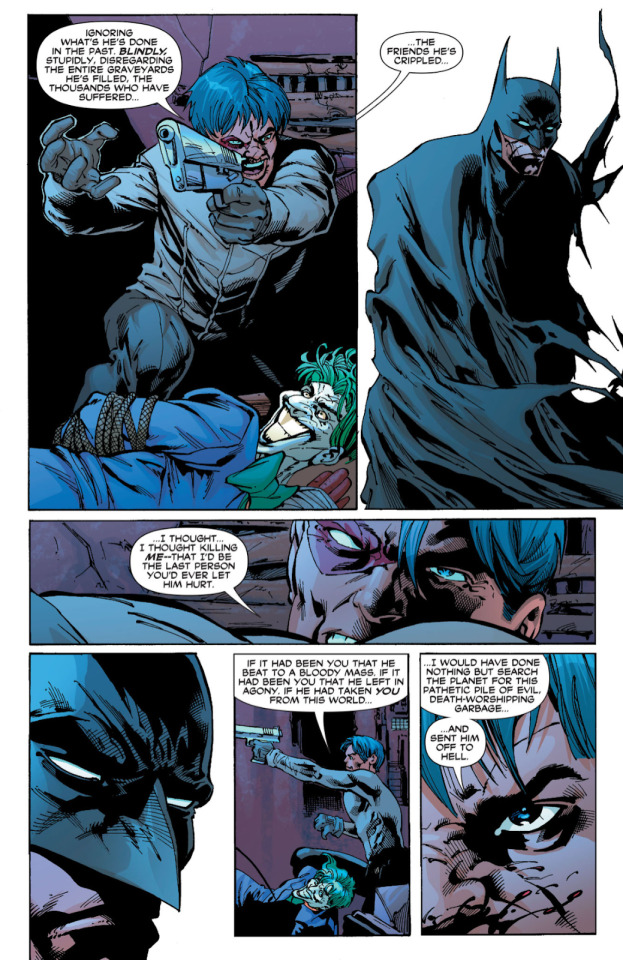
(Winick, Judd, writer. Battle, Eric, illustrator. All They Do is Watch Us Kill: Part 3: It Only Hurts When I Laugh. Batman no. 650, e-book ed. DC Comics, 2006. pp. 13)
Dick, on the other hand, does not wear his emotions, his motivations, or his goals on his sleeve. Dick keeps his secrets not by constructing an impenetrable wall like Bruce, but through misdirection. This is why those who are unfamiliar with Dick misinterpret him so much. They take what is on the surface at face value because they do not have the character history to serve as context to understand what lies beneath
As a Dick Grayson fan (From this moment forward will be referred to as Dick Grayson Fan A) said “good Dick writers teach readers how to read him and bad Dick writers just have that surface level interpretation.” (I was actually talking to her about this idea and how I’m presenting it in this essay. The example I gave was one she suggested after I asked if she could think of good moments that exemplified this idea.)
As an example, we can look at this moment from Grayson, in which Dick sucks a lollipop while receiving a mission assignment. Someone who is not familiar with Dick and is looking at Dick and Helena’s interaction might be easily fooled into thinking that Dick is the pretty, strong, but annoyingly childish and slightly dumb male character who contrasts the serious, intelligent, and highly competent woman. The characters’ expressions, actions, and the onomatopoeias are certainly leaning into that familiar trope.
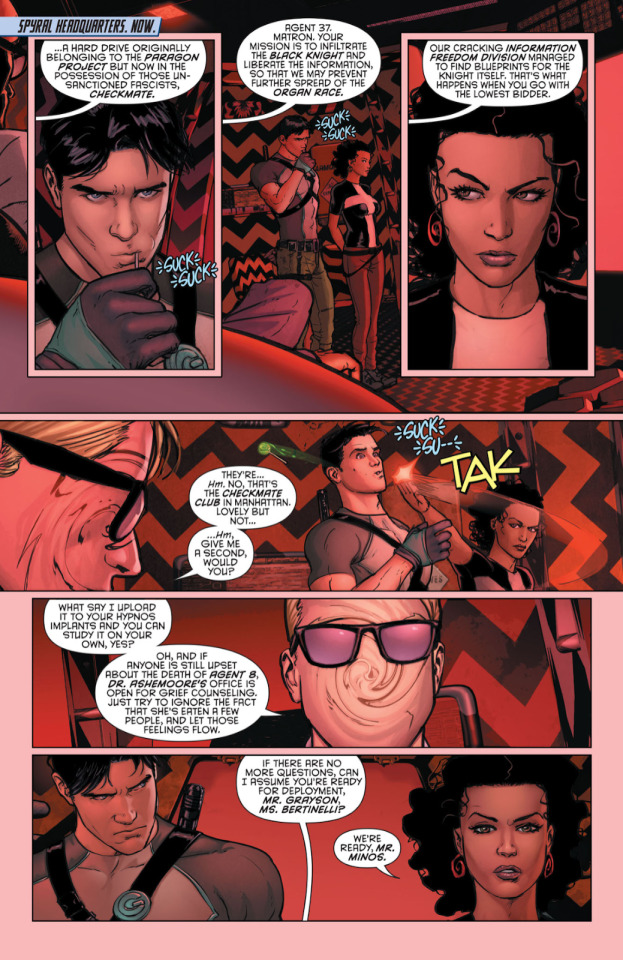
(King, Tom; Seeley, Tim, writers. Janin, Mikel, illustrator. The Raid. Grayson no. 04, e-book ed. DC Comics, 2014. pp. 02)
However, Dick Grayson fans know that when it comes to the mission, Dick is as serious as Batman himself. Highly intelligent, Dick is considered to by many the world’s second greatest detective (there are many instances in canon when he is referred to as such), making him more than just a pretty face who knows how to fight (It should be noted that in this tweet, writer Tom King also ranks Dick as the second best fighter in the Bat Family). Furthermore, context matters. Dick is deep undercover throughout the duration of Grayson, and this scene is set shortly after the death of one of the agents of the organization Dick has infiltrated. In other words, Dick is in a highly stressful situation without allies to provide him with back-up or emotional support.
His posturing in this scene, then, can be seen as an attempt to misguide and misdirect. He does not wish to let those around him – people he is not sure yet if he can trust – know the full extent of his capabilities or perceive any potential weaknesses in his value of human life. Positioning himself as the annoying and childish pretty boy who does not pay much attention to serious matters is a strategic choice that his fans readily pick up on.
That is not to say that Dick’s smiles are all lies. Rather, Dick’s upbeat nature is a natural aspect of his personality that he will exaggerate depending on the setting in order to keep his privacy. He is a natural performer, a showman, and so he utilizes misdirection to his advantage.
A classic example of Dick’s misdirection and how he is misinterpreted by others is how some would characterize him as an “attention seeker.” However, the term “attention seeker” has negative connotations as it implies someone who seeks the spotlight at the expense of others.
That is the opposite of who Dick is. But that’s not Dick is. As a mentor, a leader, and an older brother, Dick will often invite others to join the conversation. He pays attention to what they say, he strategizes based on their needs.
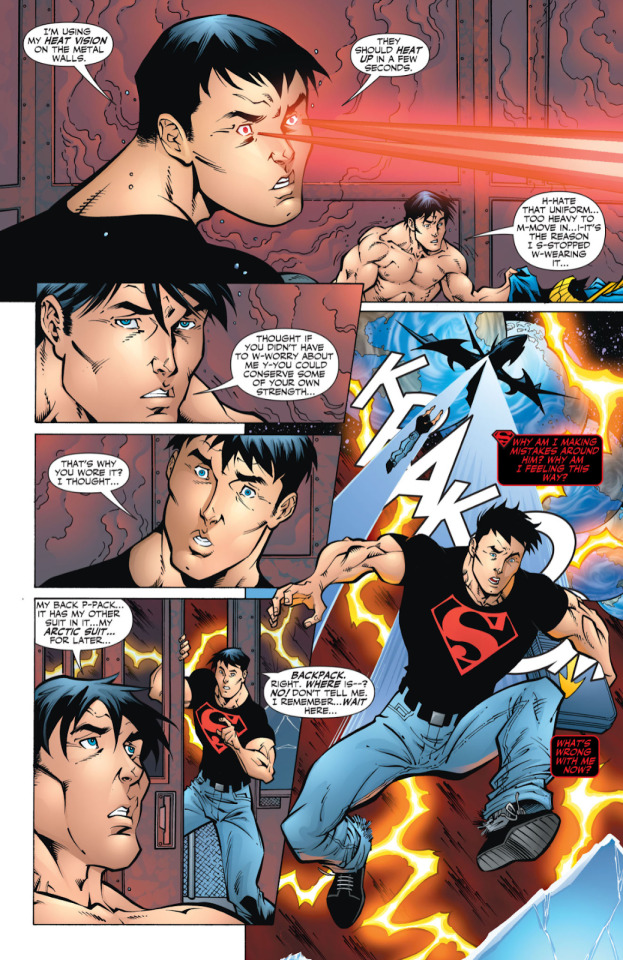
(Johns, Geoff; Wolfman, Marv, writers. Nauck, Todd, illustrator. The Brave and the Bold. Teen Titans no. 33, e-book ed. DC Comics, 2006. pp. 15)
Simply put, Dick is incredibly empathetic and always in tune with those around him. This is why he works so well as both a Bat and a Titan, and why his personality in each team is so distinct. As a Bat, Dick is often portrayed as cheerful, his bad puns are meant to cut the tension, the is the shoulder for his family to cry one; as a Titan, Dick is a leader, he is a strategist, he demands others take things seriously and will not tolerate slacking off, he is trying to instill good work ethics and ensure that the team dynamic stays in top shape.
As JL Bell writes in their essay Success in Stasis: Dick Grayson’s Thirty Years as a Boy Wonder for the book Dick Grayson, Boy Wonder: Scholars and Creators on 75 years of Robin, Nightwing, and Batman explains, “in contrast to how Robin behaved with Batman. [Dick] is usually [the Titans’] serious leader.”
(Bells, JL “Success in Stasis: Dick Grayson’s Thirty Years as a Boy Wonder.”Dick Grayson, Boy Wonder: Scholars and Creators on 75 years of Robin, Nightwing, and Batman edited by Kristen L. Geaman, McFarland & Company, Inc., Publishers, 2015, pp. 22)
That is because Dick knows that when he is with his family, he needs to play one role, and when he is with his friends, he needs to play another. The Bats have their strengths, so Dick adjusts himself to play up on those strengths while also making up for its weakness. Same thing with the Titans.
Mark Waid perfectly exemplifies Dick’s adaptability when portraying him in his World’s Finest (2022) and World’s Finest: Teen Titans (2023). There, Dick brings levity to his work with Batman and Superman, keeping an upbeat attitude while still taking the job seriously.
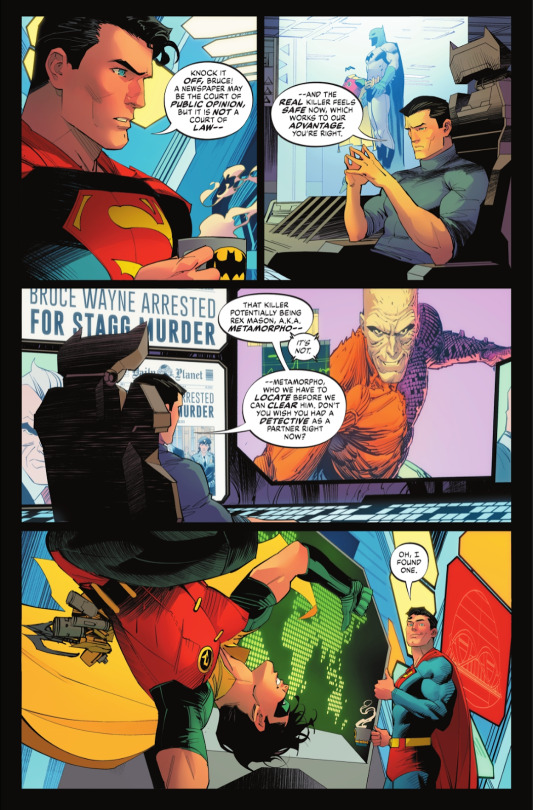
(Waid, Mark, writer. Mora, Dan, illustrator. Manhunt. Batman/Superman: World’s Finest no. 14, e-book ed. DC Comics, 2023. pp. 07)
Yet, when he is with the Titans and feels the weight of leadership on his shoulders, he is more serious, being the one to get the Titans to focus on their objective, getting them to look at the big picture, while also making the most of their abilities as individuals and as a team.

(Waid, Mark, writer. Mora, Dan, illustrator. Team Spirit. Batman/Superman: World’s Finest no. 08, e-book ed. DC Comics, 2022. pp. 05)
So yes, Dick is a performer, a showman, but he is not “attention seeking.” In fact, his use of misdirection illustrates that Dick is a very private person. And how could he not be? While it is true that Dick grew up in the circus, after his parents’ death, he went to live with Bruce, and in doing so, was put into an intense amount of public scrutiny. The murders of John and Mary Grayson happened on a literal stage with dozens of people watching. As a result, Dick’s very private tragedy became a spectacle.
After the death of Dick’s parents, Dick isn’t allowed to disappear into anonymity. He is not afforded privacy to grieve. He is taken in by Bruce Wayne, Gotham’s most famous playboy, billionaire, philanthropic who is also a bit of a selfish airhead (at least, that is how the public perceives him), and as a result, Dick is subjected to an immense amount of public scrutiny, not just from the media, but also from Gotham’s elites, and even his peers at school. Not only that, as Robin, the Boy Wonder and the first ever sidekick, Dick also is put on the spotlight while also being aware of the necessity of keeping secrets.
As a result of having his tragedy broadcasted and having a new mission that requires secrecy, Dick becomes a very private person. He is not an open book; instead, he is meticulous about what he shares and he prevents people from looking at what is not of their business by using his showmanship.
Furthermore, Dick’s role as a performer who, as Joshua R Pangborn describes in his essay about the Robin costume, “experiences […] the full spectrum of emotions, each and every night, for the catharsis of others,” transforms him into a literal vehicle for emotional catharsis and empathy. (Pangborn, Joshua R “Fashioning Himself a Hero: Robin’s Costume and its Role in Shaping His Identity”Dick Grayson, Boy Wonder: Scholars and Creators on 75 years of Robin, Nightwing, and Batman edited by Kristen L. Geaman, McFarland & Company, Inc., Publishers, 2015, pp. 42)
In their essay, Bell argues that while Bruce Wayne embodied “the mid-century ideal of the American male,” who is always “in control of his feelings, not letting them overcome his judgment nor displaying them broadly,” Dick Grayson “can express deep emotions, not only his own but Bruce’s.” As such, Dick often acts as a sounding board for his family, friends, team, and romantic partners. As a performer, Dick embodies whatever persona is necessary to create a safe environment where others can process their emotions and achieve catharsis. (Bells, JL “Success in Stasis: Dick Grayson’s Thirty Years as a Boy Wonder.”Dick Grayson, Boy Wonder: Scholars and Creators on 75 years of Robin, Nightwing, and Batman edited by Kristen L. Geaman, McFarland & Company, Inc., Publishers, 2015, pp. 12)
Dick's performance, then, comes not just from a desire for privacy but also from a deep place of empathy. It comes from a desire to help others work through their own stories. This is why he can step into other's narratives without overshadowing them. In fact, he’ll often elevate those characters by complimenting them and creating the circumstances needed for them to shine. As a performer, Dick is naturally adaptable and always willing to fill the role necessary to create the space required for others to work through their emotional needs.
But, as with everything, Dick’s performance is also a result of his destructive perfectionism. Dick equates “good” to “perfect.” He believes that he can only be wanted by Bruce if he is the perfect Robin, he can only be wanted by his friends if he is the perfect leader, he can only be wanted by his siblings if he is the perfect older brother, he can only be wanted by his partners if he is the perfect boyfriend. As Humphries’s The Untouchable demonstrates, because Dick was raised in an environment where failure could be fatal, he internalized these stakes to every aspect of his life.

(Humphries, Sam, writer. Janson, Klaus; Campbell, Jamal, illustrators. Ruthless. Nightwing: Rebirth no. 37, e-book ed. DC Comics, 2018.pp 20
And it doesn’t help that all of the people in Dick’s life do prove that assertion right. Everyone holds “the Heart of the DCU” to an impossible standard that, when Dick fails to live up to it, he is crucified and punished for it. If he tries to be perfect, he's told off for being the Golden Boy, but if he fails to be the Golden Boy, then he is told off because he let people down when they were relying on him. Ironically, this is done by characters in-universe real-world fans. As Dick Grayson Fan A pointed out in a discussion about depiction of Batman Family members killing their antagonists, “there's always this pressure to have Dick ~fall from grace~ and I do lowkey resent that. Dick should be allowed to be good, not punished for it.”
This creates an environment where Dick constantly needs to maintain perfection in order to be in everyone’s good graces. Failure is not met with understanding and comfort, but with punishment. No one expects him to fail, no one likes when he fails, no one forgives him when he fails. That also means that Dick doesn’t feel safe opening up about his insecurities because to do so would mean “proving” he cannot stay on the pedestal he’s been put on. And so, he is forced to perform the role of a “perfect good guy” by using misdirection so people won’t abandon him for being human (this was said during a very interesting discussion and addressed both canon and fanfic writers. There’s a lot that can be said about Dick’s parentification and how that is viewed in the context of fandom. This is not the essay for it, and, to be perfectly honest, I’m not entirely sure I’m the best person to open said discussion).
Taylor does not portray Dick as someone with this many layers. Taylor’s Dick is perfect simply because he is good. He is the perfect friend, who is always happy to support others. He is Barbara Gordon’s perfect boyfriend. Dick is the perfect older brother, the perfect son, perfect model citizen.
But by equating being “good” with being “perfect” without exploring the negative consequences that come from such pressures, Taylor robs Dick of the emotions that humanize him. In Taylor’s run, a good person will not be angry at their friends, will not be frustrated with their siblings, will never disagree with their romantic partner. This strips Dick of all of his nuances, and instead reduces him to a non-descriptive “everyman hero” with a limited emotional range whose only narrative purpose is to serve as a blank canvas for readers to project themselves into.
Simply put, Taylor is uninterested in writing Dick as a character because he does not see value in Dick for who he is. Nightwing #105, which removes Dick from its story in order to allow its readers to “be Nightwing” illustrates how Taylor and DC at large only value Dick his connections, not for who he is.
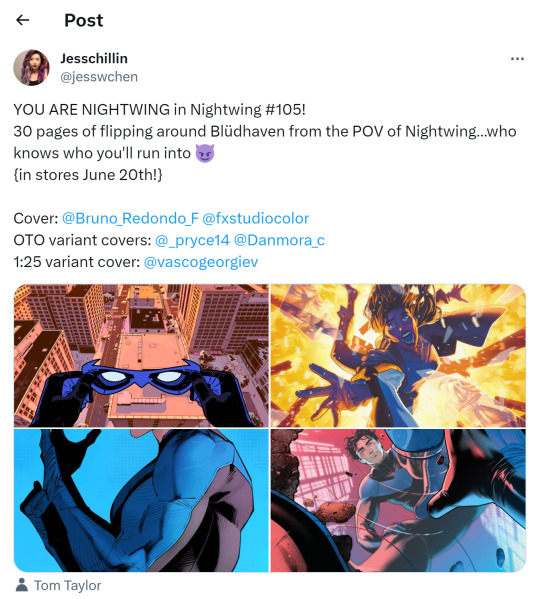
(Chen, Jess [jesswchen]. “Tweet Message.” 18 March 2023, https://twitter.com/jesswchen/status/1636971185782259716?s=20.)
Be Dick, and you can be good friends with Superman! You can be Batman’s son! You can be Batgirl’s boyfriend! Robin’s big brother! Flash’s best friend!
As a Dick Grayson fan, this feels insulting. I’m not saying Dick needs to be anyone’s favorite character, or that anyone even needs to like him. I’m not interested in dictating anyone’s taste. But to someone who loves Dick Grayson, it is insulting to think that those responsible for his stories fail to see his value. To Taylor, the person who, as the writer for both Nightwing and Titans, has the most control over Dick’s portrayal, Dick is nothing but a tool that will soon wear off its use.
In treating Dick as such, Taylor and DC send a clear message to those of who love Dick, and that message is that the things that make Dick special, the things that made us love him, do not matter.
For his near century long existence, Dick served as a stand in for those who feel othered in society. While I do not have the time to go into a gender studies and queer reading of Dick, it is notable that his character often spoke to many people who felt different. As Mary Borsellino’s 2006 essay “A lot like Robin if you close your eyes” Displacement of meaning in the Post-Modern Age explains:
The things which a Robin-like figure can contain, but which are cut off from being embodied by Robin himself, lose none of their importance simply because they are rejected by a restrictive, corporate-controlled status quo […] It's worth inspecting what was excised from Robin, and charting where these elements instead found articulation: in those from lower socioeconomic backgrounds; non-White people; young single parents; and HIV positive people. And, especially, girls and women
(Borsellino, Mary “‘A lot like Robin if you close your eyes.’ Displacement of meaning in the Post-Modern Age, 2006)
While Borsellio’s essay focuses on the Robin mantle, as the creator of said mantle, such assertions can also be applied to Dick. In fact, Bell concurs with the idea that those who were othered have always took a preference to Dick when stating that “Robin’s status as the littlest guy in the fight increases the character’s appeal for some children, especially the ‘youngest and weakest.’” In other words, it is crucial to Dick’s character that he is not an “everyman hero.” He is not the hero of or beloved by the average individual, but rather by those who were ostracized by society.
Taylor’s writing exemplifies the “restrictive, corporate-controlled status quo” imposed by DC that Borsellino speaks of. His characterization is the manufactured image that removes Dick’s “socially deviant/rejected” qualities his fans loved about him so that he can be palatable to a more mainstream audience.
(Bells, JL “Success in Stasis: Dick Grayson’s Thirty Years as a Boy Wonder.”Dick Grayson, Boy Wonder: Scholars and Creators on 75 years of Robin, Nightwing, and Batman edited by Kristen L. Geaman, McFarland & Company, Inc., Publishers, 2015, pp. 11)
This, of course, is not necessarily new. As Mason Downey argues in their 2015 essay In Defense of Dick Grayson: Objectification, Sexuality, and Subtext, DC has often struggled between leaning into the audience Dick has and wanting to erase any “othering” elements from his character. As they point out:
The more sexual and idealized Dick was allowed to become, the more attention he got from female and queer fans, the more the industry had to work to combat the past anxieties revolving around the character. This resulted in more and more heteronormative romances for Dick on the page. We can’t grant Wertham’s fears any legitimacy, we can’t make these stories “for girls.”
Writers did so in a few ways, some obvious, some less so. On the page, we had Dick’s deflection of female sexuality that he was not in control of, and we had a level of emotional posturing with relationships he was in control of. We had moments where we saw him manipulating with or being manipulated by sex.
There were editorial pushes to lean into Dick’s popularity with women and queer men coupled with the simultaneous desire to not acknowledge or grant legitimacy to the fanbase he found in those demographics. This translated to more sexualized poses. More pin-up style spreads. Multiple bait-and-switch wedding, marriage, and relationship teases which turned out to be fakeouts or got written out. Long strings of female side characters were introduced exclusively to be love interests.
Off the page, we had more concrete examples. We saw a lack of merchandise and lack of representation of him in other forms of media. There was a pervasive hesitancy in broaching his existence outside of the spheres of already established fans. For example, Nolan’s The Dark Knight Rises featured Joseph Gordon-Levitt playing a character literally named Robin, who was invented for the film franchise rather than allowing Dick himself to exist in that cinematic universe.
Dick Grayson is a character built upon one repeated mantra aimed at what eventually become two of his largest demographics, “Remember, this is not for you.”
(Downey, Mason “In Defense of Dick Grayson: Objectification, Sexuality, and Subtext” Women Write About Comics. December 2015)
What makes Taylor’s run unique is that in trying to have Dick tackle social issues such as homelessness and in trying to create a class commentary, Taylor attempts to create a progressive, albeit simplistic, veneer while erasing the important and “other-ing” aspects of Dick’s character that was so beloved by his fans.
This, I believe, is one of the many explanations why many of those who praise Taylor run claim that this is the first Nightwing run they ever enjoyed, while many (though admittedly, not all) those who have been longtime Dick Grayson fans feel betrayed and frustrated by the way their beloved character is being handled. Dick is currently being appropriated into a more mainstream, palatable hero. He is being taken from those who loved him and being scrubbed clean to be suitable for an audience who could not appreciate him for what he was, only for how his connections could give them a wish fulfillment fantasy. As another Dick Grayson fan expressed:
I see no heart in [Taylor’s] work, only soulless marketing. He sells himself as something good and work on his perfect public image and everyone who disagrees is wrong and it gets on my nerves like nothing else. […] I wouldn't be as salt[y] if Taylor was genuinely trying to writing something good. I don't have the heart to [be salty] at someone working with passion, even if I don't like it.
(Henceforth referred to as Dick Grayson Fan B... This was actually said during a discussion in which we expressed how we wish we could be as excited about Taylor’s run as many others are.)
136 notes
·
View notes
Text
A (Negative) Review of Tom Taylor's Nightwing Run - What Went Wrong? Barbara Gordon
Introduction
Who is Dick Grayson?
What Went Wrong? Dick's Characterization
What Went Wrong? Barbara Gordon
What Went Wrong? Bludhaven (Part 1, Part 2)
What Went Wrong? Melinda Lin Grayson
What Went Wrong? Bea Bennett
What Went Wrong? Villains
Conclusion
Bibliography
Out of this entire essay, this was the section that I considered cutting entirely. After all, in the past there have been instances when Barbara Gordon and her romance with Dick Grayson have been weaponized by Taylor and his fans against his critics.
The example that comes to mind was when Taylor and Redondo were criticized for not including Duke in a Nightwing cover that parodied The Brady Bunch.
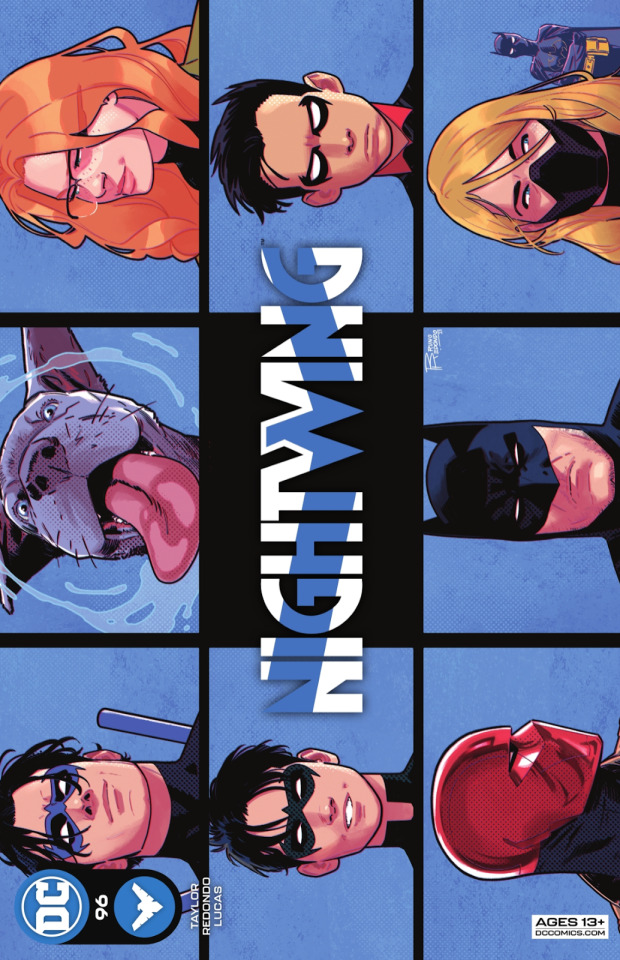
(Taylor, Tom, writer. Redondo, Bruno, illustrator. Battle for Bludhaven’s Heart Finale. Nightwing: Rebirth. 96, e-book ed. DC Comics, 2022)
Personally, I believe that, while discussions of how Duke’s positioning in the Bat Family is warranted, the matter was blown out of proportion, and many of the attempts to cancel Taylor crossed the line into harassment (make no mistake, while I believe him to be a terrible writer, I do not wish him any ill-will). That being said, Taylor also escalated the matters when attempting to pin said negative comments onto DickKory shippers who did not like that he wrote DickBabs.
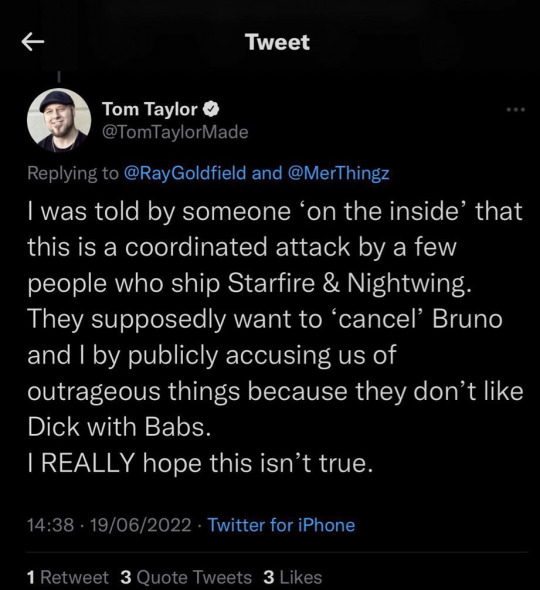
(While the original Tweet has since been deleted, the screenshot used is available in this tweet
Neb | 🏳️🌈 [@NebsGoodTakes]. Twitter, 20 June 2022, https://twitter.com/NebsGoodTakes/status/1538939571789934593)
For this reason and this reason alone, I considered removing this part of the essay. While I have no idea if anyone will read this monstrosity, I did not want my arguments to be invalidated simply because I did not have a favorable opinion on the DickBabs.
However, after much consideration and numerous discussions with other Dick Grayson fans, I found that the subject of Barbara Gordon’s portrayal in this run (as well as in many recent DC media), and her romance with Dick perfectly embodies many of ideas I wish to explore in this essay — mainly, how shallow approaches to progress ideals create deeply problematic narratives that not only undermines the themes of a story, but they also destroy characterization.
I will start by once again stating that I do not believe this is a problem unique to Taylor’s writing. As I alluded to above, I believe DC’s modern portrayal of Babs does a great disservice to her wonderful, empowering, complex character. This is but the analysis of one of the stories she appears in. It is my hope to prove that in Taylor’s Nightwing, Barbara Gordon is not written as a woman with a strong sense of self and an internal life, but rather idealized girl whose existence revolves around the men in her life, and whose perfect yet shimmering depiction serves only to make her into the reader’s proxy-girlriend.
Barbara Gordon in the late 90s and early 2000s was a mature and confident woman in her late-20s to early-30s. She had her own job, her own friends, team, villains, and the type of confidence that can only come with age and experience. She was serious while still having a sense of humor, pragmatic, and she knew exactly what she wanted for herself.
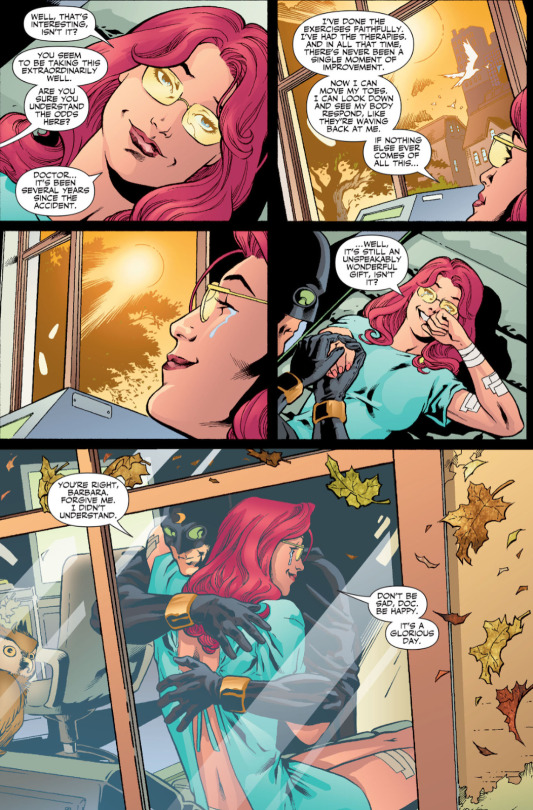
(Gail, Simone, writer. Bennett, Joe; Barrows, Eddy, illustrator. Perfect Pitch: Part One. Birds of Prey. 87, e-book ed. DC Comics, 2005. pp. 22)
She was also flawed. She could get angry at people for little reason, she could be too cold or too straightforward without considering the other person’s feelings, she could be purposefully petty and selfish, she could get unreasonably jealous, she was impatient, she could be too proud to admit when she was wrong. It was all of these factors which allowed Barbara Gordon to be her own person — to be a fleshed out, well-rounded woman.
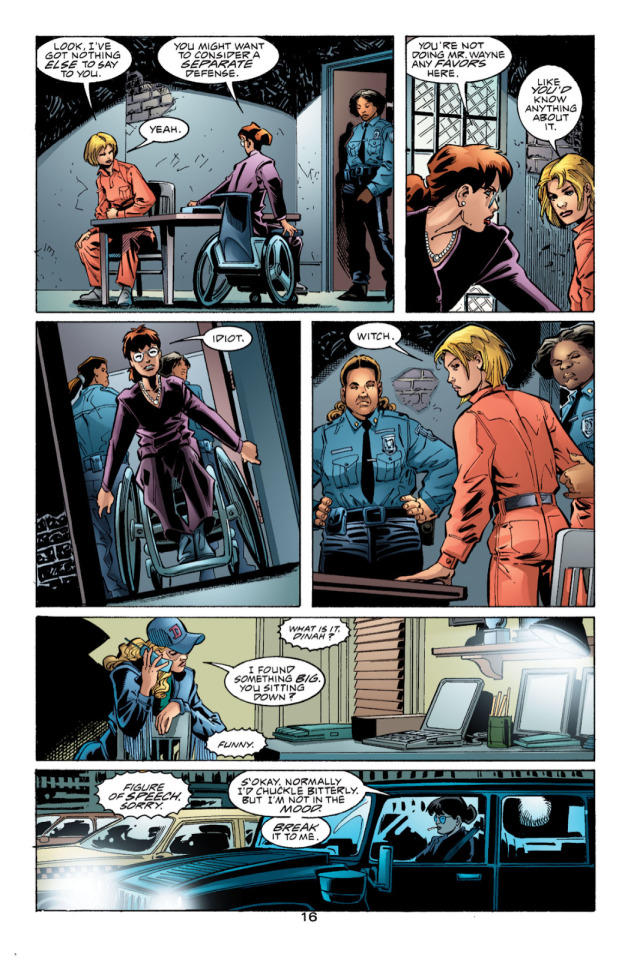
(Dixon, Chuck, writer. Leonardi, Rick, illustrator. The Gun. Birds of Prey. 39, e-book ed. DC Comics, 2002. pp. 16)
Babs’ life did not revolve around Dick. Yes, she loved him, but she still had some interiority. She had a life outside of Dick Grayson, outside of Bludhaven, outside of Batman, and outside of Oracle. She had her own goals, her own dreams, her own likes and dislikes that worked independently of the men around her. She had her own history that informed her decisions, she had both positive and negative relationships with other women and those relationships were not dependent on her connections with Dick or Bruce.

(Gail, Simone, writer. Timm, Bruce; Lopez, David; Melo, Adriana, illustrators. A Wakeful Time. Birds of Prey. 86, e-book ed. DC Comics, 2005. pp. 02)
By comparison, Taylor’s Barbara is not a woman, but a girl. She is very young and very immature. If Dick is written like a young man who just left home and is experiencing adulthood for the first time, then Babs is written as his girlfriend who is still in college and does not have concrete plans for her future.
Note that when referring to Taylor’s Babs, I mainly characterize her through her relationship with Dick. That was intentional. While writing this essay, I struggled to think of Barbara having any meaningful interactions with characters who were not Dick or Dick’s friends, the Titans. I also struggled to think of her doing something for herself rather than for Dick and the Titans. I struggled to define her goals independent of Dick, I struggled to describe the plans she has for her future that do not revolve around her relationship with Dick, and I struggled to give an account of what she does in her spare time when she is not helping Dick, Nightwing, the Titans, or Batman. That is because everything in Barbara Gordon’s life, as written by Taylor, is constructed around Dick (As many may know, it is really hard to prove a negative. How can I get supporting evidence from the comics that Babs does not have a life outside of Dick Grayson when my argument comes from those factors not existing? For this, though I hate to do so, I’m afraid I’ll have to rely on the reader’s familiarity with the run being discussed).
Barbara is a constant presence in Taylor’s Nightwing run. She is a secondary protagonist, and she is often portraying helping Dick Grayson behind the scenes,

(Taylor, Tom, illustrator. Redondo, Bruno The Battle for Bludhaven’s Heart Part Two. Nightwing: Rebirth. 93, e-book ed. DC Comics, 2022 pp)
Helping Nightwing as Oracle,
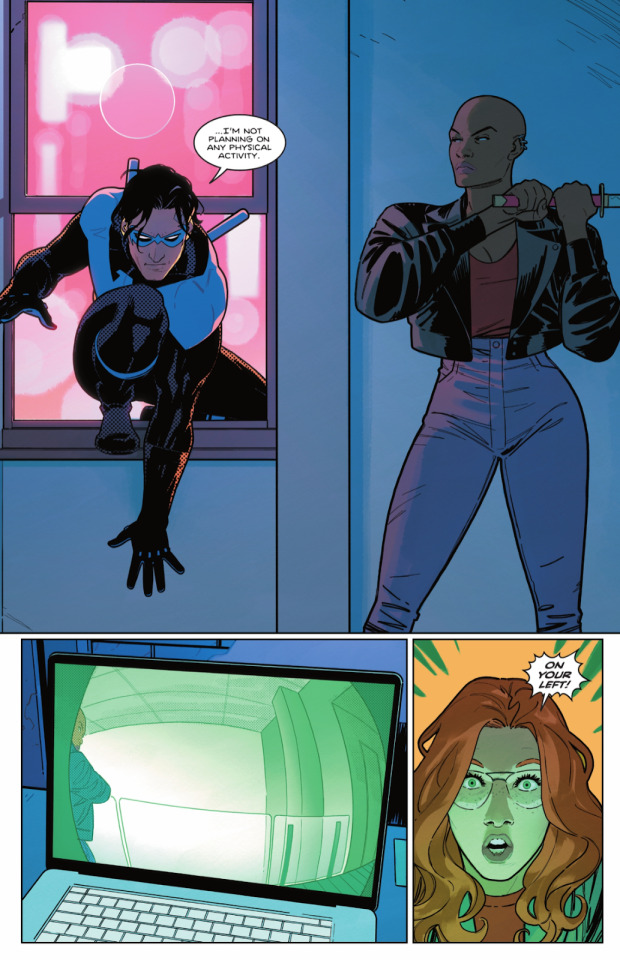
(Taylor, Tom, writer. Redondo, Bruno, illustrator Leaping into the Light Part 4. Nightwing: Rebirth. 81, e-book ed. DC Comics, 2021. pp 19)
Or fighting by Nightwing’s side as Batgirl.

(Taylor, Tom, writer. Redondo, Bruno, illustrator. You are Nightwing. Nightwing: Rebirth. 105, e-book ed. DC Comics, 2023. pp. 05)
She is always present, she is always doing something… But all of that is in the service of the men around her rather than for herself.
As Dick Grayson Fan A pointed out during a discussion, “Modern Babsgirl is forced to be perfect at everything. She's never allowed postcrisis Babs' edges, her flaws and intrinsic motivations. Taylor's Babsgirl is designed to be the perfect girlfriend for his blank self insert Nightwing. There's no meat to her bones, she's just shimmer and gloss.” (The subject of Babs came up when DC announced the lineup for Birds of Prey (2023) and Babs was not included on the roster.)
In other words, Babs as portrayed in Taylor’s run lacks any bite, edge, and maturity that would make her feel like a woman with her own sense of self and with a life that is not dependent on her boyfriend. Babs’ portrayal is a shallow girlboss-type of feminism, where though Babs is powerful and intelligent, she is not allowed to be a real person for she serves no purpose other than to be the perfect, understanding, badass girlfriend.
As a result, Dick and Barbara’s relationship becomes hollow. Because Babs lacks interiority, individuality, and agency, she becomes a flat character. This, in turn, makes it so it is hard to understand why Dick and Barbara are together other than for the fact that DC mandates it. The over reliance on the childhood friends-to-lovers trope only increases this hollowness rather than fleshing out their relationship. While Taylor includes flashbacks of Dick and Babs as friends when children, growing up together as teenagers, and fighting together as Robin and Batgirl, those instances feel removed from their individual histories. These moments exist in isolation, removed from the context of the rest of their lives, be it together or separately.
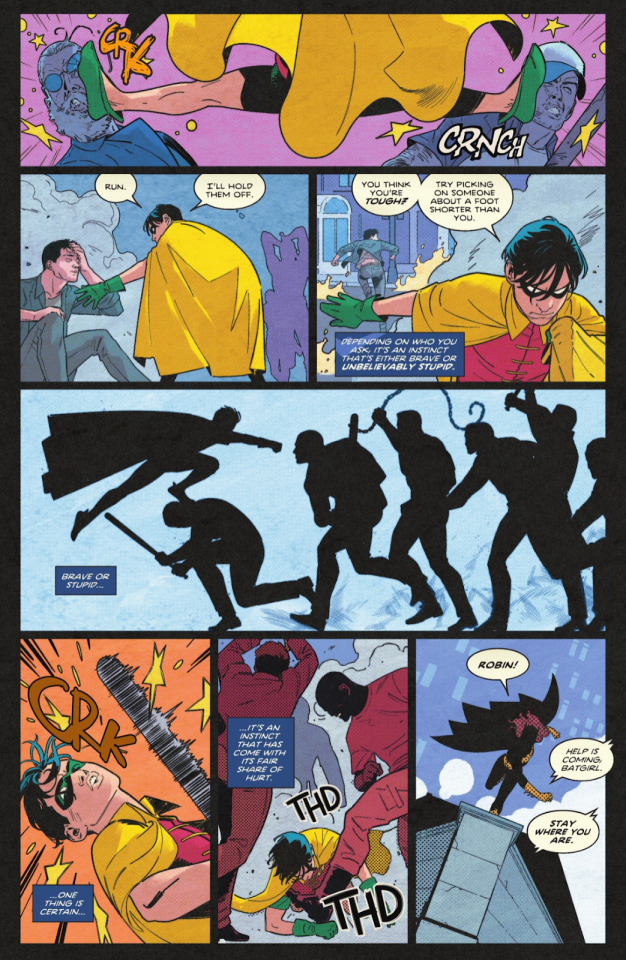
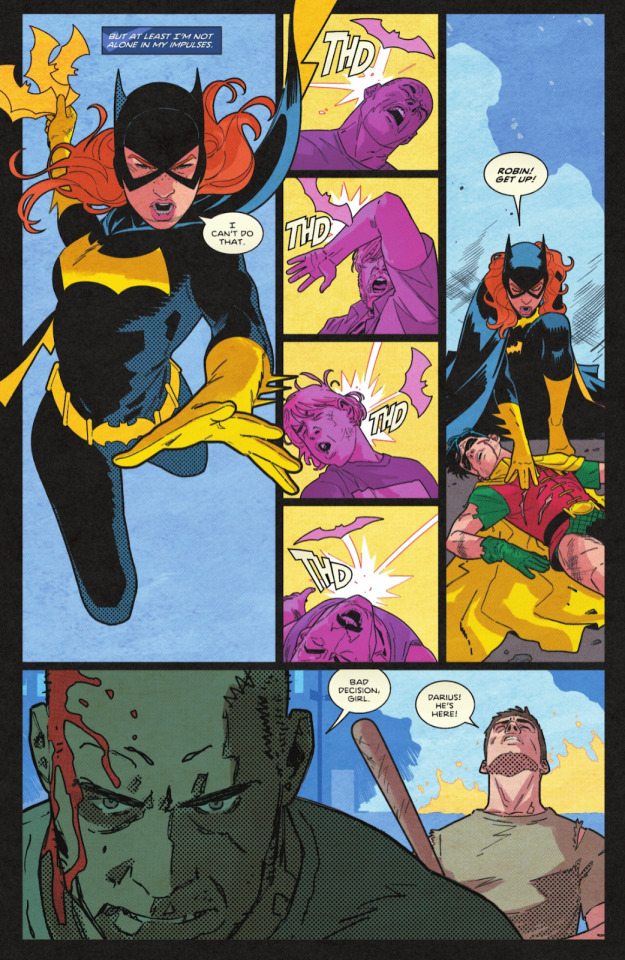
(Taylor, Tom, writer. Redondo, Bruno, illustrator The Battle for Bludhaven’s Heart. Nightwing: Rebirth. 92, e-book ed. DC Comics, 2022. pp 06 - 07)
DC currently treats Dick and Babs as a foregone conclusion. As a result, Taylor does not make an effort to get his readers on board with the relationship because he assumes that they should already support it. Dick and Babs are portrayed as getting along great, never having had any conflict, tension, or disagreements. This idealized romance would not necessarily be a problem if it didn’t come at the expense of developing Dick and Barbara as individuals outside of their relationship. They are not one being, but two separate people coming together. They should be written as such, but in trying to create the perfect relationship, Taylor robs Dick and Babs of their identity outside of their romance.
Not only does this inseparability that Taylor attempts to portray as “charming” destroy Dick and Babs’ individuality, it can also be downright insulting. In #106 Taylor infantilizes Dick when making it so Babs needs to be the one to wake him up so he can start his work as Nightwing.
As I mentioned previously, Dick is known for his toxic perfectionism, his obsessive tendencies that often come at the cost of his health. Making Dick laze around in bed while people need his help and having his girlfriend tell him to get ready for the day, as if she was his mother and he was a teenager who did not want to go to school in the morning, is not only out of character, it also diminishes Dick’s competence. It makes it seem like he cannot function as a responsible adult without Babs being there to hold his hand through everyday difficulties.
Not only that, the scene also plays into incredibly sexist dynamics where women are expected to carry the domestic labor in a relationship — the man cannot keep track of his own schedule, and so it becomes the woman’s responsibility to attend to his needs. What was intended to be a “cute” scene portrays Dick as being immature and irresponsible, and portrays Babs spend her time keeping track of an adult man’s responsibilities.
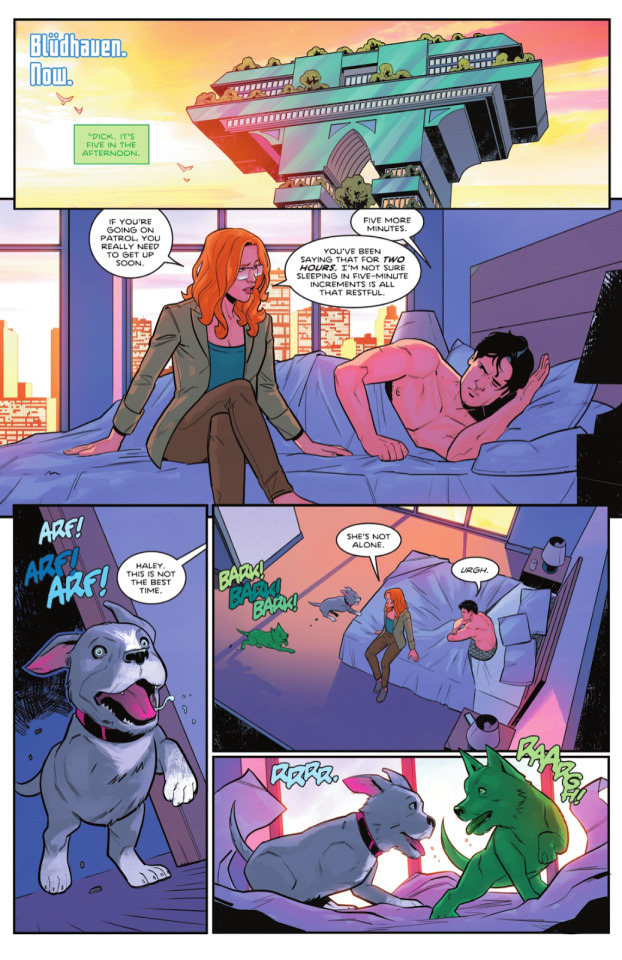
(Taylor, Tom, writer. Byrne, Stephen, illustrator. The Crew of the Crossed Part One. Nightwing: Rebirth. 106, e-book ed. DC Comics, 2023. pp 08)
This unhealthy codependency further insults Dick when, in #107, Babs demands Dick come back home as he is about to help his ex, Bea. Rather than believing Dick’s capability as a vigilante who has been operating in the field for far longer than she has, Babs shows her complete lack of faith in Dick’s ability to get anything done by himself by telling him that she “wants him home now.”

(Taylor, Tom; Byrne, Stephen The Crew of the Crossed Part Two. Nightwing: Rebirth. 107 e-book ed. DC Comics, 2023. pp. 19)
This is a great contrast to Nightwing (1996) #66, where Babs encouraged Dick’s independence and had full trust in his abilities to take on such difficult challenges on his own. When Lockhaven goes up in flames, Babs trusts Dick to be able to handle the situation by himself, even though she also knows that Dick’s mind is greatly preoccupied with Bruce and the murder of Vesper Fairchild. Indeed, in the next issue (not part of Murderer/Fugitive, but happening simultaneously to it), Dick does handle the Lockhaven fire by himself, without requiring any assistance, before returning to Gotham to help with the investigation that should clear Bruce’s name.
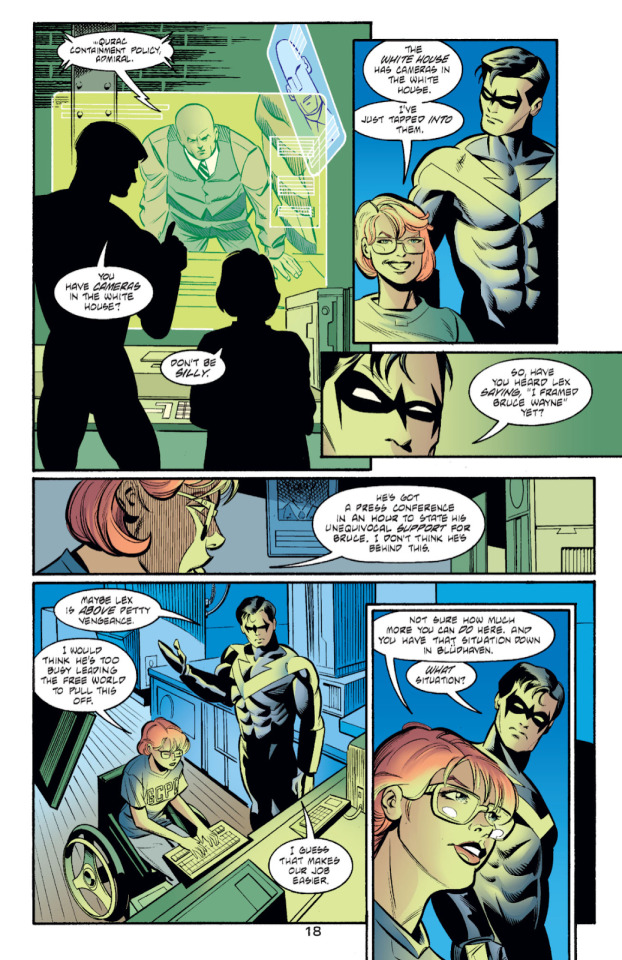

(Dixon, Chuck, writer. Burchett, Rick, illustrator. The Unusual Suspects. Nightwing. 66, e-book ed. DC Comics, 2002. pp 18 - 19)
This healthy separation and this unconditional trust not only portrayed Dick and Babs as both trusting each other’s abilities as heroes — Dick did not worry about Babs’ capability of taking care of herself, and Babs knew Dick could handle his own — it also portrayed them as being more secure in their relationship. They were individuals first. They had their own independent lives and personalities outside of their romance. They trusted the other’s ability to win on their own and handle their own cases without help. And that, in turn, made it so that they could stand on their own, and so that their relationship did not feel so vulnerable.
That being said, it wasn’t as if previous depictions of Dick and Babs didn’t present them with hardships, or demonstrated how, at times, they could bring out the worst in each other. As much as they could compliment one another, Dick and Babs could also disagree, get into arguments, and even fights. That is because they were individuals first, with their own opinions, preferred way of doing things, and their own background that would sometimes come in conflict.
Taylor avoids having meaningful conflicts in his story. While this negatively affects his narrative in a myriad of ways, the lack of the conflict in the plot also affects the relationship between Dick and Babs. It is fine to have a wholesome, sweet romance, so long as it is balanced with a plot containing other forms of tension. This way, the relationship can be a safe harbor for the main characters, the one space in their lives where they can be safe, and the one source of strength they can draw upon when facing the challenges ahead. By balancing a conflict-filled plot with a wholesome romance, the stakes of the plot feel higher while the romance feels sweeter. They foil one another to create a cohesive and unified story.
In Taylor’s Nightwing, all major plot beats take a backseat to the sitcom-like relationship between Dick and Babs. The lack of conflict in the plot and the lack of conflict in the romance makes it so everything is stagnant.
I do believe that Taylor thought he was writing a “Will-they-won’t-they” style romance in the beginning of his run. In Nightwing #95, for example, Batwoman implies that the reason Dick and Babs aren’t together is because Dick and Babs are scared of crossing that line.
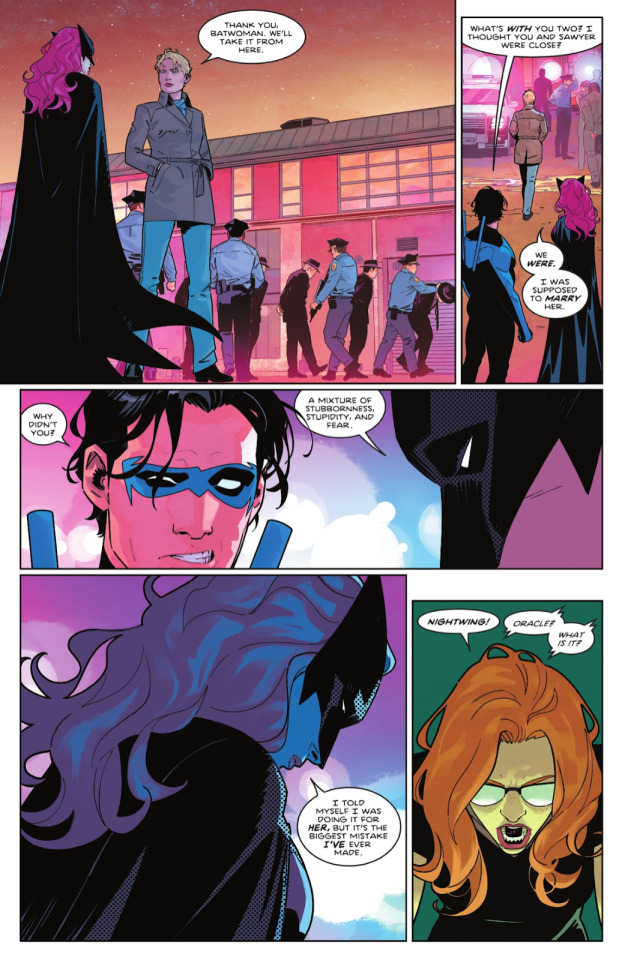
(Taylor, Tom, writer. Redondo, Bruno The Battle for Bludhaven’s Heart Part Four. Nightwing: Rebirth. 95, e-book ed. DC Comics, 2022. pp 17)
Wally also played into that idea when, in #91, he pointed out that Dick and Babs were already together and just needed to make it official.

(Taylor, Tom, writer. Redondo, Bruno, illustrator. Get Grayson Act Three. Nightwing: Rebirth. 91, e-book ed. DC Comics, 2022. pp 19)
More than that, I believe Taylor attempted to make a commentary on comics imposing needless conflicts in relationships to keep two characters apart. In Taylor’s view, Dick and Babs were always in love, always meant to be together, and never had a complicated history that prevented them from rekindling their romance when Dick is trying to regain some control over his life after recovering his memories. This shows a lack of understanding as to why Dick and Babs often break up and does a disservice to both their characters.
Now, to explain this, I’ll borrow heavily from a private discussion I had with a Dick Grayson Fan A once distinguishing the difference between external and internal conflicts in a romantic plot. While we were not talking Dick and Barbara then, much of what we said still applies to their relationship.
External conflicts, as the name suggests, involve external forces that keep the couple from being able to develop their relationship despite their mutual feelings for each other. This is the case with a romance like Clark and Lois. Given Babs’ laugh at Dick’s condescendingly sexist claim that Babs shouldn’t be with him because it is too dangerous (as if he doesn’t know very well that Babs can easily take care of herself), it seemed that Taylor believed that this was the conflict that has been keeping Dick and Babs apart. And so, with one panel, he dismissed the idea that external forces could keep Dick and Babs apart because they are able to face their enemies together.
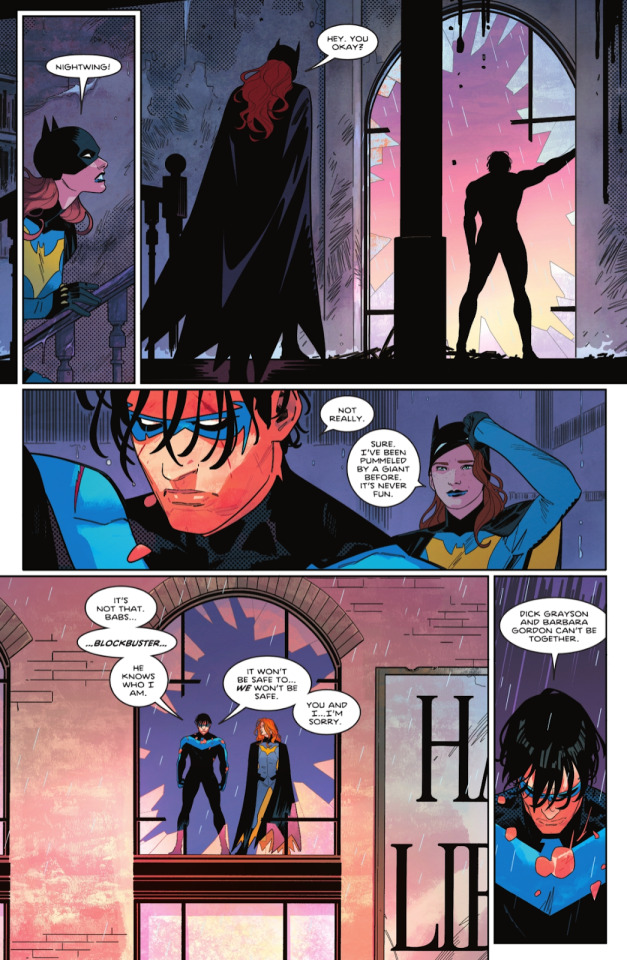
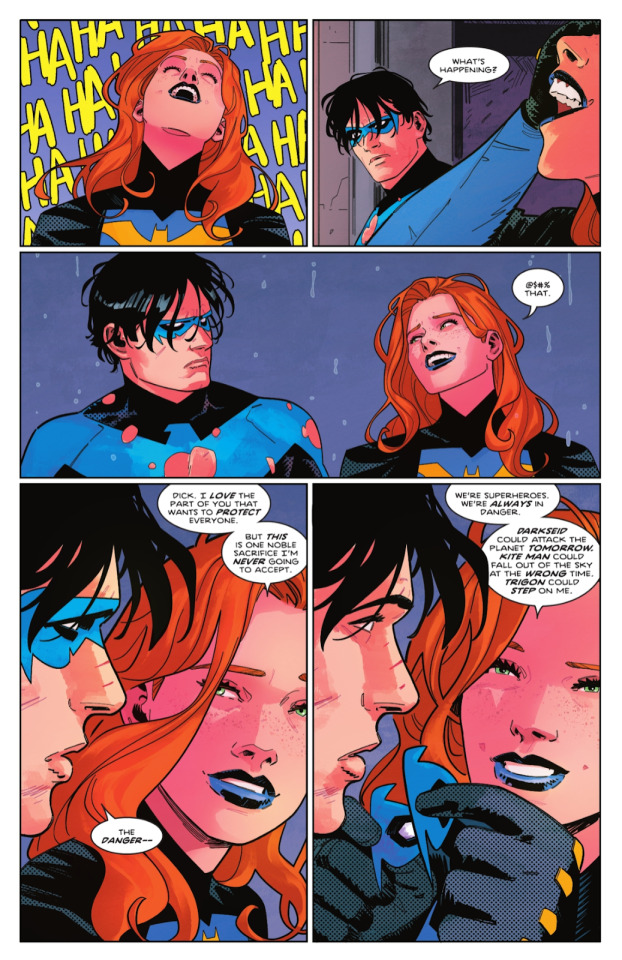
(Taylor, Tom, writer. Redondo, Bruno, illustrator Battle for Bludhaven’s Heart Finale. Nightwing: Rebirth. 96, e-book ed. DC Comics, 2022. pp. 17 - 18)
But in the past, what broke Dick and Babs up were not external conflicts, but internal ones. If external conflicts are created due to external forces, internal conflicts preventing a couple from being together come from the characters not yet being who they need to be in order to be happy together. This can be due to a clash of personalities, worldviews, needs, wants, or goals. To prove my point, I want to look at Dick and Bab’s break up in Nightwing (1996) #87 and the Nightwing Annual #02. (I’ll be honest in saying that it pains me to cite Nightwing Annual #02 in this essay, for I absolutely detest it. I believe Dick is written incredibly out of character and it, quite frankly, captures one of my major problems with how some writers choose to depict DickBabs. In trying to prop Babs up, Dick gets knocked down and ridiculed, and often burdened with the full responsibility as to why Dick and Babs haven’t been able to get together due to timing and Dick’s immaturity. As such, writers make it so Dick and Dick alone must change in order to become a partner worthy of Babs. They greatly mischaracterize him, fault the failures of Dick and Babs’ relationships on those mischaracterizations, and then portray Babs as the patient woman waiting for her immature soulmate to grow up. This is both an insult to Dick’s character and a propagation of sexist tropes where a woman must put her life on hold in order for the man to “catch up” to her maturely. Not only that, it unfairly requires that only one party makes changes for another. It is not Dick and Babs that must change for each other, but Dick who must change for Babs.)
Just as Taylor uses Dick and Babs’ shared history to bring them together, their breakup explores how shared history can make being together so difficult.
In Devin Grayson’s run, their shared history can be painful to Babs. Not because she doesn’t look back on their time growing up together fondly, but because it was such a happy time in her life that it makes her feel bitter about what she lost. While she is incredible as Oracle, she is still frustrated that she can't be Batgirl anymore. The past, no matter how good, is a reminder of what she can no longer be, and Babs wants to move forward. So Dick bringing up their time as Robin and Batgirl, however fondly, is painful for it makes her feel like they are stuck in the past they shared rather than moving forward together.


(Grayson, Devin, writer. Zitcher, Path, illustrator The Calm Before. Nightwing. 86, e-book ed. DC Comics, 2003. pp 21 - 22)
But to Dick, the past you share with someone is what makes your relationship in the present special. The past informs the present and the future. Dick, much like Bruce, doesn’t move forward by disconnecting himself from the past. His parents are part of his past. So is Robin. His childhood with Bruce. The past is something good to Dick, even when it's also so filled with pain. Dick is not shackled by his past the way Bruce is because he does not see it as something that needs to hold him back. You can move forward while still embracing who you once were and honoring the legacy you carry on your shoulders. The past informed who Dick is now, the relationships he has, and the person he wants to be. The past is where much of what he loves exists. So when he brings up their shared history when talking to Babs, he is not doing it because he loved Batgirl but cannot love Oracle, and he is not doing so because he is just focused on who they were then and not who they are now; he does it it's because to Dick, there's no such distinction between Batgirl and Oracle. They are both Babs, and he loves both of them.
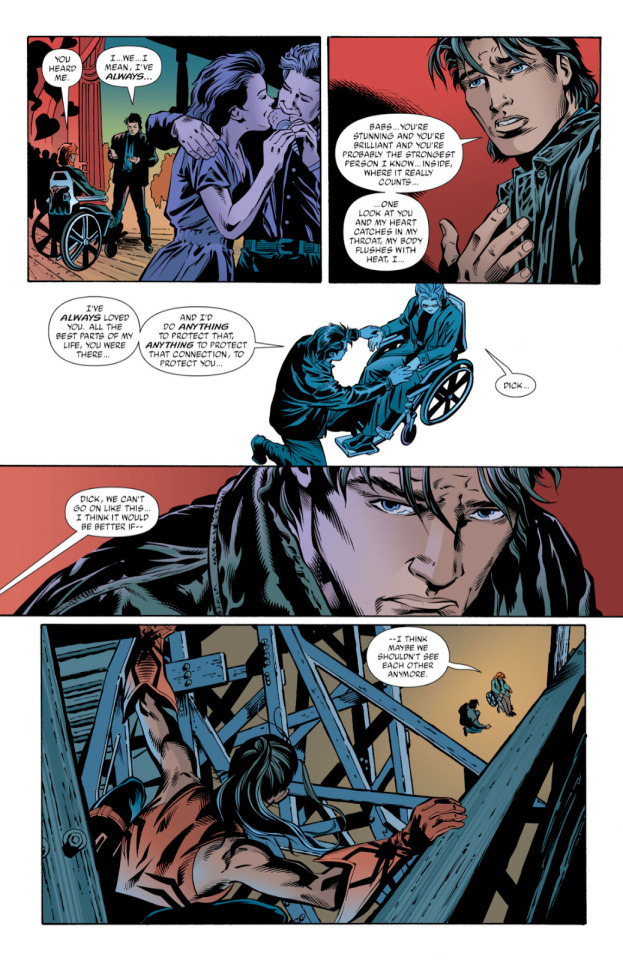
(Grayson, Devin, writer. Zitcher, Patch, illustrator. Snowball. Nightwing. 87, e-book ed. DC Comics, 2003. pp 16)
The way Babs copes with trauma is by divorcing herself from the hurt, by letting go of who she was and embracing who she wants to be. Dick, on the other hand, merges who he was then with who he is now. He doesn't see those people as separate entities, but rather as extensions of him. And that makes sense when you consider that Babs' main trauma relates to something that was taken away from her, and for Dick, the only way he can remain connected to his parents is through the past. It's a great example of incompatibility. Neither one is "at fault" for how they view this issue, neither of them is more correct than the other. They are just different. They care for each other, but the way they understand and interact with the world prevents them from being happy together at this moment. For that to work, internal change is needed.
In portraying Dick and Barbara as complex individuals first, who have different attitudes towards looking back at the past and looking forward to the future, Grayson managed to make their relationship feel real. There’s a weight to their breakup, you can see why they care for each other and why this decision is painful and not taken lightly. They love each other, but they are not in a place where they can be themselves and be happy together yet. It is not danger that keeps them apart — it is the very same differences which they admire most about each other which pushes them away.
In Nightwing Annual #02, we see other reasons why Dick and Babs failed to come together so often. These included Babs being scared of Dick eventually leaving her due to tensions between Dick and Bruce

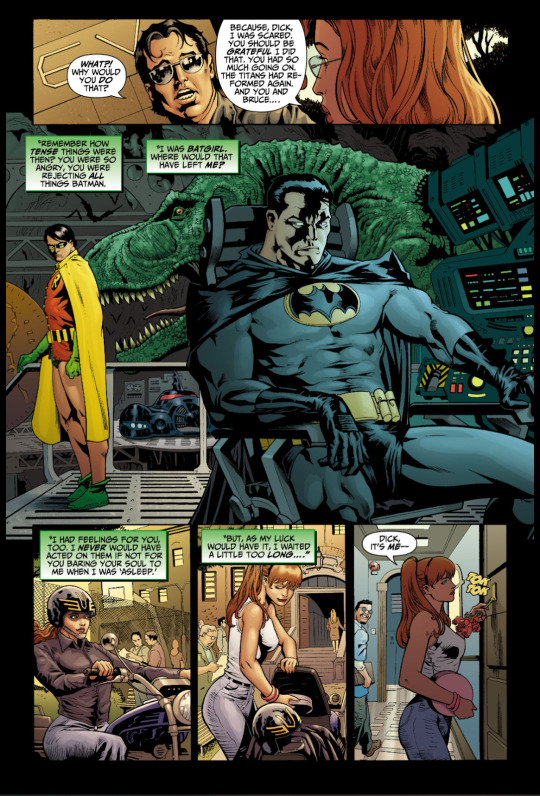
(Andreyko, Marc, writer. Bennett, Joe, illustrator Hero’s Journey. Nightwing Annual. 2, e-book ed. DC Comics, 2007. pp 22 - 23)
Timing,
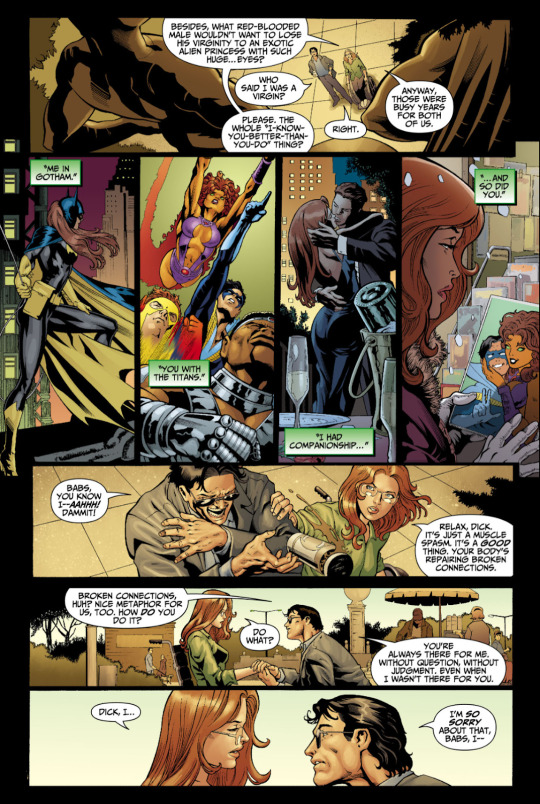
(Andreyko, Marc, writer. Bennett, Joe, illustrator Hero’s Journey. Nightwing Annual. 2, e-book ed. DC Comics, 2007. pp 25)
And, perhaps most importantly, the way in which Dick devalues his own life.
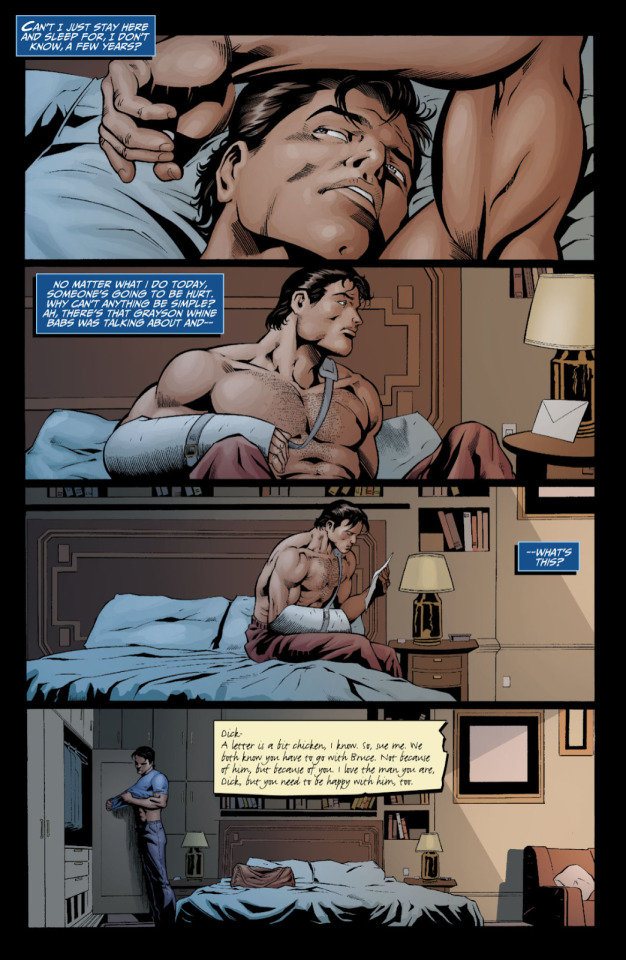
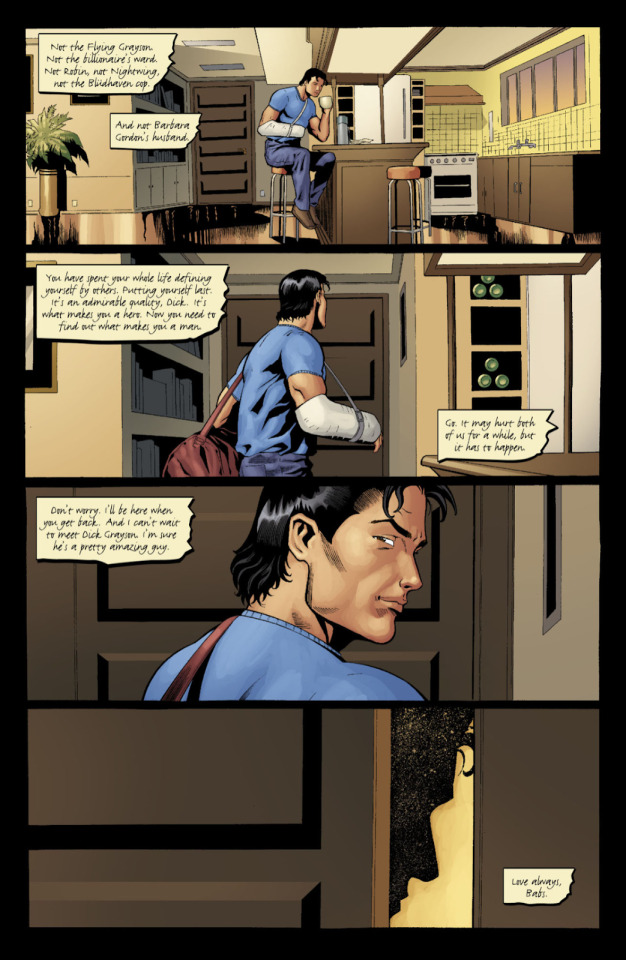
(Andreyko, Marc, writer. Bennett, Joe, illustrator Hero’s Journey. Nightwing Annual. 2, e-book ed. DC Comics, 2007. pp 37 - 38)
This is something Grayson also alludes to during her run, when she often portrays Babs being both worried and frustrated at Dick’s tendencies to push himself too far.
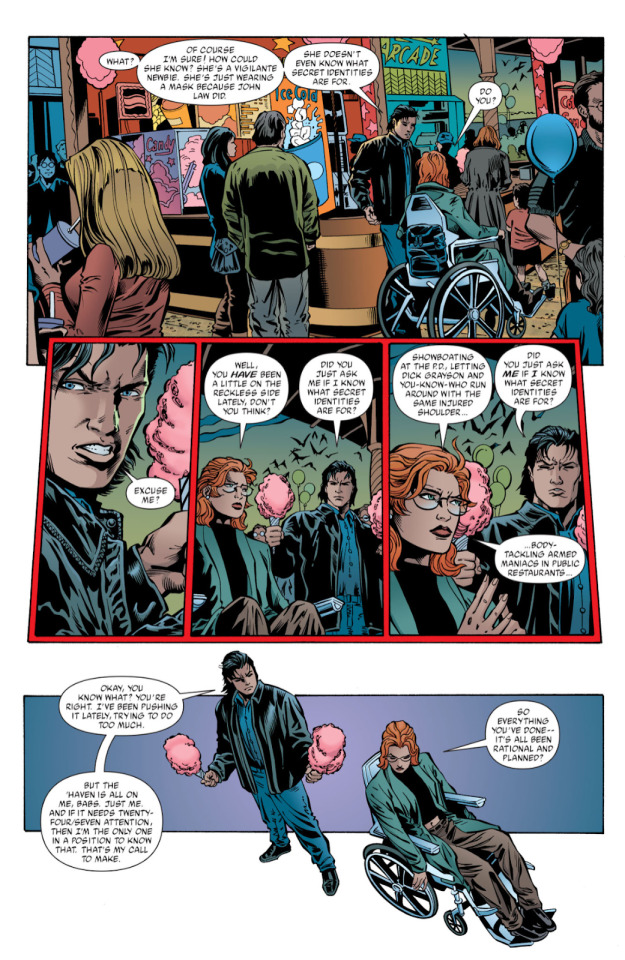
(Grayson, Devin, writer. Zitcher, Patch, illustrator Snowball. Nightwing. 87, e-book ed. DC Comics, 2003. pp 13)
In both Grayson’s run and the aftermath of Infinite Crisis, the toxic perfectionism referred to many times during this essay led Babs to break off their relationship despite their mutual love.
Having lost the mobility of her legs due to the Joker, Babs sees her life as Oracle as a second chance, and one which she will use to its fullest by putting herself first. It makes sense, then, that she sees Dick’s self-sacrificing tendencies and his desire for approval as both concerning and irritating. As Dick constantly puts himself in near-death scenarios for even the smallest of things, Babs decides that she would rather wait for a time when Dick learns to value himself more rather than to continue in a relationship where she is the only one who cares about whether Dick lives or dies.
Whether this is the right solution to their relationship is up for debate. Personally, it irks me that stories will often frame this as Dick having to mature to be with Babs and not place an equal burden on Babs having to learn to accept that this is just who Dick is. But that is irrelevant to this discussion, for what matters is that there have been plenty of reasons why Dick and Babs did not work out in the past, and those are almost always rooted in who they are as individuals struggling to perfectly fit together as a unit.
Dick and Babs have a messy history, both as individual characters with their own stories, and together as friends and romantic interests. They are two different people who, although their morals align, approach life differently. The development in their romance, then, comes with how willing they are to change for the other, and how willing they are to accept the things that cannot — and should not — be changed. It is about a balance of give and take, and when Babs and Dick broke up in the past, it was because they were not able to find that balance. It is because they, as individuals, clashed. As Fernando Gabriel Pagnoni Berns and Cesar Alfonso Marino put in their essay analyzing Dick’s portrayal in the Batman Family (1975-1978) series, Dick and Babs will often find themselves in “point[s] of inflection which marks that both heroes must go their separate ways to avoid further tensions (developed by sexual attraction and/or problems about leadership).” (Pagnoni Berns, Fernando Gabriel and Marino, Cesar Alfonso “Outlining the Future Robin: The Seventies in the Batman Family.”Dick Grayson, Boy Wonder: Scholars and Creators on 75 years of Robin, Nightwing, and Batman edited by Kristen L. Geaman, McFarland & Company, Inc., Publishers, 2015, pp. 32)
In other words, it was about interior conflicts, not exterior ones.
When taking this into consideration, one can see how Taylor’s portrayal of Dick and Babs’ relationship is not only incredibly hollow, but incredibly cynical. Because Taylor removed Dick’s self-destructive, toxic perfectionism, that is no longer a point of friction in their relationship. Because Babs is no longer the pragmatic woman who doses out tough love, that is also no longer a point of friction in their relationship. But as a result, Dick and Babs are no longer themselves, and their relationship is no longer representative of their shared history. Instead, we are left with an insulting and purposeful misrepresentation of their past relationship, with Taylor displaying a blatant disrespect and disregard for anything his predecessors contributed to these characters. Dick and Babs were never apart because of danger. Dick would never condescend to Barbara in this manner, and Barbara would never let something so trivial go unchallenged or get in the way of what she wants. What got in their way was a matter of compatibility. They may compliment each other in the field, be great friends, get along well, but in previous attempts to make their relationship work, they found that they were simply too different to share a life together, their goals did not align, and their approaches to life did not work together. Getting and staying together was not a matter of external factors, but rather whether they could do the difficult internal work necessary to make their romance last.
I want to make it clear that I actually love the childhood-friends-to-lovers trope. But what makes friends-to-lovers interesting is the fact that it creates inherently messy romances. If you two characters who have loved each other for so long, then they naturally have a history. They have seen each other at their best and at their worst. Yet, insecurities, timing, and compatibility keep them from being able to get their happily-ever-after. That creates a messiness that adds weight and meaning to the relationship. Seeing them overcome these challenges, become better individuals, and then finally come together is what makes the narrative so effective.
Dick’s and Babs’ romance, as currently portrayed, lacks that weight. Taylor and DC want that history, that “true love” aspect of their relationship without acknowledging the complications that come from having lived so many years in close proximity. In other words, they want the appearance of a long shared history without acknowledging the contents of said history. This robs both Dick and Babs of their individual personalities and backstories, for it is there where the source of their conflicts lie. All of the things that make them interesting individuals are sacrificed for the heteronormative DickBabs amalgamation. There is no Dick Grayson. There is no Barbara Gordon. There is only a happy, wholesome, smiling couple of nothingness — as it was put earlier it is all “shimmer, gloss, and no substance.”
And this does not affect only them.
In making Dick and Babs inseparable, Babs has become heavily involved with the Titans. This leads to the majority of Babs’s interactions in the current canon to be with Dick’s friends. And because, once more, Taylor skirts away from conflict, that means that all of Dick’s friends have become Babs’ friends. However, by making Babs friends with all of Dick’s female friends, Taylor created a shallow girlboss feminist narrative where all of these women’s individual personhoods are reduced their relationship to one man. He does not take into account who they are, only their gender and their mutual connection to Dick. In trying to do a girl-boss feminist empowerment, Taylor instead creates a deeply misogynistic narrative.
Kory and Babs, for example, should be allowed to dislike each other despite being on the same team. They are, after all, supposedly fully realized women with their own personalities, values, and goals. Their existence is not dependent on Dick Grayson or their romance with him. Real world women dislike one another for various reasons that are unrelated to men. Male characters often hate each other without it being because of a woman. So why can’t the same be true for female characters?
To attempt to make Kory and Babs friends simply to undermine expectations because one of them is Dick’s ex and the other one is Dick’s girlfriend is not empowering. It sacrifices characterization for the purposes of subversion.To think of the dynamic between these two characters in terms of their relationship with Dick reduces their existence to a man by implying that the only possible reason they could dislike one another is because of said man. It is not due to different value systems (which would be incredibly reasonable given their different background and cultures), it is not because their personalities clash (as they are two different people), it is not because their likes and dislikes may contradict (once more, because they are two different people). All the things that would make them realized individuals with agency are ignored in favor of focusing on their relationship with Dick.
Babs is a cisgender, straight, middle-class white woman from New Jersey. Kory is a warrior Princess from a different galaxy. It would not be unreasonable to expect their opinions to conflict when their backgrounds, upbringings, and experiences also differ. After all, those are things that shape our value system, dictating our perspectives.
Having different values or different ways to express your opinion does not mean that one is right and the other is wrong. It does not mean one is superior to the other. It only means they are different. Diverse. To believe one must be correct and the other must be wrong is to fall into the traps of ethnocentrism. By making Kory and Babs values indistinguishable, the story implies that there is only one correct way to interact with the world. This eliminates diverse perspectives in favor of a monolithic one. The fact that Kory's culture is the one that is ignored so that they are compatible with Babs implies that Babs – the cisgender, straight, middle-class white woman from New Jersey – is the one whose culture and world views are correct and, therefore, superior.
Dick’s relationship platonic relationship with Donna is also devalued and watered down in favor of Dick and Barbara’s romance. Because Dick and Barbara are depicted as having been each other’s best friends since childhood — when, in reality, Dick was closer to Donna during his preteen and teenage years, and Donna is often portrayed as his best friend — Donna’s place in Dick’s life is replaced by Babs. Babs must be everything to Dick — his true love, his longest childhood friend, his one female best friend.
This creates a narrative in which Dick cannot have a significant interaction with another woman without it being a threat to his relationship with Babs. Needless to say, this is an incredibly heteronormative worldview which implies that men and women who are not related cannot share deep and significant platonic intimacy without some underlying romantic tension. So naturally, Donna cannot he Dick’s longest friend, his best friend, because in the heteronormative world portrayed in Taylor’s run, that would mean that she is a rival to Babs.
Perhaps it is for this reason that Melinda was revealed to be Dick’s sister so soon into her introduction. If Melinda and Dick were not related but were still meant to interact with each other, that would create a bond that some might see as romantic or sexual. So by presenting Melinda as Dick’s biological sibling within moments of the two first interacting, Taylor strips Melinda of any romantic or sexual appeal. In this heteronormative world, only by being related can Dick and Melinda share intimacy without threatening Babs’ position in Dick’s life.
Needless to say, this heteronormative worldview which only allows for the relationship between non-biologically related men and women to be seen through lenses of romance and sex is also a misogynistic, male-centric worldview. In this story, women are not treated as people and are instead perceived solely through their relationship to Dick Grayson.
83 notes
·
View notes
Text
A (Negative) Review of Tom Taylor's Nightwing Run - What Went Wrong? Bludhaven (PART 1)
Introduction
Who is Dick Grayson?
What Went Wrong? Dick's Characterization
What Went Wrong? Barbara Gordon
What Went Wrong? Bludhaven (Part 1, Part 2)
What Went Wrong? Melinda Lin Grayson
What Went Wrong? Bea Bennett
What Went Wrong? Villains
Conclusion
Bibliography
Dick and Babs’ relationship also comes at the cost of something crucial: the citizens of Bludhaven.
Because Dick is often either with Babs or interacting with his other superhero connections, he does not engage with the people he is meant to protect. As a result, we as readers do not get to know the people of Bludhaven, much less grow to care for them. Bludhaven is barren. The only ones Dick interacts with are Babs, Titans, and occasionally Melinda. He is Bludhaven's protector but he has built no relationships with the people in his city.
When Dick’s apartment building blew up, Wally quite removed Dick from Bludhaven, robbing him of the opportunity to interact with his neighbors, with Clancy, or even his enemies. Having the Titans in Bludhaven further exacerbates this problem by creating a distance between Dick and the others in the city. Dick may be in Bludhaven, but he is not interacting with the people of Bludhaven. He literally lives in a tower removed from the rest of the population. Dick does not have a job of his own, we do not get to see him working for the Alfred Pennyworth Foundation, and because now he gets to be Nightwing more often, he is robbed of even more opportunities to experience a normal daily life in Bludhaven. By having Dick move into the Titan's tower, interact primarily with Babs and the Titans, and work solely as Nightwing, Taylor created a rift between Dick, his city, and its people.
As another Dick Grayson Fan put it in a discussion (From here on referred to as Dick Grayson Fan C):
“The problem [with the current iteration of Dick and Barbara’s relationship] has been there for years but what really brings it out in Taylor’s run - apart from DickBabs being attached at the hip - is that his Bludhaven is just very gentrified. It’s a reflection of the DickBabs relationship. And because Taylor can’t write more than one shallow plot, it’s the same for the Titans.”
Taylor’s Bludhaven is incredibly sanitized. It gestures at discussions of social justice without portraying them, it creates a simplistic black-and-white morality system that does not require the reader to be uncomfortable with the difficult realities of our world. The way Dick Grayson Fan C united both the Dick and Barbara romance and the portrayal of Bludhaven under the term “gentrification” perfectly captures how the relationship undermines the themes the story claims to care about.
Taylor’s Bludhaven has always been sanitized, but when the Titans show up, they displace Bludhaven citizens (literally moving into their neighborhoods, and figuratively by taking up the space Bludhaven citizens should have in a Nightwing story). Their relationship to Dick gentrifies the city and the story, making it so everything appears “nicer” and so Dick does not have to interact with the messier, more uncomfortable aspects of Bludhaven. He only gets to engage with those who are pristine, who share the exact same worldview as him, those affluent and privileged enough to dedicate their lives to superhero-ing without having to worry about being rent, paying bills, caring for their family, the stresses of a job, and any other problems.
For a world that is supposedly diverse, Dick only gets to have meaningful interactions with those whose heroic background and opinions on issues completely align with his own.
The Alfred Pennyworth Foundation would have been the perfect vehicle through which Bludhaven could have been fleshed out and Dick could have contributed to the care of his city while not being a vigilante. Yet, because Taylor tends to avoid conflict and makes it so everything must come easy to Dick, we are robbed of opportunities for Dick to grow, for the city to be fleshed out, and for the themes Taylor claims to care about to be fully explored.
Think about it: What reason do the people of Bludhaven have to believe that Gotham-native and newly billionaire Dick would keep his promise to create a shelter for their homeless youth population? Why should they believe that he is different from the other politicians or so-called philanthropists that took advantage of the system and of Bludhaven’s people in order to line their own pockets? And even if Dick was genuine in his efforts, why should they believe Dick would succeed when Blockbuster has the entire city under his thumb?
Dick never has to work to gain the trust of the citizens of Bludhaven. Because we are robbed of this conflict — that of Dick wanting people to trust him and people being reluctant to do so due to their past experiences — we are also robbed of a story that shows rather than tells the problems Dick tries to solve while also creating rich interactions between our protagonist and the people of his city. A conflict in which Dick has to prove himself to be trustworthy would have also given us the opportunity to meet and care for actual Bludhaven citizens, seeing them as individuals with diverse backgrounds, values, and personalities rather than a blank faceless mass.
Not only would a conflict in these early stages of Haven’s creation serve to develop Dick’s character, flesh out Bludhaven as a city with its own unique personality and problems, and create a side cast filled with individuals, but it would also work towards the main themes of the story. By denying us of said conflict, Taylor in turn makes his story weaker while undermining the thesis of his work.
On a bureaucratic front, Dick also faces no challenges. He never has to work to get his foundation started. After his announcement, we do not get to see him taking any of the practical steps required to run a nonprofit foundation and getting started on such a project. Furthermore, any bureaucratic challenges he should have faced given how the source of Bludhaven’s troubles are one of corruption, are easily waved away by Bea who later takes credit for this smooth ride, robbing Dick of agency and of his own accomplishments. Though Dick refused to acknowledge her work even as he received recognition for helping Bludhaven #113.
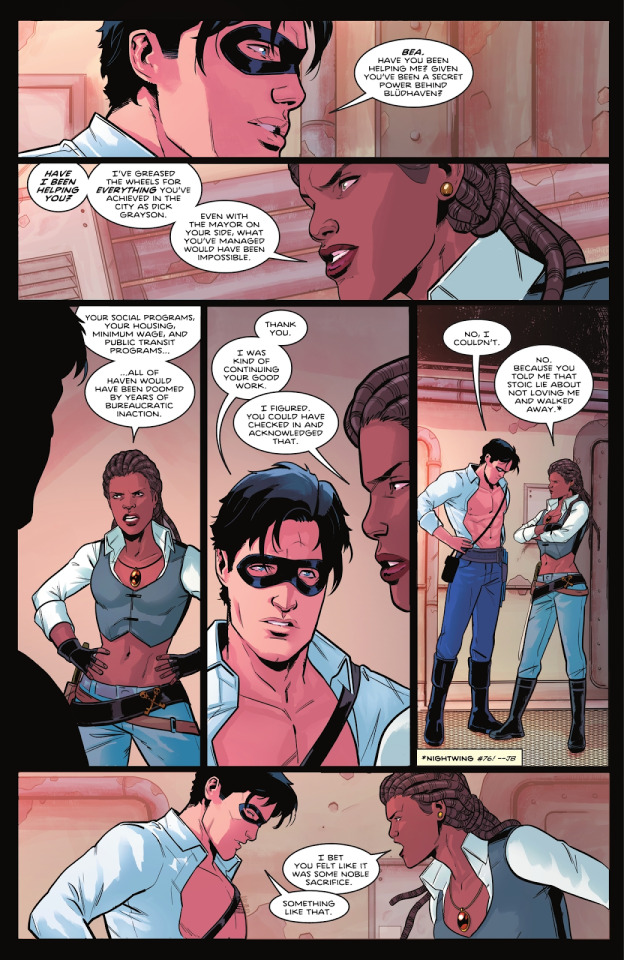
(Taylor, Tom, writer. Byrne, Stephen, illustrator. The Crew of the Crossed Part Three. Nightwing: Rebirth. 107, e-book ed. DC Comics, 2023. pp. 06)
Ordinarily, I wouldn’t consider that to be much of a problem. After all, the reason why Detective Comics and Batman comics do not focus on Bruce’s philanthropy is because that is not the focus of those stories (Though I once more feel the urge to note that Cataclysm and No Man’s Land managed to incorporate such elements into the main plot while still keeping the focus on the gang wars, superhero work, and detective investigation). But Taylor made The Alfred Foundation and Haven a centerpiece of the beginning of his run. In his attempts to address the popular online discourse about Bruce’s money being a solution to Gotham’s problem, Taylor made the idea that Bludhaven needed Dick Grayson’s philanthropic efforts to be their safety net a main theme of his story. For that reason, this plot element should have been a major focus, which means it should have been a main source of conflict in ways that showed just how Blockbuster’s cruelty affected the disposition of Bludhaven’s citizens.
The absence of conflict and tension in the story point that is so pivotal to Taylor’s run demonstrates not only Taylor's underwhelming abilities as a writer, but also how he approaches writing not with a focus on storytelling, but rather with a focus on online discourse.
Scholar Steve Braxi highlights this as one of the main problems in Taylor’s writing when examining both Nightwing and Superman: Son of Kal-El in the essay On Superman, Shootings, and Realities of Superheroes. There, Braxi dismantles criticisms against the “socio-political” responsibilities of fictional superheroes by arguing such critiques to be in bad-faith for demanding “political solutions from fictional realities.” According to him, in these arguments, “Superman and Batman are not treated here as ideas readers want to believe in, but rather people that need to prove their worth to us. They need to take on real issues in their fictional world in order for their fictional solutions to speak to our real world. This equivalency between their world and ours has a dissonant effect on me because I think it misunderstands the entry point of fiction in the first place.” (Braxi, Steve, “On Superman, Shootings, and the Reality of Superheroes” Comics Bookcase, September 2021)
Taylor’s decision to make Dick a billionaire who uses his money for the social benefit of others is a response to popular online discourse about whether Bruce Wayne should use his money to help Gotham in ways other than Batman. While I already pointed out that such arguments ignore the fact that Bruce does, canonically, use his wealth to the benefit of others, Braxi points out that “the argument that Superman ignores real social issues or that Batman is worse than the crime he fights does not assume the best intentions of the characters, creators or nature of fiction. They engage with these stories from a perspective that is intentionally distant from the unique reality of the story being told.” (Braxi, Steve, “On Superman, Shootings, and the Reality of Superheroes” Comics Bookcase, September 2021)
Braxi rightfully argues that attempts to respond to shallow criticism leads to shallow storytelling. It is only because these are popular online arguments that Taylor makes them important plot points in his story. And yet, despite their supposed importance, the Alfred Pennyworth Foundation and Haven are not properly incorporated into the story because Taylor does not take into consideration what these elements say about his characters, his themes, and how they can shape the plot on a deeper level. As such, the lack of meaningful conflict can be seen as a symptom of this thoughtlessly performative desire to play into trendy discourse. Character complexity, narrative depth, and thematic cohesion are all sacrificed to please an ever changing social media algorithm and debates that are forgotten and disregarded in a matter of days.
Even the Alfred Pennyworth Foundation’s name is, quite frankly, evidence of such online fan pandering at the cost of characterization and narrative. Alfred is beloved by many, and while we do not have time to discuss DC’s attempts to sanitize his character after his death (While I adore Alfred, he had many flaws that affected the manner in which he raised Bruce and Dick. These flaws, however, have been ignored or erased by current comics that prefer to portray Alfred as a benevolent father figure who never made any mistakes. While I believe Bruce and Dick would glorify Alfred in such a manner, that does not mean the narrative has to agree with their biased perspectives),
the reality is that though Alfred may mean a lot to Dick Grayson fans, he means nothing to the people of Bludhaven. From my personal point of view, Alfred was also not the type of person who would have liked to have a statue in his honor in a city he never visited. From an in-universe perspective, naming a nonprofit meant to help the people of Bludhaven after a man who did not even live in their city and then erecting a statue in his honor makes no narrative sense. But Taylor does it because the statue means something to the audience, regardless of how that would play in-universe.

(Taylor, Tom, writer. Redondo, Bruno, illustrator. The Battle for Bludhaven’s Heart. Nightwing: Rebirth. 92, e-book ed. DC Comics, 2022. pp 12)
Furthermore, by not having Dick interact with the people of his city, Taylor contradicts his supposed characterization of Dick as a “good guy.” This is yet another instance of telling and not showing, and it is most obvious when looking at Heartless.
Though Taylor tried to build up Heartless as this intimidating villain, he put little effort into matching said intimidation with the appropriate amount of urgency. Dick does not treat Heartless as an actual threat. This, as mentioned previously, transforms Dick into a self-absorbed man who does not understand (or does not care) about dangers being posed to the people of his city.
From both a narrative and a character standpoint, the fact that the children of Heartless’ victims mirror Dick’s own experience makes this disconnect even more frustrating.
Dick lost his parents. He knows what it feels like to see their dead, bloody bodies on the floor when you’re but a small child. Dick also knows how finding justice can help with closure, and how not finding justice can haunt you for the rest of your life. Knowing that Heartless made countless kids into orphans should be a crucial motivation for Dick to fall into that intense and obsessive pursuit that characterizes his crime fighting. Dick should be working on this case constantly, for he knows what those kids are going through. Dick appointed himself their protector, yet he does nothing for them. He does not guide them through their grief the way Bruce did for him, he does not find justice for their parents the way Batman and Robin did when they captured Zucco, he does not offer them closure or an outlet for their anger and their pain. The story does not show Dick to be a hero, but rather, it makes him into an incredibly selfish, lazy person who is only interested in the optics of heroism, and not the, often thankless and unacknowledged, work it takes to actually help people.
The contrast between how Dick is Nightwing: The Untouchable and Taylor’s run could not be greater. The former carried every death on his shoulders, determined to push through bullet wounds in order to prevent more killings. The latter behaves as if Heartless did not exist unless he is on screen.
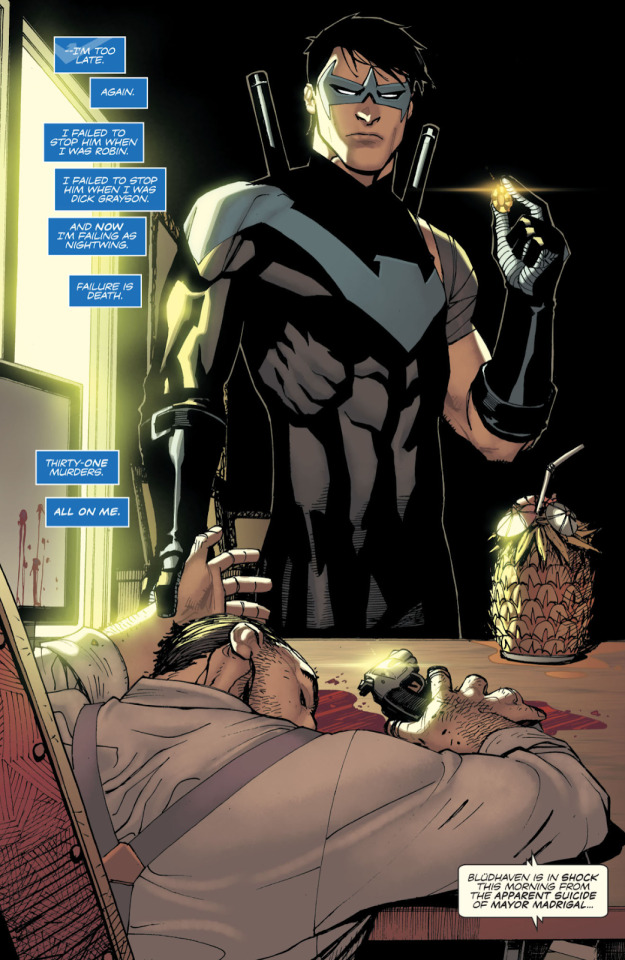
(Humphries, Sam, writer. Chang, Bernard, illustrator. The Untouchable: Chapter Two: Relentless. Nightwing: Rebirth no. 36, e-book ed. DC Comics, 2018. Page 20)

(Wolfman, Marv, writer. Igle, Jamal, illustrator. Bride and Groom: Part One: The Courtship. Nightwing no. 129, e-book ed. DC Comics, 2007. pp. 11)
That is because Wolfman understood that the best way to show Dick’s compassion was to have him interact with those whose lives were made better by his presence. As readers, we were able to experience first-hand the difference Dick makes on an individual and personal level. This is more than just having Nightwing appear in a pencil case; this shows Dick actively interacting with the people of his city, forming genuine connections with them, and putting in the work to make their lives better because he cares.

(Wolfman, Marv, writer. Luque, Paco Diaz, illustrator. Bride and Groom: Part Four. Nightwing no. 132, e-book ed. DC Comics, 2007. pp. 24)
Please understand that I am not saying that Heartless should be present in every single issue, from the moment he was introduced to the moment he is finally caught. But just because he is not physically there, it does not mean that the story should not be exploring the effect his actions have on his victims' loved ones. Readers should see the terror that grips Bludhaven as a serial killer is on the loose. How do people, especially the homeless youth Dick vowed to protect, react when they don't feel safe? Heartless doesn't need to be physically there, but his presence and its effect should still be felt. That's what happened with Blockbuster in Nightwing (1996) – he may not have been there all the time, but his grip on Bludhaven, on the corrupt systems, on Dick's life, was still always present.
By depicting Heartless’ effect on Bludhaven would not only add urgency and stakes to the plot, it would give faces to his victims while giving Dick the opportunity to bond with the people of Bludhaven. Perhaps as Heartless’ orphans come together in their grief and anger, and once they realize that the corrupt BCPD isn’t going to bring justice to their parents, they decide to take matters into their own hands. Then Nightwing could step up and prevent them from going too far. He could teach them productive ways to channel their anger, give them shelter and an empathetic ear, and he would vow to do right by them when no one else did before. This would show Nightwing’s love for Bludhaven and it would bring the themes of inequality and social justice that Taylor claims to want to explore into the narrative in a more emotionally effective manner, for the homeless youth would have names, faces, and their own voices.
There doesn’t even need to be many children. In fact, there could be just one — Elliot, from #79.
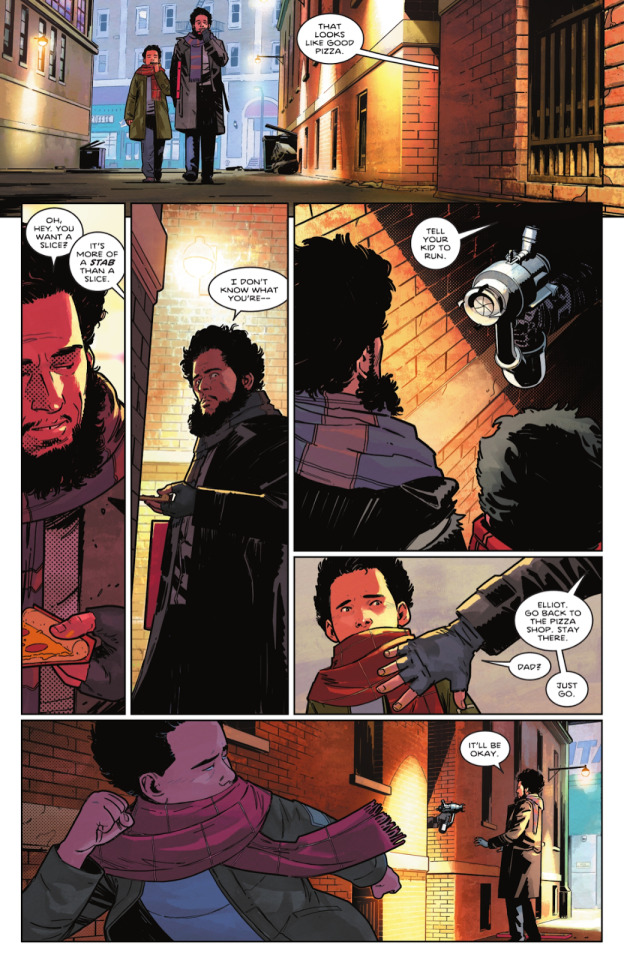
(Taylor, Tom, writer. Redondo, Bruno, illustrator. Leaping into the Light Part Two. Nightwing: Rebirth. 79, e-book ed. DC Comics, 2021. pp 11)
By making Elliot the face of Heartless’ true evil, the face of the victims of Bludhaven’s corrupt system, of people’s lack of compassion, Taylor would show the reader everything Dick wants to fix in Bludhaven and why it needs fixing. Elliot would humanize these abstract concepts so that the reader is emotionally invested in Dick’s success. The stakes are suddenly personal. Furthermore, it would prevent the city from feeling so barren while giving Dick people to care for outside of his already established connections. Just as Bruce did with him, Dick could see much of himself in Elliot, and that would lead him to want to help Elliot in a similar way Bruce helped him all those years ago. This also would have contributed to making the hug in #100 more effective, as it would be creating mirrors and parallels between Bruce and Dick’s relationship, and Dick’s relationship to Elliot.

(Loeb, Jeph, writer. Sale, Tim, illustrator. Orphans. Batman: Dark Victory. 09, e-book ed. DC Comics, 2000. pp 05)
The fact that it took over thirty issues for Taylor to finally, finally, draw a connection between Bruce, Dick, and Heartless victims in #111 is, frankly, lazy and thoughtless.
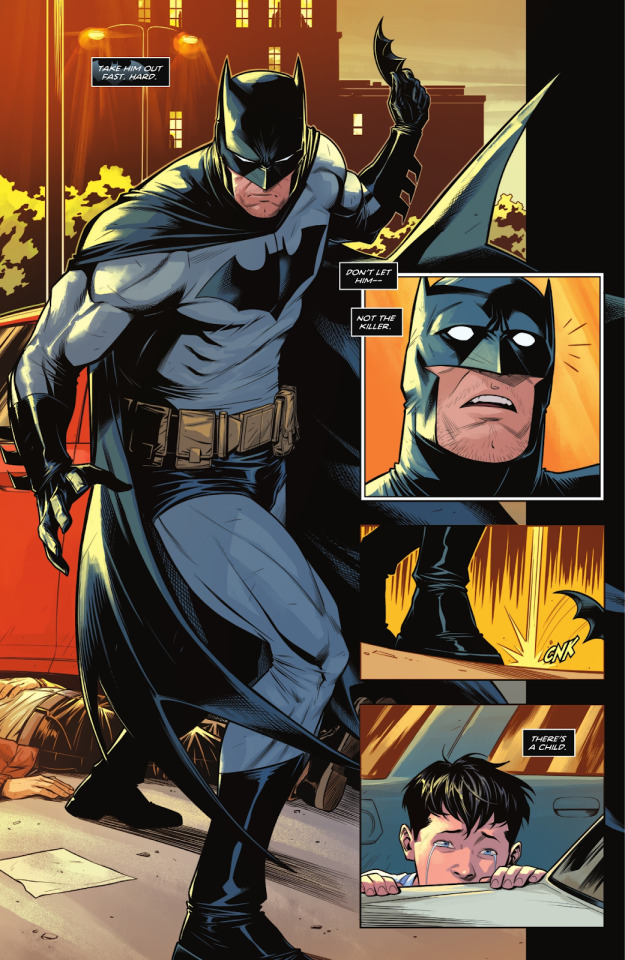

(Taylor, Tom, writer. Basri, Sami, illustrator. Nightwing. Nightwing:Rebirth. 111, e-book ed. DC Comics, 2024. pp 05-06)
In his 2022 video titled The Secret Ingredient That Makes Raimi's SPIDER-MAN So Great (Season Premiere), video-essayist and film critic Patrick H Willems discusses how vital of a role the ordinary citizen characters played in the Sam Sami Spider-Man trilogy. He describes how “they make the New York of these movies feel like a real, thriving city populated by a vibrant community of characters. Because if we’re going to care about Spider-Man caring about the people of New York, we have to actually get to know the people of New York.” (Willems, Patrick H. “The Secret Ingredient That Makes Raimi's SPIDER-MAN So Great (Season Premiere)” Youtube, uploaded by Patrick (H) Willems, 20 September 2022 https://www.youtube.com/watch?v=xFpQBOopf84)
Similarly, giving Bludhaven citizens, giving Heartless’ victims agency and individuality would have elevated the story and made Dick into a more empathetic and endearing hero. We would have cared about the people of Bludhaven because we would have gotten to know them through their interactions with Dick.
But to accomplish that, Taylor would have to actually care about who Dick Grayson is and who the people of Bludhaven are; he would need to actually care about the story he is trying to tell as a whole, rather than simply writing for moments that will merely appear progressive when removed from their context and presented on social media.
To be perfectly fair to Taylor and Redondo, they are hardly the only ones to miss an opportunity when it comes to Bludhaven. Even Dixon and Grayson, the first two who were given the chance to breathe life into this city, were satisfied to treat Nightwing’s abode as merely “Gotham lite.” In fact, much could be said about DC’s handling of Bludhaven, its lack of investment in the city, the ways in which it tried to erase it from its history, and what parallels can be made with how many in DC view Dick Grayson. What sets Taylor and Redondo’s mishandling apart from all others was that, instead of depicting Bludhaven as a generic corrupt city, they opted instead for a gentrified, picturesque liberal urban utopia. As Taylor’s Nightwing perfectly said when confronting Blockbuster, Roland Desmond is the one big identifiable bad guy who is shown to be the source of all of Bludhaven’s problems.
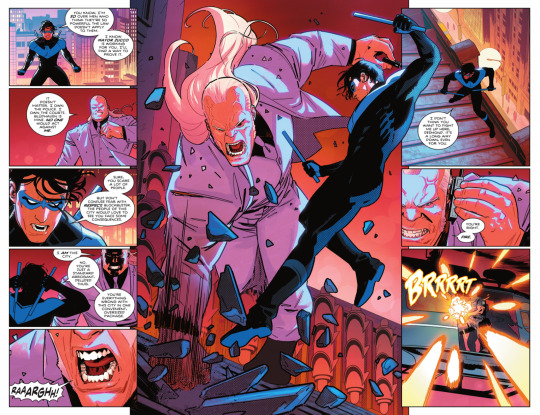
(Taylor, Tom, writer. Redondo, Bruno, illustrator Leaping into the Light Part Six. Nightwing: Rebirth. 83, e-book ed. DC Comics, 2021. pp. 08)
Like Gotham, Bludhaven is broken in a myriad of ways. While many of their problems come from those on top, both cities also face mundane evils that rise from not just suffering, but apathy. There are many stories about Gotham that explore the dark and the light side of humanity, acknowledging that both of them can be found in us. It was a small evil that killed Thomas and Martha, but it is a grander, structural evil that prevents justice from being served and hinders Gotham from prospering. It was also a grander, structural evil and corruption that put Joe Chill in a position where he held a family at gunpoint and murdered a mother and father in front of their young child.
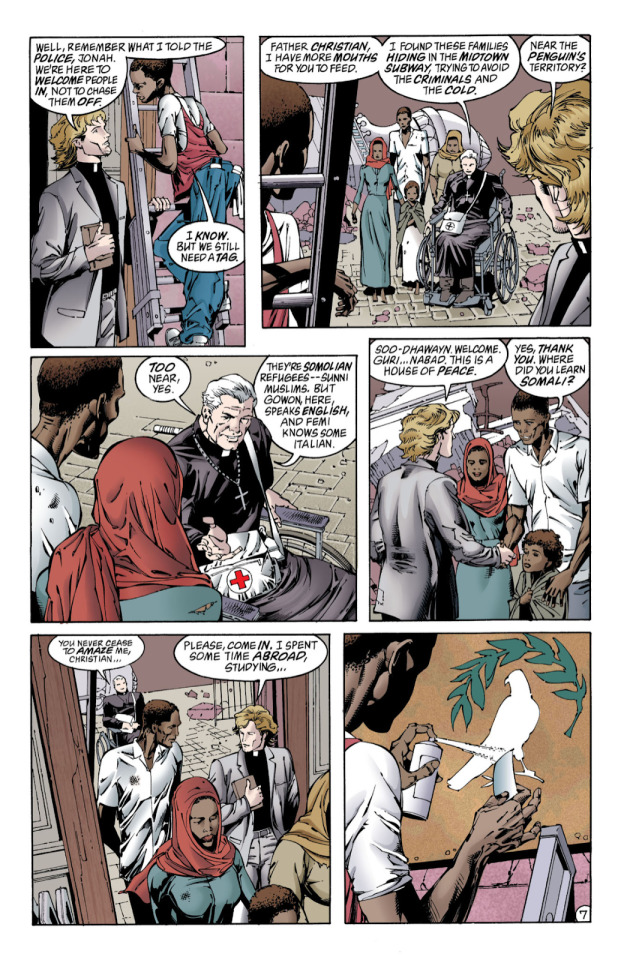
(Grayson, Devin, writer. Eaglesham, Dale, illustrator. Fear of Flames Part One: Fanning the Flames. Batman: Legends of the Dark Knight. 116, e-book ed. DC Comics, 1999. pp. 07)
Bludhaven is often characterized as Gotham’s little sister. In fact, it was the fact that the city reminded Dick so much of a Gotham without a Batman or a Gordon that Dick decided to take on the challenge of caring for Bludhaven. He saw a city in need, knew he could do something to help it, and so he did.
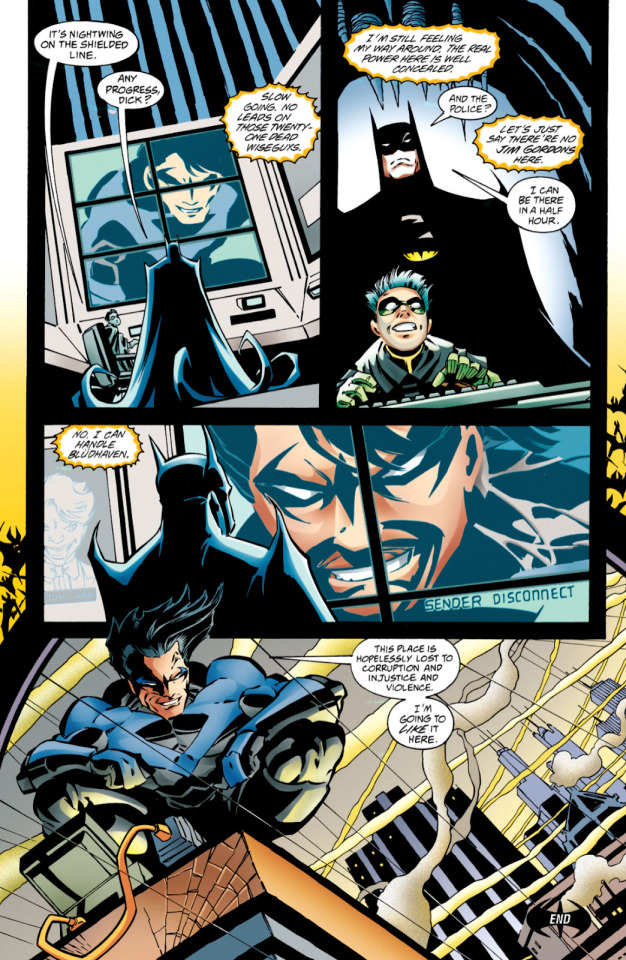
(Dixon, Chuck, writer. McDaniel, Scott, illustrator The Freebooters. Nightwing. 03, e-book ed. DC Comics, 1996. pp. 23)
Just Batman struggles in No Man’s Land when there is no system to uphold, the beginning of Dixon’s run is characterized by Dick struggling with the lack of allies or of a network in which he could trust. As Tim pointed out to him in Nightwing #06, Dick was all on his own.
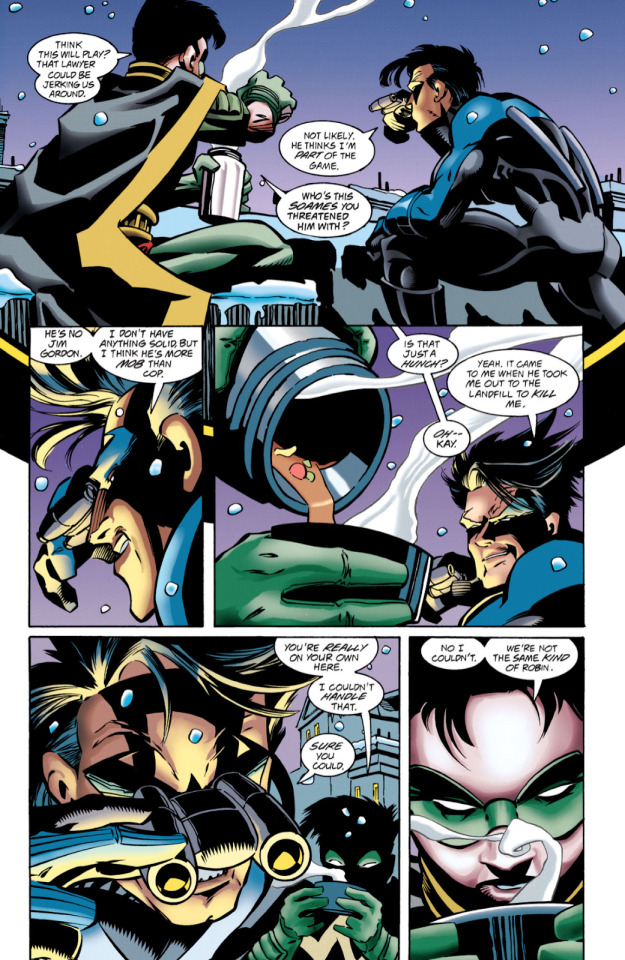
(Dixon, Chuck, writer. McDaniel, Scott, illustrator The Visitor. Nightwing. 06, e-book ed. DC Comics, 1996. pp. 12)
Tim Seeley also emphasized this isolation in his run, though in this scenario, Dick purposefully sought out this separation in hopes that being in Bludhaven would help him discover who he is.
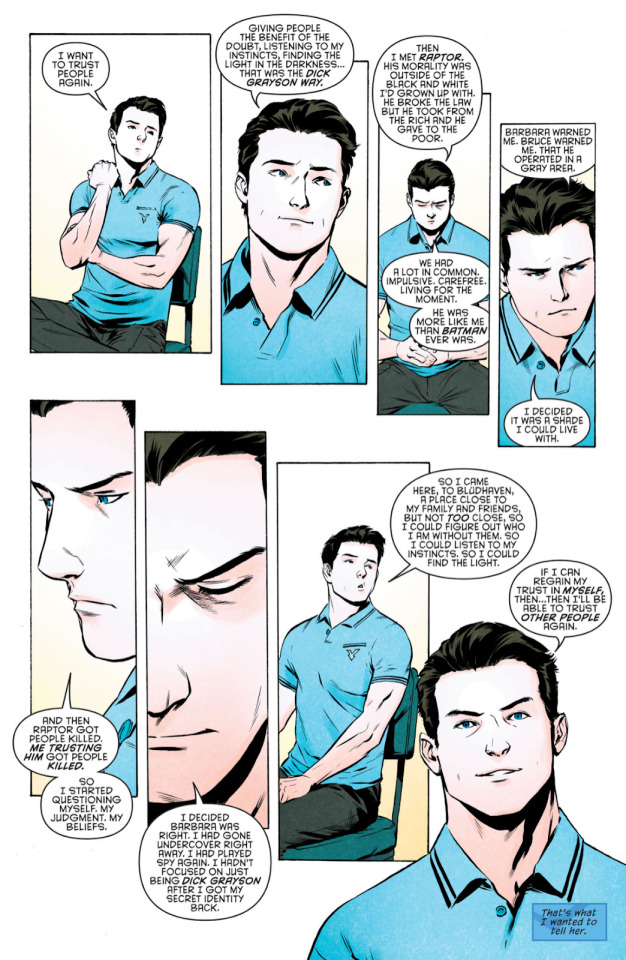
(Seeley, Tim, writer. To, Marcus, illustrator Bludhaven: Part One. Nightwing: Rebirth. 10, e-book ed. DC Comics, 2016. pp. 08)
As both runs progress, Dick slowly builds his own network of alliances. In Dixon’s run, which seems to be the one that, given Blockbuster’s presence, most inspired Taylor, Dick learns how the city operates and crafts a strategy that balances tackling emergencies, disrupting the system, and slowly untangling the messy rot beneath without causing unforeseen negative consequences.While Dixon’s run is filled with problematic elements in its own right (especially when it comes to the portrayal of women and even some aspects of Dick’s characterization), this section will be focusing on how the narrative provides opportunities for Dick to interact with the ordinary people of Bludhaven. (Taylor drawing inspiration from Dixon’s run can be observed not only on the similarities between the plot points [though he retreads mainly Grayson’s run rather than Dixon’s], but also by Taylor’s own admission. In February 2024, when Dixon posted a homophobic tweet about Jon Kent and Dick Grayson, Taylor expressed his disappointment over Dixon’s attitude and cited how Dixon’s run was an inspiration to him.)
Clancy becomes a bridge between Dick and his neighbors, who represent different facets of Bludhaven.

(Dixon, Chuck, writer. McDaniel, Scott, illustrator. False Starts. Nightwing. 21, e-book ed. DC Comics, 1998. pp. 13)
Through his work as a bartender he gains insight into cold cases, learns more about the Bludhaven City Police Department.
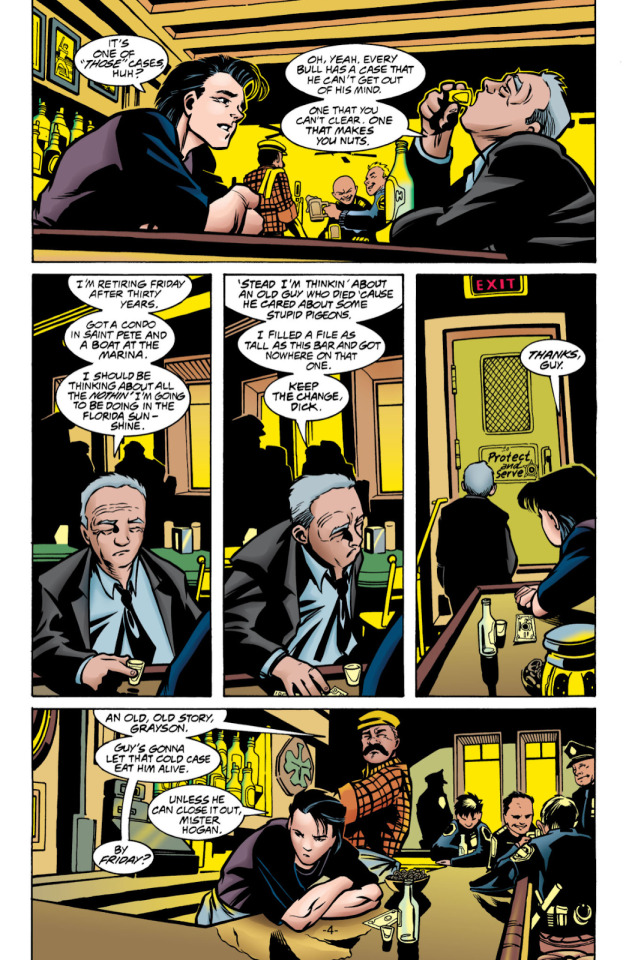
(Dixon, Chuck, writer. McDaniel, Scott The Forgotten Dead. Nightwing. 24, e-book ed. DC Comics, 1998. pp. 24)
He befriends his partner Amy Rohrbach, and with her, he learns about the small alliance of clean cops that are trying to overthrow the current dirty officials.

(Dixon, Chuck, writer. McCarthy, Trevor, illustrator. The Threshold. Nightwing. 60, e-book ed. DC Comics, 2001. pp 08)
Similarly, Grayson's run shows us the complicated politics of the city’s underworld, presenting the reader with a myriad of characters. While Dick certainly encounters greedy mobsters interested only in using violence as a means to gain wealth
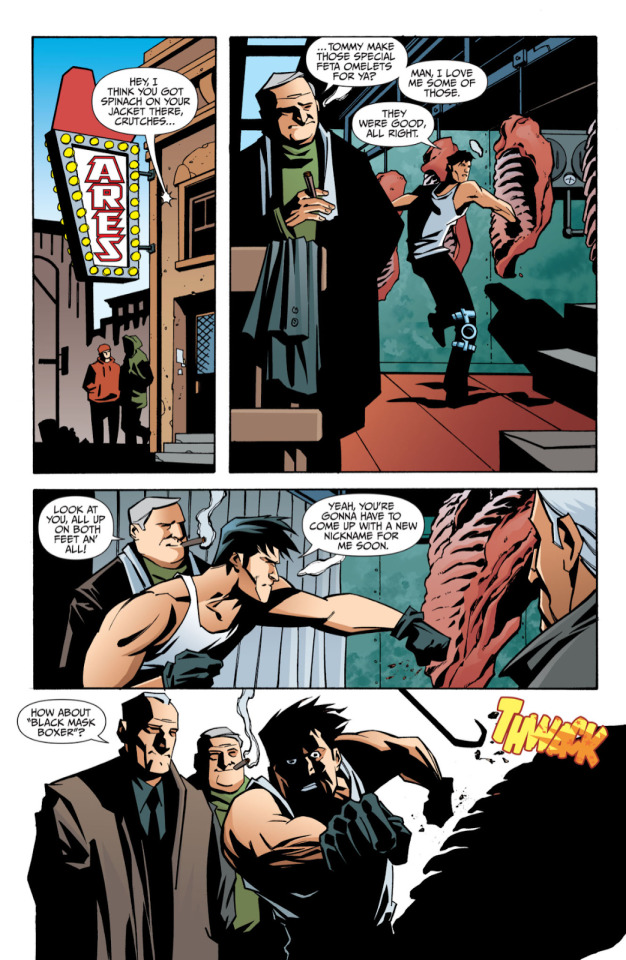

(Grayson, Devin, writer. Hester, Phil Cold Turkey. Nightwing. 109, e-book ed. DC Comics, 2005. pp. 11 - 12)
Dick also interacts with those who ended up caught up in such a dark world through no fault of their own. When Dick, acting as Crutches, beats up a mobster, he discovers his innocent girlfriend and the girlfriend’s child were in the house. While Dick, as our hero, did not allow any harm to come to them, the trauma they went through is not ignored by the narrative.
In fact, not only is it acknowledged, but when Angie Malazavos comes to the police with information on the mob — something that could only happen thanks to Dick and Amy successfully removing a majority of dirty cops from position of power — we see that trauma repeated as the police raids the house of the mobster who began the attack.
Memorably, this leads to Sophia Tevis, the fifteen year old daughter of said mobster, to not only become an orphan, but embody that uncomfortable synthesis of crime and innocence after she witnesses her entire family — a family who loved and doted on her — being killed by the police
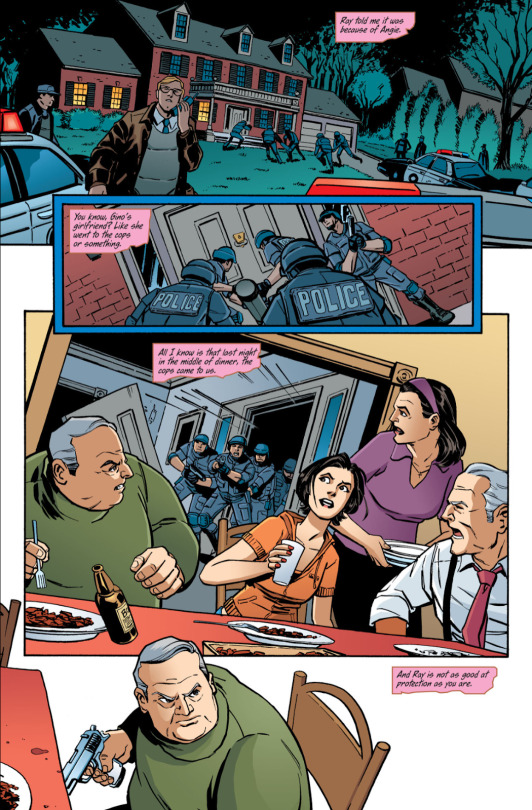
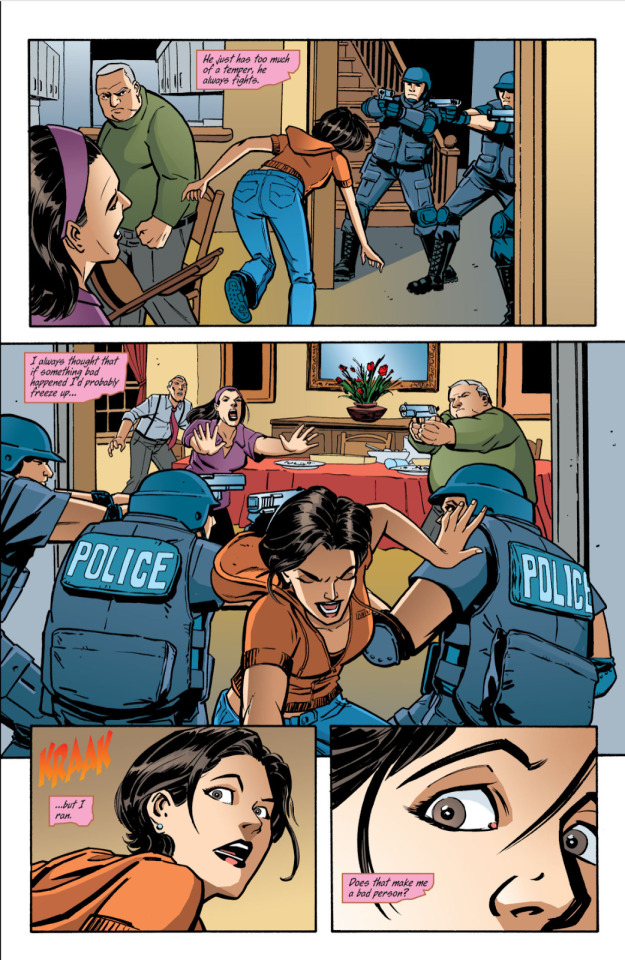

(Grayson, Devin, writer. Chiang, Cliff, illustrator. Signed, Sophia. Nightwing. 111, e-book ed. DC Comics, 2005. pp. 5 - 7)
As he takes her under his wing, Dick and the reader are forced to confront the unclear position people like Sophia occupy in a world that attempts to create clear divides based upon not only actions and motivations, but relations.
By contrast, Taylor’s Bludhaven is too… Nice. Like his characters, it lacks any substance or personality, being a shallow and bland setting without true flaws or appeal. By blaming Blockbuster and his cronies for all that is wrong in Bludhaven, Taylor cheats himself of the opportunity to give Bludhaven flavor. He creates a world where either you are a rich man taking advantage of others or you are a helpless victim who has a good heart and will always be selfless.
This simplistic morality and the surface-level portrayal of Bludhaven as a city not only proves that Taylor gives the city he is writing about no true thought, but it also shows how Taylor’s supposed interest in progressive messages and socially-conscious themes is an incredibly shallow one. After all, if Taylor truly wanted to explore themes of class inequality and systematic injustice, then such a simplistic moral approach works against the innate human messiness and structural complexities inherent in these themes. It is not the themes or its messages, therefore, that interest Taylor, but rather the prestige that comes from being viewed as someone writing about these issues.
This once more shows that Taylor does not care about the story he is telling, the characters in his care, the themes he brings up, and the city whose legacy is in his power to shape. He is not approaching his run from the perspective of a writer, but rather, of a person who chases clout on social media.
As Braxis pointed out in his article, engaging with these themes is difficult. Engaging with it well — truly entering the conversation about real world political, social, and economic problems — is even more so, especially when you also have to tell a satisfying story that does come across as preaching. More than that, though, a story that so directly confronts these issues must, in order to be effective, force the reader to come to terms with their own culpability in a system that is far larger than the individual. It must force us to be uncomfortable and have us ask ourselves how we can bring on change, even in some small way. If such stories are not willing to have the reader be truly emotionally uncomfortable, then they are simply appropriating the pain and suffering of others for a bit of socially progressive coat of paint.
Taylor does not want his readers to be uncomfortable. He does not wish to upset them. He does not wish them to worry or even feel the slightest bit of tension by having Dick be wrong or someone say something mean. He refuses to portray all the many ways evil can manifest in society, all of the petty cruelties everyday people inflict on each other, the apathy of those who are comfortable, the way many must force themselves into individualistic selfishness in order to survive or in order to protect those they love. Taylor doesn’t allow for the pettiness in his world, where, in #87, even a random passerby must happily offer up his bike to Nightwing without questions or expectations.
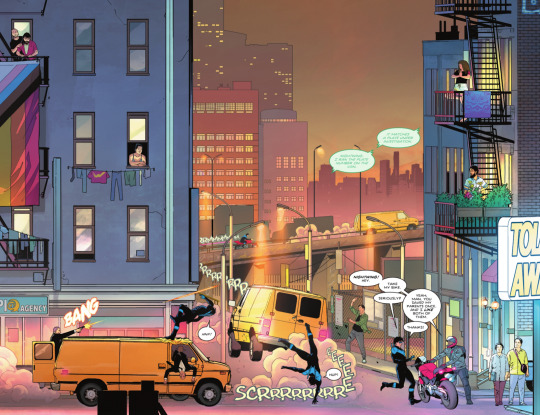
(Taylor, Tom, writer. Redondo, Bruno, illustrator. Get Grayson. Nightwing: Rebirth. 87, e-book ed. DC Comics, 2021. pp 08)
Taylor’s depiction of Bludhaven betrays a very juvenile idea of what good and evil means, a very simplistic idea of how the world works, and very easy solutions to fixing difficult problems, with all of the woes being “fixed” when good guys like Dick, Babs, and Melinda are in power. If you are not one of the main characters, then you are either a corrupt criminal using their money to take advantage of people, or you are a poor helpless victim. There’s no in between, no space for the mundane evils of the world or the average heroics of average people.
As Braxis pointed out when discussing the superficiality of Taylor’s social critique:
Son of Kal-El and Nightwing demonstrate a pattern in Tom Taylor’s writing where social issues are used as plot devices, but there is a performative contradiction this ends up creating. Jon and Dick are exposed to social issues as a gateway to criticize their mentors. However, their lack of understanding about the issues they’re exposed to means their own criticisms can be thrown back at them.
(Braxi, Steve, “On Superman, Shootings, and the Reality of Superheroes” Comics Bookcase, September 2021)
Please note that I'm not saying that exploring class inequality and systematic injustice aren’t interesting lenses through which one can explore Bludhaven. However, by making Bludhaven such a friendly yet passive city, Taylor stumbles onto a trap of his own making. He uses no metaphors, no allegories, no symbolism, no fantasy or science fiction elements to create distance between the narrative and the real world, allowing more freedom with how these topics could be discussed. Taylor decided to tackle, as Braxis characterized, “shallow criticism, a criticism in bad faith” by directly engaging with these real world problems, and as such, he took on work that was not only far beyond his capabilities as a mediocre writer, but work that he clearly has no interest in undertaking.
To have to read about this Bludhaven after we had Humphries and Chang’s depiction feels even more like a knife to the heart of every Dick Grayson fan.
Humphries’ The Untouchable, Bludhaven’s corruption and evil is beyond “generic” police corruption. It is specific. It is unique. Bludhaven has a history. It has personality. Humphries’ run touches on themes of corruption both through the fantastical use of the Judge, and by the very specific scenario of Bludhaven’s unique economic problems. This Bludhaven’s economy is so deeply tied to a rotten, corrupt system that everyone ends up being both victim and perpetrator. The system harms all of them, but without it, they cannot survive.
The casinos were corrupt, stealing money from schools, lining its owners pockets, controlling the mayor through bribery and blackmail. But Bludhaven is also dependent on the casinos. Its economy is entirely dependent on them to the point that even those who do not work directly with the casino still need them to thrive. This creates a fascinating and complicated scenario where weeding out the corruption that led to so much suffering will not solve anyone’s problem. In fact, as the story demonstrates, it can even make it worse.

(Humphries, Sam, writer. Chang, Bernard, illustrator. The Untouchable: Chapter Two: Relentless. Nightwing: Rebirth no. 36, e-book ed. DC Comics, 2018. pp. 21)
For a more concrete example of how Humphries and Chang were able to flesh out Bludhaven in five issues so much more than Taylor and Redondo did throughout all these years, I want to compare Humphries’ handling of the Justice Tree with Taylor’s handling of the Octopus statue in the beginning of his run.
Humphries’ Justice Tree not only creates a concrete and identifiable landmark within the city, not only is it connected to Bludhaven’s history, The Untouchable’s main antagonist, and Dick’s personal relationship with the city, but it is also tied to the themes of the plot.
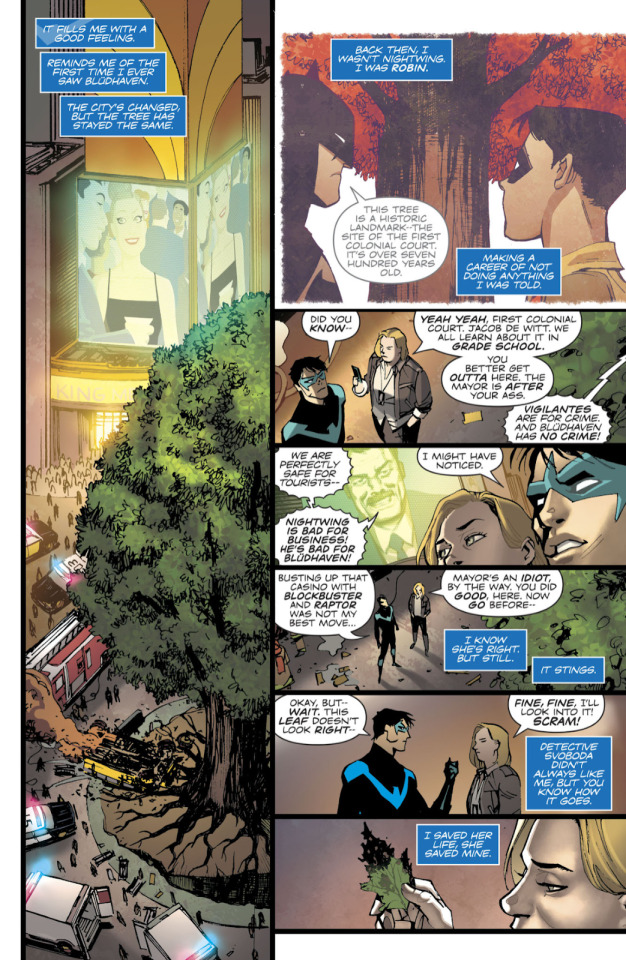
(Humphries, Sam, writer. Chang, Bernard, illustrator The Untouchable: Chapter One: Hunter. Nightwing: Rebirth no. 35, e-book ed. DC Comics, 2018. pp. 12)
In The Untouchable, the Justice Tree is rich with symbolism. First planted in Bludhaven by The Judge while he was still human, symbolizes, well, justice. As the Judge’s return and his machinations reveal the rot that had been seeping into Bludhaven, the tree begins to wither, its centuries old existence threatened. As the tree’s fate is at risk, so is Bludhaven’s.
The narrative goes back to the Just Tree just at the right beats, emphasizing the thematic core of its story. It also contributes to the plot by becoming a ticking clock. It’s threat countdowns to the big climax of the story, when Nightwing and the Judge will battle for Bludhaven’s soul. It is notable that while the Justice Tree was first planted by the Judge, it is Dick’s efforts that manage to save it, so even though both men are fighting for what they believe to be right, everything about narrative indicates that Dick is the one who ultimately has what it takes to save Bludhaven from corruption.
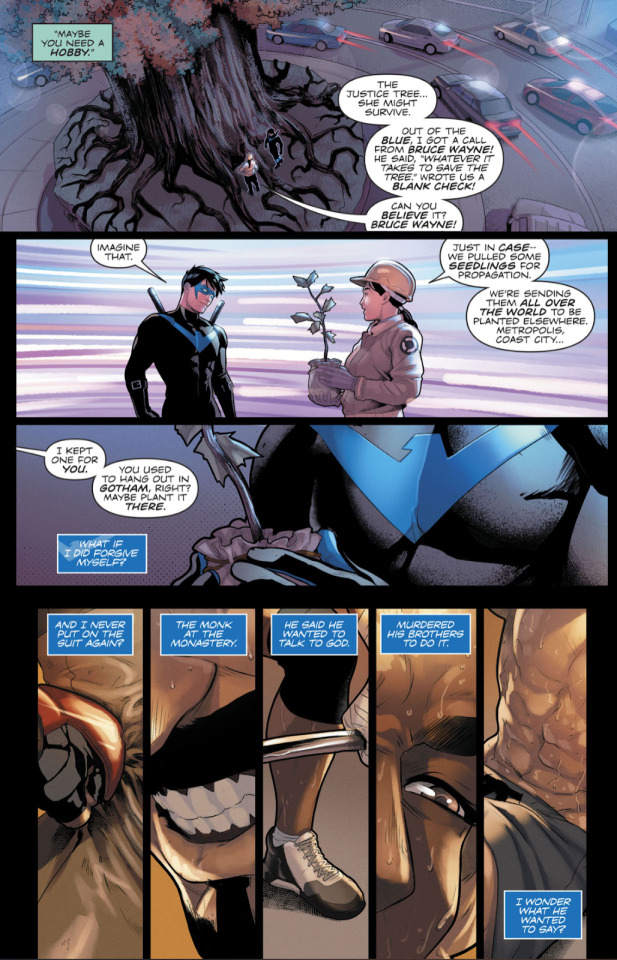
(Humphries, Sam, writer. Chang, Bernard; Campbell, Jamal, illustrator. The Untouchable: Chapter Seven: Final Judgment. Nightwing: Rebirth no. 41, e-book ed. DC Comics, 2018 pp. 22)
That being said, another big theme of this story is forgiveness and kindness, two principles that are essential to Nightwing. Dick emphasizes that no one should be judged by their actions when they are at their worst, so long as they decide to move forward and do good.

(Humphries, Sam, writer. Chang, Bernard; Campbell, Jamal, illustrator. The Untouchable: Chapter Seven: Final Judgment. Nightwing: Rebirth no. 41, e-book ed. DC Comics, 2018. pp. 21)
And yet, Dick is unable to extend this same kindness to himself. While he is able to forgive everyone around him for giving into the Judge’s temptations, he is unable to forgive himself for being unable to stop the Judge sooner.
These themes are embodied in the Justice Tree, which is threatened when the Judge is at large, and then is given a chance of salvation when he is captured by Dick and he is able to convince Bruce to invest in the efforts to keep the tree alive. The story concludes with Dick being given a piece of it to plant wherever he chooses (and he chooses close to his home, to Nightwing’s headquarter, the perfect marriage between Dick Grayson and Nightwing).
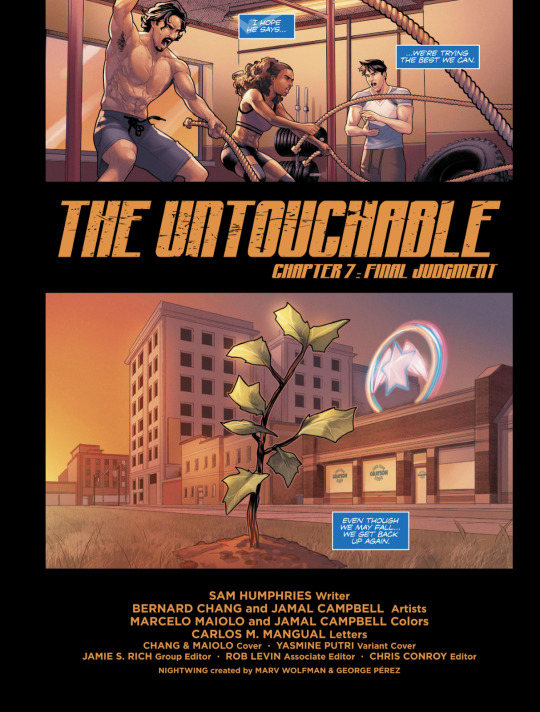
(Humphries, Sam, writer. Chang, Bernard; Campbell, Jamal, illustrator. The Untouchable: Chapter Seven: Final Judgment. Nightwing: Rebirth no. 41, e-book ed. DC Comics, 2018. pp. 23)
And that is not even to mention the way the art manages to convey so much. The tree that symbolizes justice is surrounded by the corrupt casinos. Nature is surrounded by artificial neon lights, circling in it, caging it so that it cannot branch out, cannot expand, cannot grow. The more natural, soothing colors of the tree contrasted against the bright neon colors of Bludhaven. The sharp lines of the tree vs the blurriness of the city. All of it visually conveys the main conflicts of the story that work together with its themes.
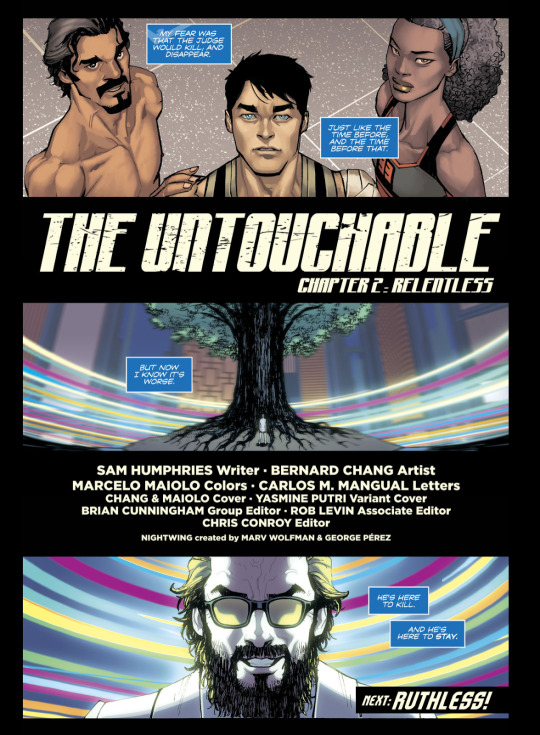
(Humphries, Sam, writer. Chang, Bernard, illustrator. The Untouchable: Chapter Two: Relentless. Nightwing: Rebirth no. 36, e-book ed. DC Comics, 2018. pp. 22)
By contrast, Taylor’s depiction of the Octopus Statue feels… Lacking. When looking at it with Babs, Dick ruminates on the history of Bludhaven and how it symbolizes Bludhaven’s resilience. He connects it to the city’s history and to how the people of Bludhaven can overcome even the most difficult challenges. In doing so, Dick also asserts his mission statement — he wants to be the safety net for these resilient people, he wants to be their protector, he wants to prop them up, to give them someone to rely on so they won’t feel abandoned.
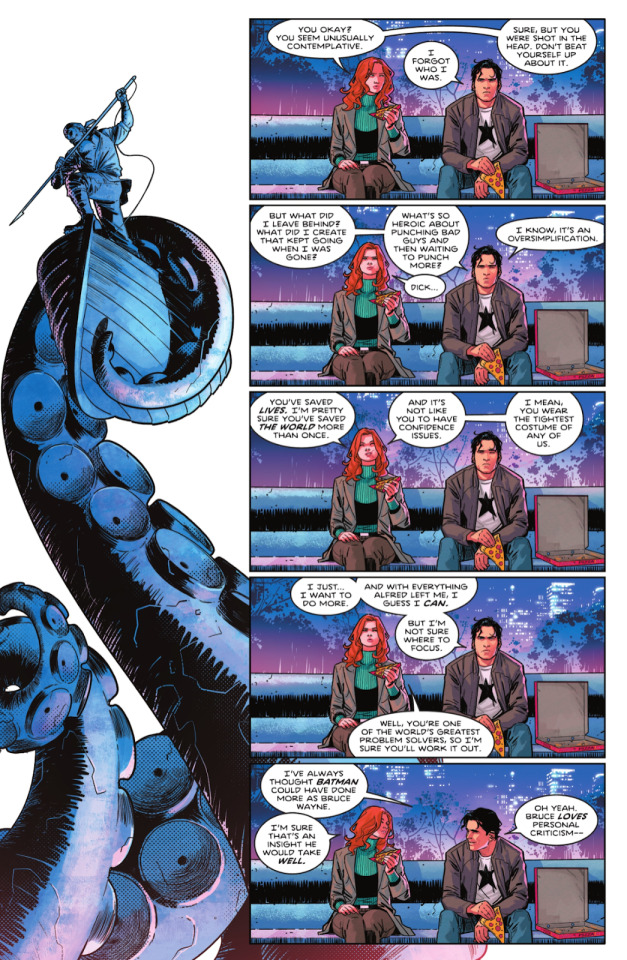
(Taylor, Tom, writer. Redondo, Taylor, illustrator. Leaping into the Light Part Two. Nightwing: Rebirth. 79, e-book ed. DC Comics, 2021. pp 07)
And yet, how many times do we come back to this one location that, in the beginning of Taylor’s run, was tied so strongly to Dick’s mission? How many times does Dick come to look at the statue? Dick is not given any crisis of faith because of the lack of conflict in the story, and yet, scenes in which he ponders whether he is going about his mission the right way while looking at this statue would have effectively shown the themes of the story and Dick’s inner struggles all while fleshing out Bludhaven.
Instead, Taylor readily abandons the statue just as soon as it is introduced. We don’t return to it, we don’t even use it as a set piece that can ground Bludhaven and make it feel like an actual place. It doesn’t make an appearance in any covers, nor in establishing shots. In fact, even its thematic symbolism is forgotten when Alfred’s statue is built. Such a decision is especially infuriating when one considers the fact that not only would Alfred hate having a statue in his honor, but that Alfred means absolutely nothing to the people of Bludhaven. He means something to the reader, but not the citizens of the city that Dick is meant to protect. In this, we see how once more Taylor’s online mindset interferes with his storytelling, replacing a set piece that was tied to the in-universe history of the city he was writing with fanservice.
(CONTINUE IN PART 2)
24 notes
·
View notes
Text
A (Negative) Review of Tom Taylor's Nightwing Run - What Went Wrong? Bludhaven (PART 2)
Introduction
Who is Dick Grayson?
What Went Wrong? Dick's Characterization
What Went Wrong? Barbara Gordon
What Went Wrong? Bludhaven (Part 1, Part 2)
What Went Wrong? Melinda Lin Grayson
What Went Wrong? Bea Bennett
What Went Wrong? Villains
Conclusion
Bibliography
Instead, Taylor readily abandons the statue just as soon as it is introduced. We don’t return to it, we don’t even use it as a set piece that can ground Bludhaven and make it feel like an actual place. It doesn’t make an appearance in any covers, nor in establishing shots. In fact, even its thematic symbolism is forgotten when Alfred’s statue is built. Such a decision is especially infuriating when one considers the fact that not only would Alfred hate having a statue in his honor, but that Alfred means absolutely nothing to the people of Bludhaven. He means something to the reader, but not the citizens of the city that Dick is meant to protect. In this, we see how once more Taylor’s online mindset interferes with his storytelling, replacing a set piece that was tied to the in-universe history of the city he was writing with fanservice.
By contrast, Humphrie’s Bludhaven is filled with specific locations that are unique to, well, Bludhaven. We have the different casinos

(Humphries, Sam. Ruthless, writer. Janson, Klaus; Campbell, Jamal, illustrator. Nightwing: Rebirth no. 37, e-book ed. DC Comics, 2018. pp. 22)
The Tiki District
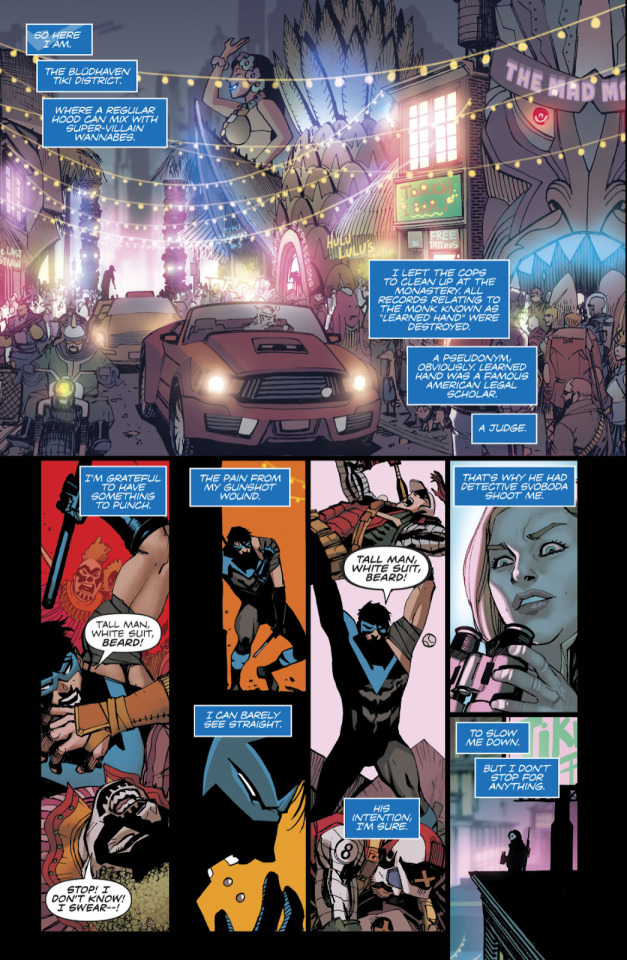
(Humphries, Sam, writer. Chang, Bernard, illustrator. The Untouchable: Chapter Two: Relentless. Nightwing: Rebirth no. 36, e-book ed. DC Comics, 2018. pp. 13)
Which greatly contrasts the darkness of the docks…
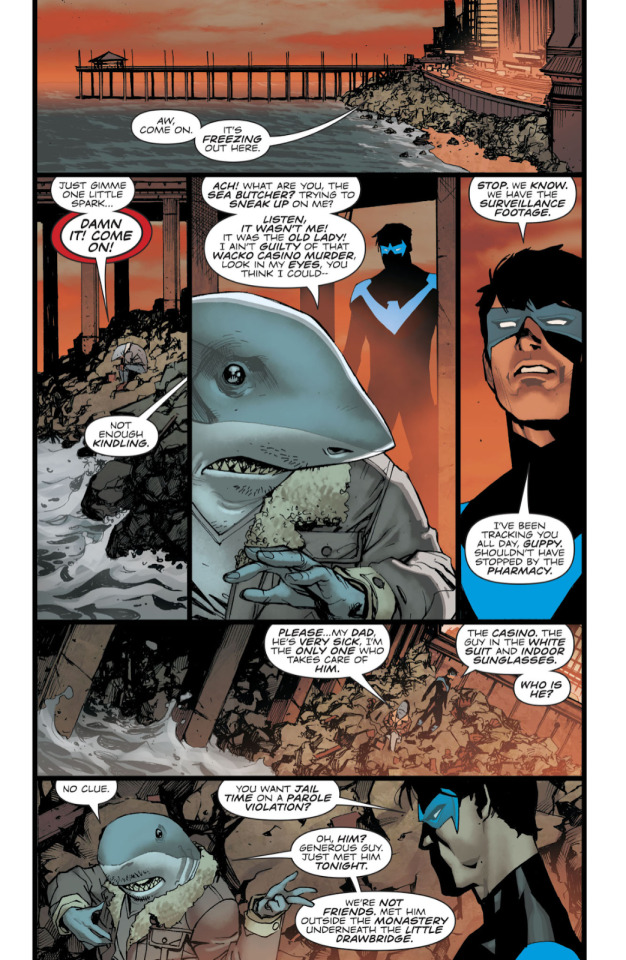
(Humphries, Sam, writer. Chang, Bernard, illustrator. The Untouchable: Chapter One: Hunter. Nightwing: Rebirth no. 35, e-book ed. DC Comics, 2018. pp. 17)
And the melancholy of the sunken city
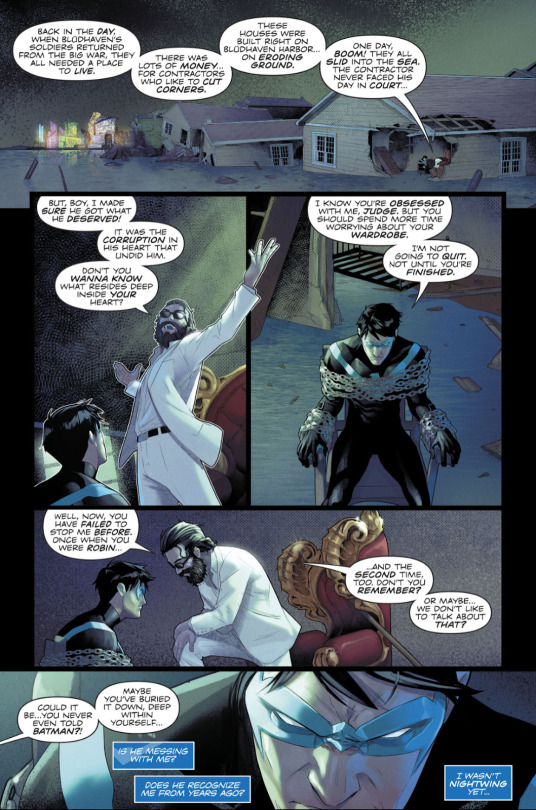
(Humphries, Sam, writer. Jimenez, Phil; Campbell, Jamal, illustrator. The Untouchable: Chapter Five:Face Off. Nightwing: Rebirth no. 39, e-book ed. DC Comics, 2018 pp. 05)
All of it is so specific that it makes Bludhaven feel alive. It gives Bludhaven an identity rather than keeping it a generic location.
Let’s take a closer look at the establishing shot of the sunken city and see how the page is laid out to emphasize the storytelling going on in the dialogue and enrich Bludhaven. There's something so visually poetic about that last panel. The intimacy between the Judge and Nightwing, the opulent throne atop a simple boat in a sunken, destroyed home.
It feels a bit like a visual metaphor for Bludhaven and corruption. Bludhaven is thriving because of the casinos, but they are also corrupt. And yet, despite their rich aesthetic, they are built on top of a tragedy, of a city that was lost and had to rebuild itself, taking advantage of a corrupt system that devastates its citizens while also being the only thing keeping them from drowning.
The lighting of the page is also so beautiful. Light coming in from above, appearing almost heavenly, and yet it makes the scene so still and lonely
During Dixon and Grayson’s runs, and during Taylor’s run, Bldhaven does not have an identity outside of Gotham and Nightwing. It is difficult to describe it without relying on those two factors. It is not impossible, of course, but those descriptions would be rather bare, relying on what one wishes Bludhaven could be rather than what is actually on the page.
In The Untouchable, however, Bludhaven can be described independent of Gotham and Nightwing. Yes, those elements are still crucial to its depiction, but rather than being all that there is to it, they serve to enhance what is already there. Dick’s interactions with people from Bludhaven further fleshes out the city while also demonstrating that they have their own lives outside of their meetings with Dick or Nightwing. Guppy, Svoboda, Lucy, Dick's clients at his gym... All of them are clear products of Bludhaven, they are affected by what happens in Bludhaven, and they interact with different parts of Bludhaven. Because they are characters with their own interiority, the reader really is able to feel the consequences of the Judge's actions.
Yet, Taylor and Redondo both refuse to pay Bludhaven any of the attention it deserves. They do not even give it the respect of making it into Gotham-light. Instead, they opt for the generic, lazy, and morally simplistic depiction that is yet more proof of just how little thought they give to anything remotely related to Dick Grayson.
Bludhaven, as it exists in The Untouchable, was built on top of a corrupt foundation, and its systems are so intertwined with the rot that you can't neatly separate them. There's no easy answer to this, no solution without a victim. It adds some nice stakes to the story, creates constraints which Dick must creatively work around, and demonstrates how Nightwing’s fight is far larger than just The Judge. It illustrates how even if Dick catches this one guy, he still has so much more to do, creating a perfect comic status-quo where the hero can progress and make a difference without eliminating conflict sources for future stories.
Through the Judge, we also get to see Bludhaven’s history, and through this evolution, we also get to see just how much Humphrey cares about Bludhaven. I have yet to encounter another writer who has devoted so much care to Dick’s city. I have yet to encounter a writer who put so much effort into making this city feel alive. Gotham is beloved by many writers and fans alike, and The Untouchable showed that Bludhaven has the potential to be just as great if only it was given to a writer who cares enough to develop it.
Needless to say, Taylor is not that writer.
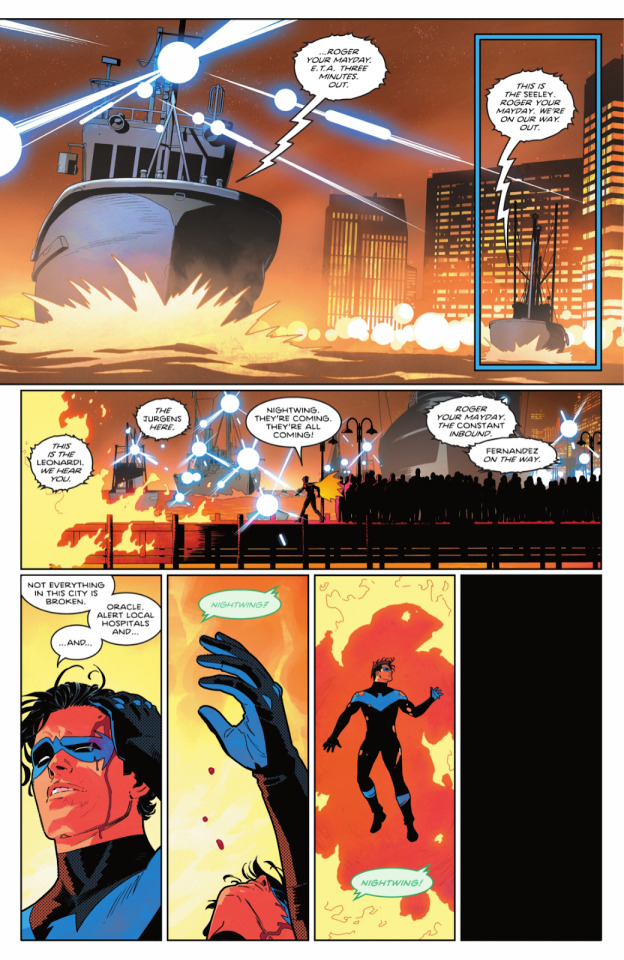
(Taylor, Tom, writer. Redondo, Bruno, illustrator. Leaping into the Light Part 4. Nightwing: Rebirth. 81, e-book ed. DC Comics, 2021. pp 13)
While this may be wholesome, the truth is that by giving such a triumphant moment early on in the story, Taylor robbed his characters of any opportunity to change, and any opportunity for a well-earned pay off later. In turn, this robbed the story of its ability to engage with its themes by creating a very simple morality. Evil can be manifested in different ways and anyone is capable of it. Perhaps not all of us will be uppercase Evil, but we're all capable of the smallest acts of lowercase evil by letting our anger blind us to what is right, not helping others because we tell ourselves we have to survive, upholding unfair systems because they benefit us.
The city of Gotham does something similar. We have the evil of the rogues, but we also have the crime families, a myriad of corrupt institutions -- from the police department to the justice system to the politicians who are in the pockets of those on the top – and the ordinary citizens who have been disillusioned by the hardship they face. We have greed on a massive scale but also a small and personal one that is far more relatable, we have chaos of the Joker and we have more relatable pettiness, selfishness, apathy, and cruelty.
Some of these play a larger role than others, their influence has a wider reach, but it is the different layers that makes Gotham feel so difficult to tackle. There’s a reason why Batman's origin story works best when it's just about a mugging gone wrong, and when Joe Chill is just a simple man who fired two shots in a dark alley because he wanted a pearl necklace. There's a reason why Bruce stays in Gotham rather than trying to save the entire world all the time. Batman, after all, is not about fighting the just grander Evil, but about bringing justice to everyone, even in what may be perceived to be a small scale.
While I do not believe Batman: The Knight was perfect (and, indeed, I have a lot of problems with it and dislike Zdarsky’s current Batman run nearly as much as I dislike Taylor’s Nightwing), I do think that Zdarsky did a good job when having Ra’s Al Ghul confront Bruce on this matter.
In #09, Ra’s challenges Bruce to work on a macro scale, and Bruce explores that idea before deciding he needs to work on a more personal level.
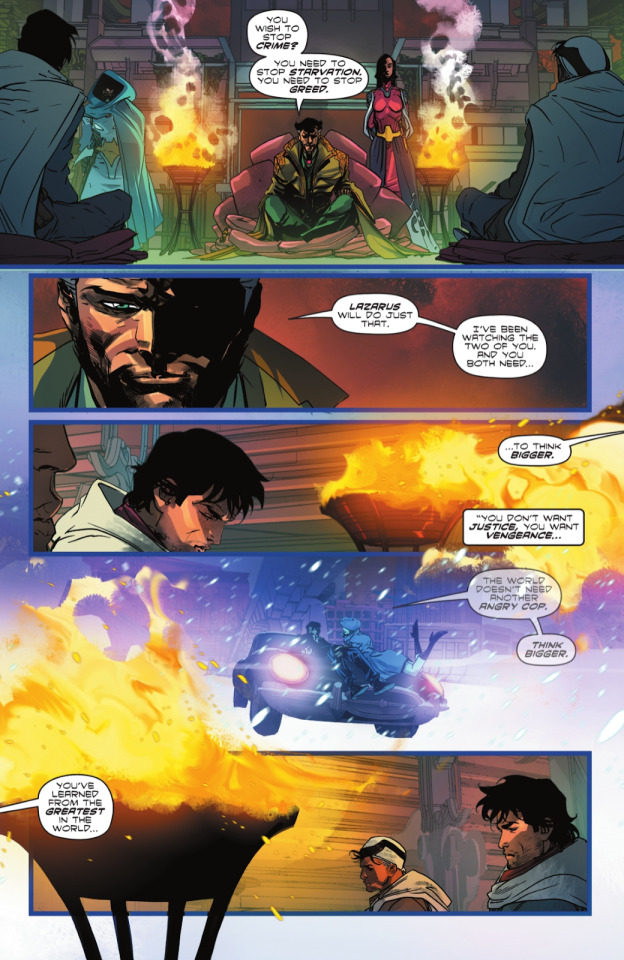
(Zdarsky, Chip, writer. Di Giandomenico, Carmine. The Knight Part 9. Batman: The Knight. 09, e-book ed. DC Comics, 2022. pp 13)
Bruce’s world did not fall apart because of a war or an alien invasion, but that did not mean his pain is invalid. There might be far more important things than catching a mob boss who orchestrated the murder of two circus acrobats, but that doesn’t mean that their lives did not matter or that their son does not deserve to see justice. One of the beautiful things about the detective stories of Batman and of Nightwing is that they treat everyone’s trauma with equal respect. Batman and Nightwing aren’t just about catching the bad guy, they are about giving the victim a chance to heal by offering them closure.
You can also observe the dichotomy of these two evils in The Untouchable. The entire plot of The Untouchable is about the Judge using people’s desires to corrupt them, luring them into committing evil deeds. At the same time, the story does not condemn those who fell prey to the Judge’s promises. Instead, it portrays them as complex individuals, and this reaffirms the themes of corruption through desire and the necessity for forgiveness.
Lucy, for example, is not vilified for betraying Dick. She did the Judge’s bidding, but she is not a bad person. She is still Dick’s friend and cares deeply for him. And yet, her choices are not portrayed as excusable. The comic perfectly balanced having Lucy not be a bad guy for what she did while also making it clear that she was still in the wrong for accepting the Judge’s offer. She is not Evil but she made an evil choice and she needs to be held accountable for that.
This plays into the idea that to Dick, people are not naturally Good nor naturally Evil. They just are who they are, they have the potential for both, and it's their choices that dictate their nature.
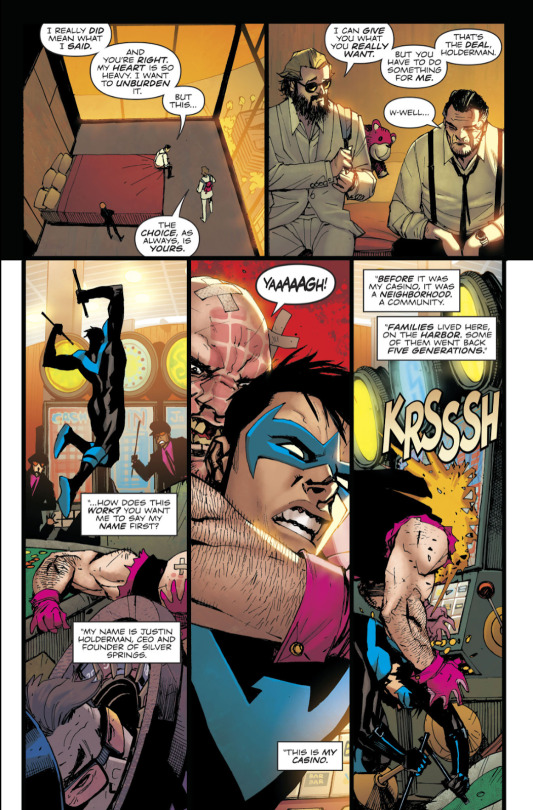
(Humphries, Sam, writer. Chang, Bernard, illustrator. The Untouchable: Chapter Six: Deep Dive. Nightwing: Rebirth no. 40, e-book ed. DC Comics, 2018. pp. 18)
And as mentioned previously, Grayson also played with such ideas when she introduced the character of Sophia into the story.
Taylor flirts with similar ideas without ever committing to them. His Bludhaven supposedly has corrupt institutions, big men on top who oppress others in order to stay rich, but to lay every wrong and every sin in the city at Blockbuster’s feet is morally simplistic. It's flattening. Immature. It's, frankly, boring. It just doesn't work on a narrative level. Most importantly, it makes Nightwing's presence superfluous.
Once more, I must emphasize that I do not believe that one must incorporate a social commentary in the themes of one’s story. However, as Taylor's narrative seems to signal he wants to discuss these matters, I think it is only fair to point out how his actual writing is uninterested in examining the complications inherited in these subjects. Taylor wants those big, meaningful moments that claim to say something thematically important, yet he creates easy-to-take down strawman villains who can take the blame for everything while wrapping them in the trappings of social commentary.
Nothing in Taylor's supporting characters, conflicts, villains, or city were created to challenge Dick in any way. Part of the reason why you can feel Bruce's genuine love for Gotham is that that city is always challenging him, always giving him a reason to give up, but Bruce never does. Again and again, Gotham shows itself as a place that perhaps should not be saved, that is too rotten, literally cursed to bring out the worst of humanity. It would be easier to burn the whole thing down and start new.
But Bruce doesn’t do that. He still sees something in Gotham worth saving. No matter what he uncovers, Bruce won’t give up, and that makes us, the readers, root for Batman and root for Gotham.
Bludhaven should challenge Dick in a similar way. But in this run, it doesn't. Dick's assertion that the citizens of Bludhaven are good and there are only a few bad apples ruining it for everyone is never challenged. Dick is never asked to question his beliefs. When he decided that the solution to one of Bludhaven's biggest problems (homelessness) was just to create a shelter, Dick is never challenged for his savior mentality, he never faces push back from those above him or below, is never paralyzed by bureaucracy, never has to deal setbacks that force him to re-strategize. He's just... Proved right. And everything goes on smoothly.
Taylor’s approach gives Dick no room to grow and no room to stand his ground. I can’t help but think how much more powerful Dick’s own belief in Bludhaven and its people would have been if, during that earlier scene when the tent city was in flames, no one came to help. Nightwing and Robin would have had to save everyone on their own, and Dick would be faced with the difficult to swallow possibility that maybe he’s wrong. Maybe the people of Bludhaven are too disillusioned to do good. Maybe Babs and Tim, both characters who are known for being pragmatic, would even tell him so. But he refuses to accept that. As he looks upon the octopus statue, Dick affirms the resilience of the city and how it does not need to come at the cost of kindness. Bludhaven is worth saving, its people are worth saving, and Dick will continue to believe in them, even though he was just given a reason not to.
Again, I must emphasize that it is fine if a person is not interested in writing a story about this. Not every superhero story needs to explore these real-world, complex themes. One of my personal favorite Batman stories (and one I believe should be required reading for any Batman fan) is Murderer/Fugitive. While there are certainly themes of forging of identity, the story is far more concerned with what the forging of one’s identity means in the specific context of Batman rather than that of the real world. That is not to say you couldn't do an analysis on identity about Murderer/Fugitive, but the work as a whole serves more as a commentary on Batman, and it is in conversation with the popular idea that "Bruce Wayne is the mask that Batman wears."
And just because one wishes to engage with themes of class and economic inequality, it does mean one needs to tackle it directly. Again I must bring up the modern masterpiece that is Scott Snyder’s Court of Owls. That story beautifully uses the fantastical and noire elements of the Court and the creation of the Talons to engage with themes of wealth inequality and to explore Bruce’s complex relationship with Gotham. The secret cult, of superhuman assassins, and the murder mystery element provide enough distance between the real world issues and the story itself that Snyder has the creative freedom to play with his characters and narrative while the specificity allows him to dig deeper than he ever could should he have decided on going for a broad approach.
Taylor tries to ground his themes by using real-world issues, but he refuses to engage with what those real-world issues look like in, well, the real-world. He deals with them in the context of his morally simplified, perfect little society. As Braxis perfectly pointed out “When Dick starts a charity to help the homeless he never actually explains how that will be done, what causes homelessness, or what the homeless are asking for support.” (Braxi, Steve, “On Superman, Shootings, and the Reality of Superheroes” Comics Bookcase, September 2021)
Taylor’s Bludhaven demonstrates a frustratingly simplistic view on morality that prevents the story from engaging with these issues with the care they deserve. By not fleshing out the city, by denying Dick’s interactions with other characters, Taylor creates a world of simple morals. This means that rather than engaging with the progressive ideology he claims to care about he is simply creating the appearance of social commentary and rich themes. This demonstrates that he’s not actually interested in the work required to make that work, only the prestige that comes from it.
21 notes
·
View notes
Text
A (Negative) Review of Tom Taylor's Nightwing Run - What Went Wrong? Melinda Lin Grayson
Introduction
Who is Dick Grayson?
What Went Wrong? Dick's Characterization
What Went Wrong? Barbara Gordon
What Went Wrong? Bludhaven (Part 1, Part 2)
What Went Wrong? Melinda Lin Grayson
What Went Wrong? Bea Bennett
What Went Wrong? Villains
Conclusion
Bibliography
Things do not get any better when it comes to Dick’s relationship to Melinda.
As I believe it is important to own up to one’s biases, I’ll begin by admitting that I dislike secret-sibling tropes. However, the problem present in Melinda’s character does not revolve around the concept of her existence, but rather in the fact that her status as Dick’s sister adds nothing to the story. Taylor does not take advantage of her existence to add to Dick’s backstory, complicate his views of his parents, to add conflict to the plot, or to offer on-screen character and relationship development. In failing to have his original character live up to her full potential, Taylor reduces her to a deus-ex-machina who only appears to either save Dick at the right time, or to put him in danger at the right moment.
That is why in execution, Melinda’s existence is irrelevant. While I would never want John Grayson to be cheater and I do not want John and Mary's marriage to be tarnished, that route would have offered conflict, for it forces Dick to grapple with the reality that parents were not the infallible individuals he remembers.
Instead, Melinda is very conveniently conceived during the span of time between John and Mary becoming an acrobatic duo and them getting together. They were already in love, so Dick does not have to worry about Melinda's mom being John's long lost lover and Mary having been a rebound. Yet, because John and Mary were not yet together, John remains a good person as he was not unfaithful. Melinda's mom doesn't resent Mary for ending up with John while she was stuck in an abusive relationship. Melinda doesn’t resent Dick for having known their father while she lived with Zucco. Neither does she feel any love towards Zucco or seeks his approval — which would have been another interesting and understandable source of conflict. After all, though he was an awful man, husband, and father, for a good part of Melinda’s life, he was the only father figure she had, and it is very common for children who were raised by an abusive guardian to still desire their affection.
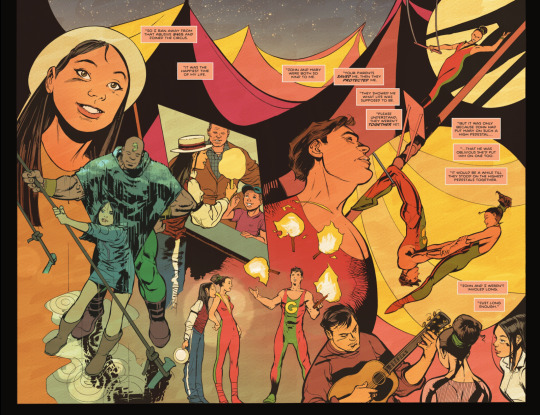
(Taylor, Tom, writer. Redondo, Bruno, illustrator. Leaping into the Light Part Five. Nightwing: Rebirth. 82, e-book ed. DC Comics, 2021. pp 14)
The way in which Taylor quickly and neatly wraps up this story does little to add to either Melinda or Dick’s character. Furthermore, Dick readily believes Melinda and Meilin when he is told their story. He does not know them, yet he simply accepts their words without requiring any evidence, without asking many questions, and without following it up with an investigation.
Neither do we see him experience denial or any other form of human emotions to such a monumental discovery. In #83, when Dick returns to his apartment, he tells Babs “You heard? I have a sister. And even better… There’s a chance she’s not evil,” to which she replies “I hear. You need to talk about it?” Rather than replying, or, indeed, talking about how he feels about this revelation, Dick instead passes out. As readers we never get to see if said conversation happened (which would also develop Dick and Babs’ relations), and so we never get to see Dick grapple with this life changing revelation..
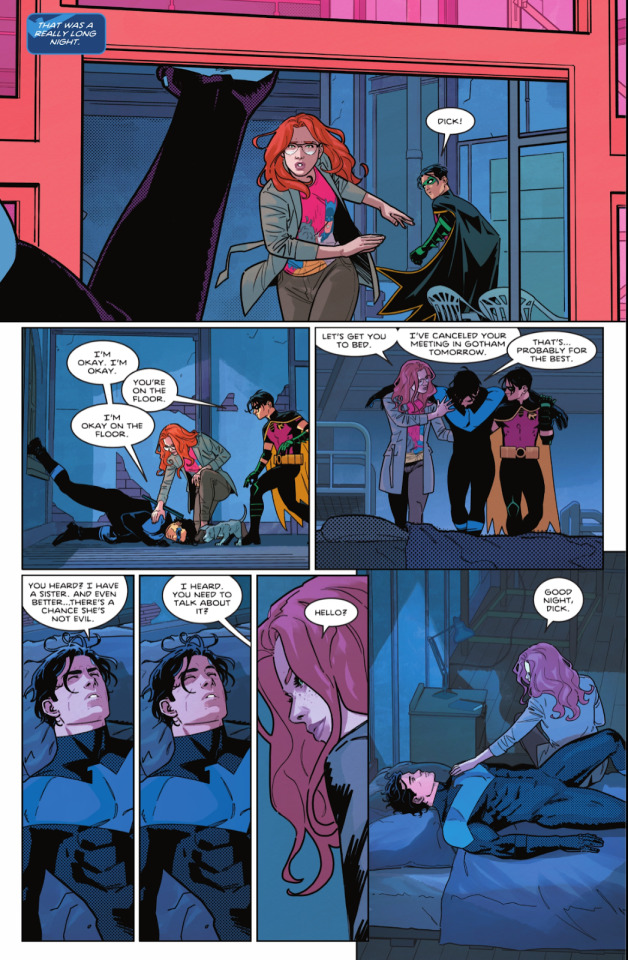
(Taylor, Tom, writer. Redondo, Bruno, illustrator. Leaping into the Light Part Six. Nightwing: Rebirth. 83, e-book ed. DC Comics, 2021. pp 12)
Conveniently, Melinda’s morals and her approaches to solution also perfectly align with Dick’s own. Not only is she not the bad guy Dick originally thought she was, but she is actively working against those Dick wishes to stop. And, again, Dick takes her word for it without a second thought. Dick appears skeptical for a mere second before Melinda gives him an out by asking if he has “difficulty believing someone could have a double life.”

(Taylor, Tom, writer. Redondo, Bruno, illustrator. Leaping into the Light Part Six. Nightwing: Rebirth. 83, e-book ed. DC Comics, 2021. pp 04)
This question misses the point of what should be Dick’s understandable suspicion. Just because Dick can believe someone can live a double life, it does not mean he should immediately accept the words of a woman he has never met before without any evidence. Neither should he just take her word for it when she says that she “brought down two crime bosses from within” and that she wishes “to do the same for Bludhaven.”
Just as baffling as the fact that Dick immediately believes is the fact that he is ready to include her in all of his plans to take down Blockbuster without even investigating whether she might have ulterior motives.
And this goes both ways. When Melinda claims to have the same goals as Dick, she does not question Dick’s motivations. Neither does she question the legality of having a vigilante in the city, working outside of the system.
The problem is not just that they have the same objective — take down Blockbuster — but that their approach to said objective is the exact same, that their beliefs in what would be best for Bludhaven perfectly align, and so they trust each other with critical information almost instantaneously, denying the reader the opportunity to read them about them earning each other’s trust by trying to persuade the to their side.
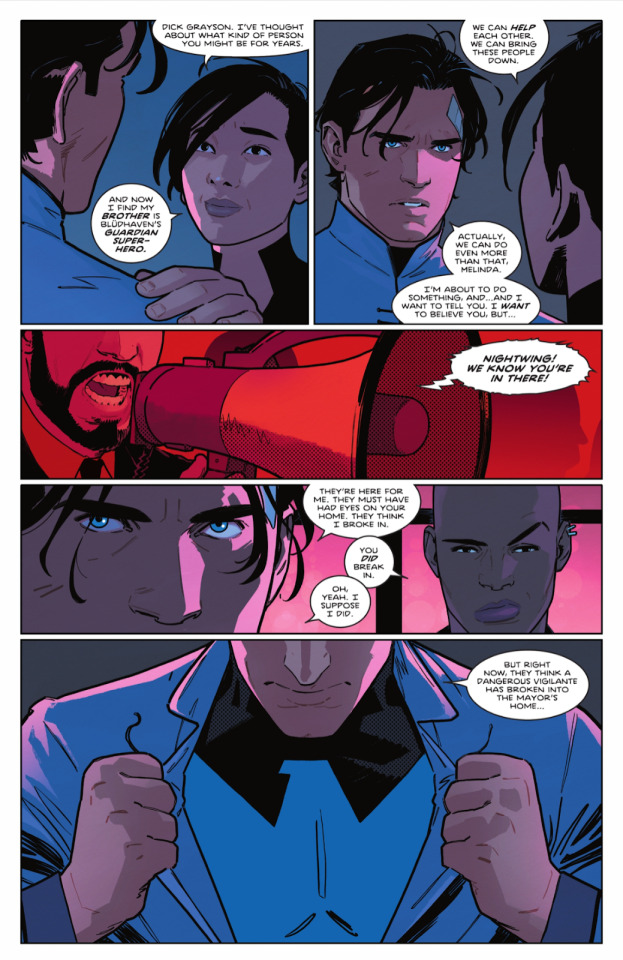
(Taylor, Tom, writer. Redondo, Bruno, illustrator. Leaping into the Light Part Six. Nightwing: Rebirth. 83, e-book ed. DC Comics, 2021. pp 05)
fter meeting one another, Dick and Melinda work closely together, and soon they start to think of themselves as siblings. This, however, happens off-screen. Melinda and Dick hardly ever appear together on the page, and Dick only thinks of her when it is convenient to the plot.
As such, we are left with a significant change to a character’s backstory without having any conflict or significance created by this new addition. Melinda is not evil, so there's no conflict to be added. Melinda and Dick's morals not only perfectly align, but their methodology does as well. Dick is also not suspicious of Melinda, and Melinda views vigilantism and Nightwing’s presence in Bludhaven as a positive. There are no secret identity issues where Melinda doesn't know Dick and Nightwing are the same person and has contradicting feelings for each persona. Since Dick immediately takes her word when she claims to be his sister and when she claims to “not be evil,” there is no need for her to win him over. There is no need for Dick to get Melinda to trust him. In other words, there is no room for this relationship to develop in front of the readers’ eyes so that we can grow to care for their bond and become invested in their dynamic. Every potential conflict or development is resolved and achieved as soon as the idea of Dick having a secret sister is introduced to the reader, making so that the storyline goes from its beginning to its endpoint in just two issues.
This further destroys Dick’s characterization. Rather than trusting, Dick comes across as gullible, as he will blindly take the words of others when they tell him they are not evil. Dick comes off as incompetent, as he was unmasked so quickly and so easily when trying to investigate Melinda. And Melinda becomes a plot device, not a character. She is a deus-ex-machina who is there to call Dick when Blockbuster is going to try to kill him so Dick can escape at last second
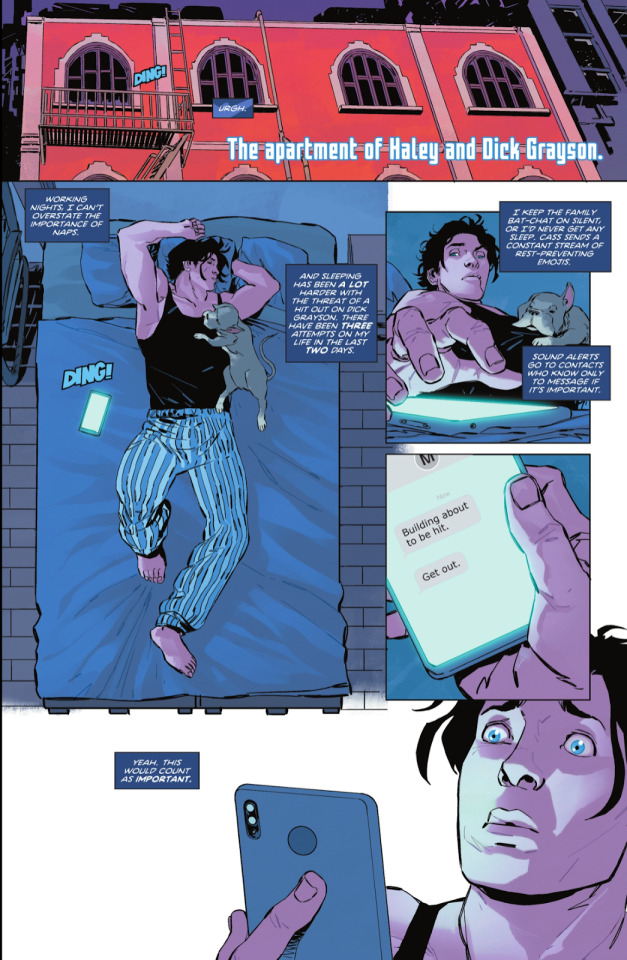
(Taylor, Tom, writer. Redondo, Bruno, illustrator. Get Grayson Act Three. Nightwing: Rebirth. 90, e-book ed. DC Comics, 2022. pp 04)
Or to bring Dick to danger when the plot needs Dick to be in danger.
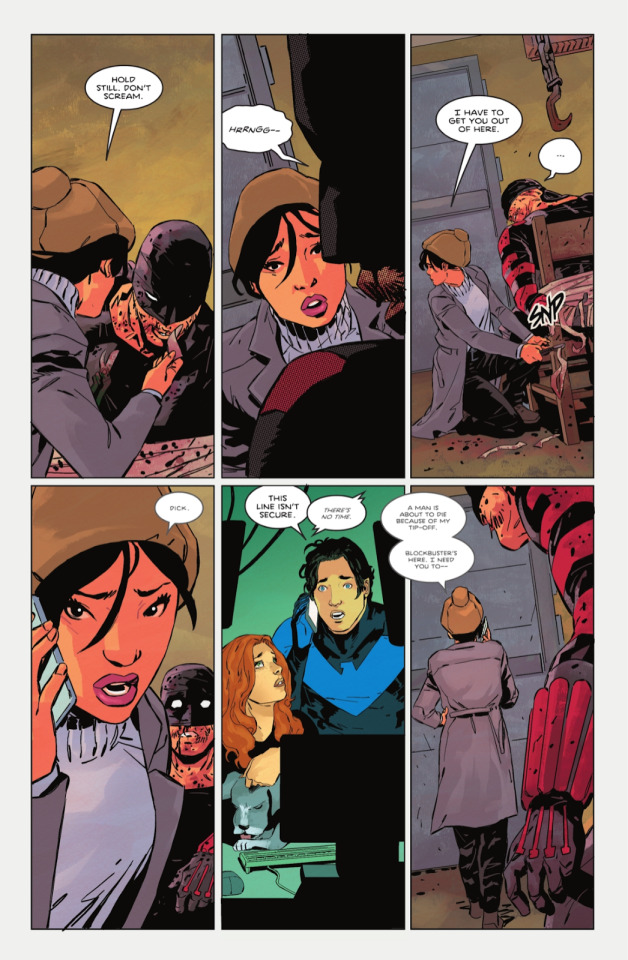
(Taylor, Tom, writer. Redondo, Bruno, illustrator. The Battle for Bludhaven’s Heart Part Three. Nightwing: Rebirth. 94, e-book ed. DC Comics, 2022. pp 22)
A lot of this could have been avoided if Melinda just wasn't Dick's sister, and instead they were made into reluctant allies. There would be no reason for her and Dick to spend time together outside of Nightwing-business or develop a sibling-bond, and without the Grayson connection, there would be the tension of Dick not knowing whether she is a threat. Losing the Grayson connection would also allow Melinda to become her own person, with her own history and interiority outside of Dick, John Grayson, and Zucco. She, too, could have become a face of Bludhaven so that her relevance to the plot would be through the city rather than Dick’s past.
But that would require Dick to have meaningful interactions with a woman who is not related to him and who is not Barbara Gordon, and there would have been the threat of any tension between Dick and Melinda to be seen as romantic or sexual. It would have also required Taylor to put in the work to make an otherwise everyday human into someone who can excel in her work despite her ordinariness.
Instead of letting the audience witness Dick and Melinda grow closer to one another, their bond as allies, friends, and siblings is developed off-screen. Taylor opts to skip over the interesting and messy steps that it takes to create such a relationship by instead having them immediately like and trust one another.
As I said in the beginning of this section, I was never personally going to like "Dick's secret sibling" concept, but I could have still liked Melinda for her own character. Or I could have fallen in love with the sibling relationship she would build with Dick, had I been allowed the chance to witness it grow for myself. But Taylor makes no effort to endear his readers to Melinda as a character or to her relationship with Dick. Instead, she becomes the perfect example of so many of Taylor’s weaknesses as a writer — his distaste for conflict; his tendency to show and not tell; his wanting to create plot twists that look shocking in a social media post while having no desire to follow through the consequences of said plot point; his wanting to create emotional pay-offs without putting in the work beforehand; his complete lack of understanding or care for Dick's character. Melinda embodies all of these problems.
21 notes
·
View notes
Text
A (Negative) Review of Tom Taylor's Nightwing Run - What Went Wrong? Bea Bennett
Introduction
Who is Dick Grayson?
What Went Wrong? Dick's Characterization
What Went Wrong? Barbara Gordon
What Went Wrong? Bludhaven (Part 1, Part 2)
What Went Wrong? Melinda Lin Grayson
What Went Wrong? Bea Bennett
What Went Wrong? Villains
Conclusion
Bibliography
I wish to spend this part of the essay examining how Taylor’s appropriation of Bea’s character betrays his complete disregard towards the ordinary people. Admittedly, this section is a late addition to the essay. As I was going through my edits, Nightwing #107 was released and Taylor’s handling of Bea was simultaneously so atrocious and so relevant to the topics I wish to discuss that I was unable to leave it untouched.
I should also note that this section was written and edited long before the Nightwing Annual written by Travis Moore was released. I considered completely cutting this section as a result, or to add a section addressing Moore’s (very bad, in my personal opinion) retconning of Bea, as well as how it tainted Bea and Ric’s relationship (what, in the view of many, was one of the few redeeming qualities of the Ric arc). But I decided to instead leave this section intact, for while Moore’s Annual adds additional context for this section, it does not change the point I wished to make.
Bea was always a complicated character when it came to Taylor’s run. She was the elephant in the room, her absence felt yet unspoken. Dick loved her not too long ago. She was there for him when Babs and his family abandoned him because he could not meet their expectations. She gave him a place to belong, she gave him the support he needed, and she fought for his well-being not because Nightwing needed to return, but because she loved him.
And yet, when Dick regained his memories, Taylor completely ignored her existence. Rather than dealing with the aftermath of regaining his memories and dealing with the incredibly complicated ordeal of sorting through who he was before losing his memories, who he was as Ric, and who he is going to be now that those two parts of him are combined, Taylor decided that he would instead create a soft reboot. This meant that while the Ric arc was acknowledged as having happened, its consequences, events, and characters were, for the most part, ignored.
And that included Bea.
We can see this in how Taylor decided that rather than allowing Dick to be single for a while as he regained his footing, he immediately started to lay the groundwork for Dick and Babs’ romance, making it clear as early as #79 that this would be a major point in his story.
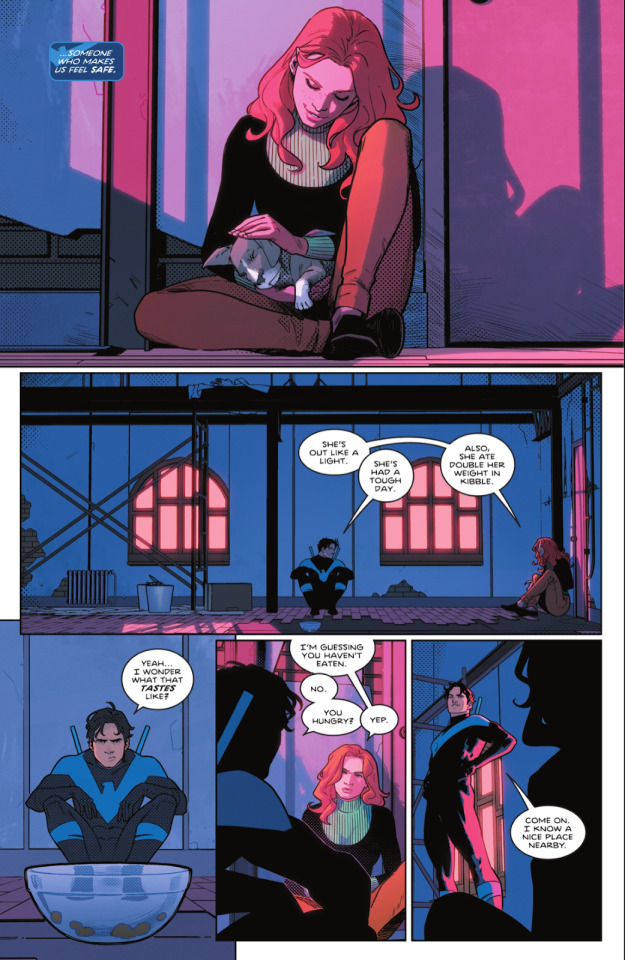
(Taylor, Tom, writer. Redondo, Bruno, illustrator. Leaping into the Light Part Two. Nightwing: Rebirth. 79, e-book ed. DC Comics, 2021. pp 05)
Never, during those early days of Dick and Babs’ romance, was the fact that Dick just got out of a serious relationship with another woman whom he was deeply in love with acknowledged.
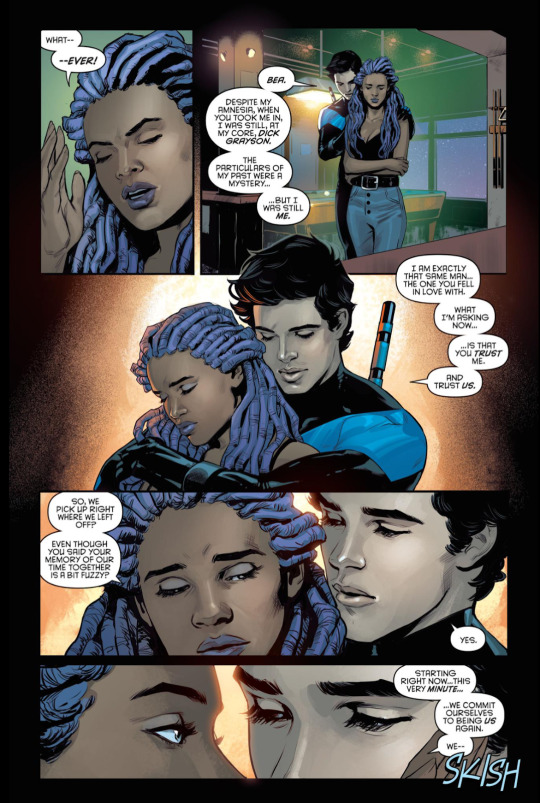
(Jurgens, Dan, writer. Cliquer, Ronan; Moore, Travis, illustrators. Who is Dick Grayson? Nightwing: Rebirth. 75, e-book ed. DC Comics, 2020. pp 36)
Never did Dick have the time to process the way Babs treated him while he was Ric, nor did Babs get a chance to apologize for the unreasonable demands she made of him while he recovered from a traumatic brain injury.
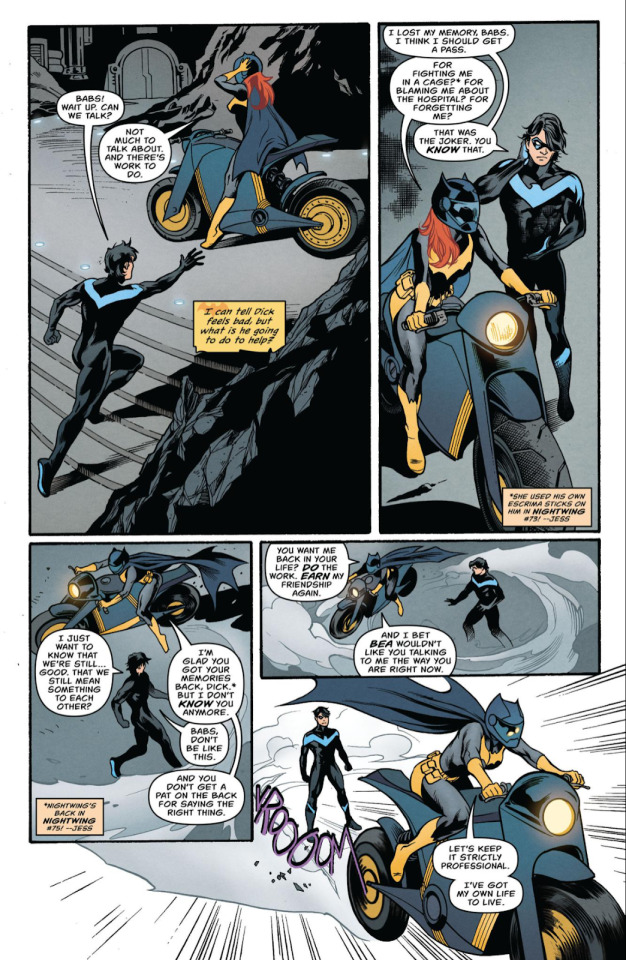
(Castellucci, Cecil, writer. Sauvage, Marguerite; Lupacchino, Emanuela; Aneke, illustrators. Little Wonders. Batgirl: Rebirth. 50, e-book ed. DC Comics, 2020. pp 14)
Never did Dick and Babs have a conversation about whether they should wait for Dick to heal before proceeding forward with a serious relationship, what it meant for Dick to be with someone who only knew a version of him from years ago, and if the him of now could be the same person Babs once knew and loved. They never had to reconcile their time apart. They never had to wonder what Dick’s relationship with Bea meant now that he recovered his memories. They never had to have a serious and mature conversation where they figure out what is best for them as individuals and if what they wish to have now is even possible given their circumstances.
Just as important, never did Dick seek Bea, who is a Bludhaven native who worked with homeless individuals, for her opinion on the best ways in which this problem could have been addressed.
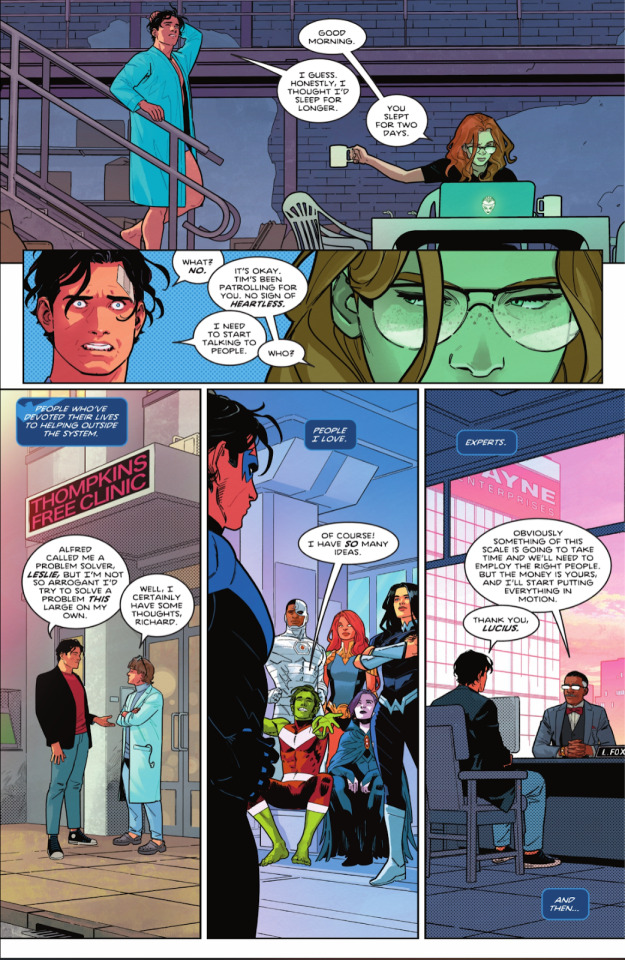
(Taylor, Tom, writer. Redondo, Bruno, illustrator. Leaping into the Light Part Six. Nightwing: Rebirth. 83, e-book ed. DC Comics, 2021. pp 13)
There are ways in which a Dick and Babs romance could have developed slowly while taking all of these conversations into consideration. There are ways in which Dick could have examined his relationship with his family and friends from years as Dick Grayson and the friends he made as Ric, and if those two worlds could exist as one. There were a myriad of ways in which the aftermath of Ric’s existence could have not only been acknowledged, but also addressed in a mature story about recovery and healing while still giving Dick a fresh start and treating Taylor’s run as a good onboarding point for new Dick Grayson readers (the memory recovery and reassessment of relationships could have provided ample opportunities to explore Dick’s history and provide context and information for new fans). But rather than doing any of this, Taylor decided to ignore all of these complicated affairs and treat his run as if it were Nightwing’s very first issue.
As I said before, I do not wish to go into the merits of whether this was the right or wrong decision. But it was a decision nonetheless, and nowhere else was its effect more felt than in not only Bea’s absence, but the complete erasure of her character. Rather than making it so she just wasn’t a part of Dick’s life anymore, her existence was never acknowledged, never commented on, her absence never mentioned. When Taylor started his new run and decided to skip Dick’s healing process and to start a new romance between Dick and Babs he also, as a result, removed Bea from existence.
Now, I cannot know why he recently decided to walk back this decision. My best guess is that he witnessed the push back against it and decided that rather than stick to his plan, he would quickly and, quite frankly, messily deal with said criticism by having Bea play a part in a story arc.
The warning sign that this was going to be handled poorly appeared early on, when the narrative mentioned that it had been two years since Dick recovered his memory. Again, I cannot know for certain why Taylor made such a decision, especially as there had been no indication of time passage up until that point, but my best guess is that once Taylor decided to bring Bea into the narrative, he realized how badly it would reflect on Dick to have gone from his romance with Bea to one with Babs.
However, what was far more offensive was how Taylor took a character whose big draw was the fact that she was just a regular person and decided that, in order to make her worthy of his narrative, she must have been a vigilante as well.
When Dick was confused, hurt, trying to discover who he was and trying to distance himself from vigilantism, Bea was a safe harbor. In an universe so filled with super-powered individuals, with humans capable of taking down monsters by themselves, with individuals whose hacking skills are so great they could shut down governments, Bea’s ordinariness was a breath of fresh air. She grounded the narrative and became a guide to the regular world of Bludhaven, the world that Nightwing once protected and that Dick and Ric both belonged to. Through her volunteering, she showed that you can still help others even if you’re not in a position of power; through her compassion towards Ric she showed that even when someone is at their lowest, they are still worthy of love; and by taking on Joker and Court even though she was just a regular person, she showed that even the most ordinary person can be brave, can be heroic, can protect those they love.
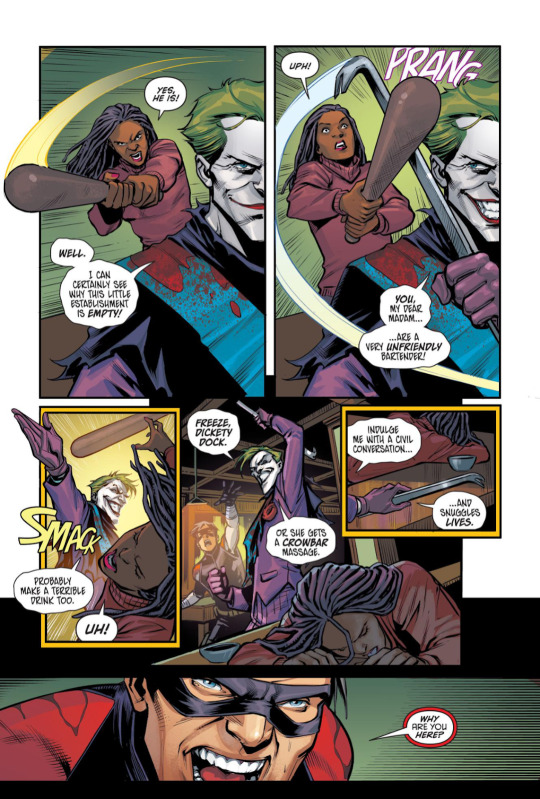
(Jurgens, Dan, writer. Cliquet, Ronan, illustrator. War for the Mind Nightwing: Rebirth. 71, e-book ed. DC Comics, 2020. pp 19)
A lot of Bea’s importance in the narrative came from the fact that she was just an ordinary citizen. Her “lack” of specialness was what made her special. She gave the ordinary people of Bludhaven a face and a voice, and she served as a reminder of what it is that the heroes we love fight for. As someone who was also not involved in vigilantism, she could also give Dick a form of unconditional support that it would be difficult to get from those whose lives are often dictated by life-or-death stakes. As someone who was not involved with the Bats, the Supers, the Titans, or any other hero, she had just the right amount of distance to offer him impartial advice that is not colored by a complicated history with either characters or the conflicts of being a vigilante. She could give him an alternative perspective that he, his family, and other heroes would ordinarily have lacked. She could remind him and the reader of the importance of the little things, she could be his anchor, and she could be his friend and his friend only. She could be the person who was always on Dick’s side. Not Nightwing, not Robin, not Batman, not Agent 37; not the detective, the superhero, the leader; not the boyfriend, the older brother, the mentor, the son. Just Dick.
But instead of realizing the specialness in her “lack” of specialness, Taylor instead decides to make her into a secret pirate queen, with a long and troubled family history that involves all those high stakes. Most insultingly, not only does Taylor physically remove Bea from Bludhaven for her vigilantism operations by making her operate in the sea rather than on land, he also has Dick specifically call out that Bea’s incredible actions are now explained because she was a pirate queen.
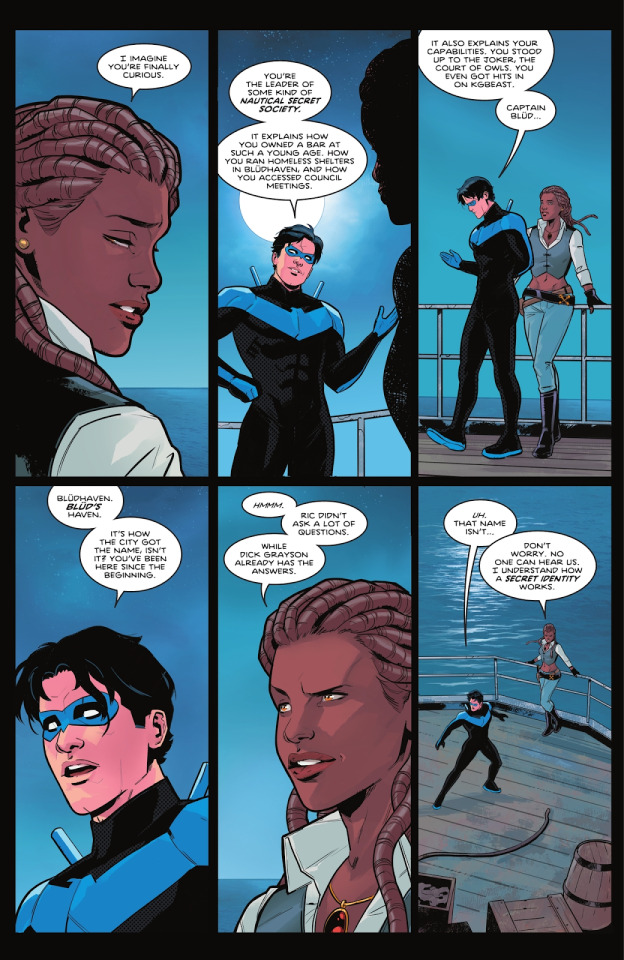
(Taylor, Tom; Conrad, Michael, writer. Byrne, Stephen; Acuna, Serg, illustrator. The Crew of the Crossed Part Three. Nightwing: Rebirth. 107, e-book ed. DC Comics, 2023. pp. 08)
This one line is truly revealing of Taylor’s thoughts of ordinary characters and the ordinary people of Bludhaven. He insults Bea and destroys her character by very blatantly stating that her “ordinariness” made her a liability in his story. Bea could not have been helpful to others despite lacking power because she cared, because she wanted to help, because she realized that even regular people can make a difference — she had to be a pirate. Bea could not have taken on the Joker and the Court because she loved Dick and that love gave her courage to fight for him — she had to have been a vigilante. Rather than empowering, now Bea’s strength and capabilities are waved away as her being another vigilante.
In trying to “make her special,” Taylor took away what made her special. Not only that, by having it Dick state this sentiment in these words, Taylor is making it so rather than believing that we all have the power to make the world a better place, no matter how “ordinary” we may feel, we can only do so if we are one of the few who have this specialized training and abilities. Ordinary people, according to Taylor and to Dick, do not have the courage to face difficulties or take on bad guys for the sake of our fellow humans or for those we love. We are incapable of doing that. It is only once someone is “special” that such traits “can make sense.”
This complete disregard towards the value of ordinary humans can also be observed during the brief time in which Dick gained power during Taylor’s run. Rather than using this as an opportunity to emphasize that Dick does not need powers in order to be great, the entire arc has this wistful tone, as if Taylor wished he could permanently make Dick into a superpowered individual. “Wouldn’t it be cool,” the arc implies. “If Nightwing could have all of these superpowers?” Taylor goes as far as having Clark, a character who has known Dick since he was a child and who would have known that Dick never needed the assistance of powers to be a hero, lament the fact that Dick’s talents were only temporary.
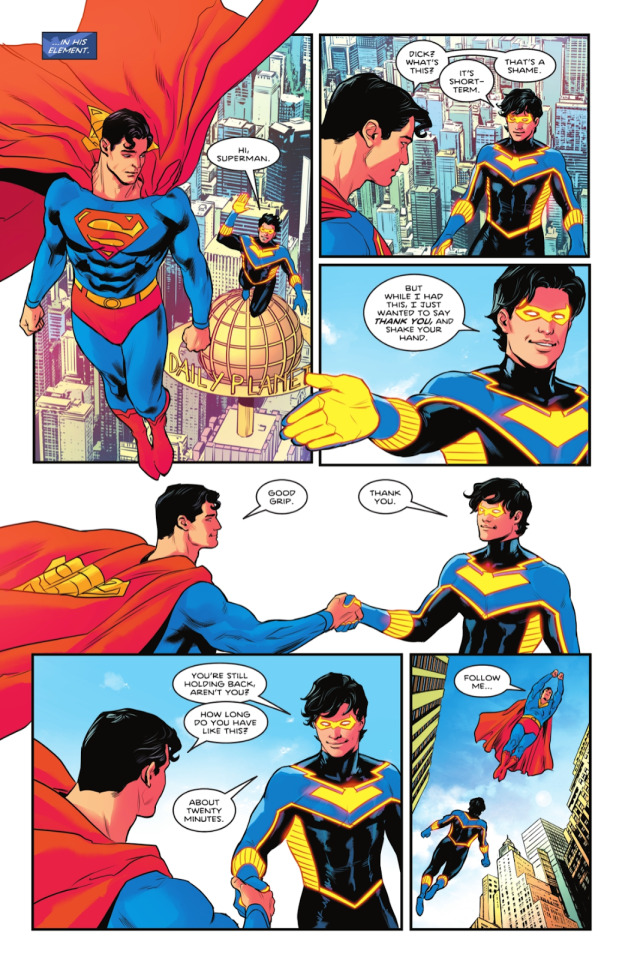
(Taylor, Tom; Pacat, C. S., writers. Pansica, Eduardo; HDR, Daniel; Moore, Travis, illustrators. Superwing in Rise of the Underworld Finale. Nightwing: Rebirth. 104, e-book ed. DC Comics, 2023. pp 11)
Once more, I feel the need to draw a comparison between the implications of this panel and how, in World’s Finest #12, Waid had Kara emphasize how awe-inspiring it was that Dick could save himself while still being an ordinary human.
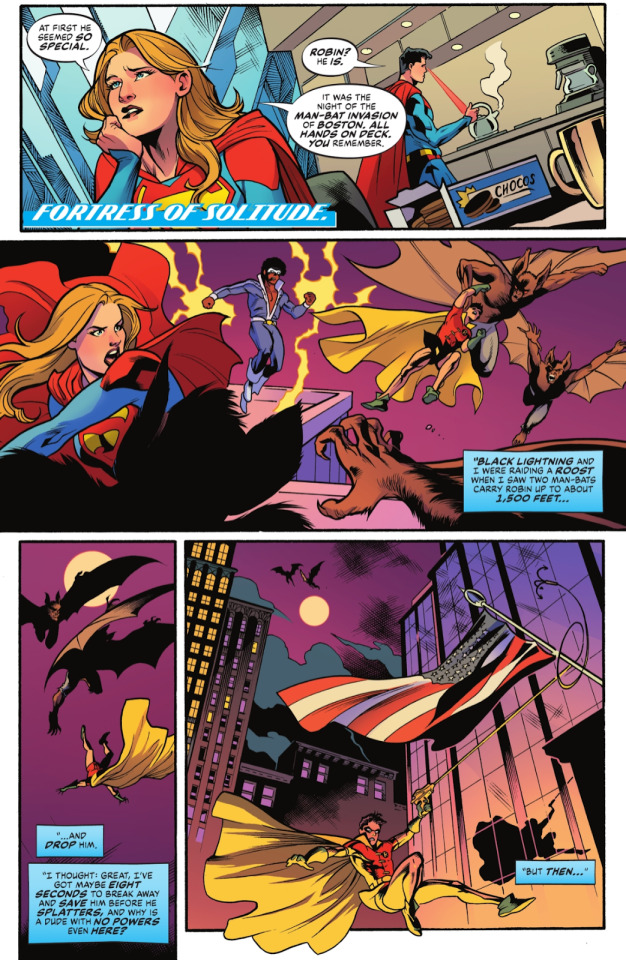
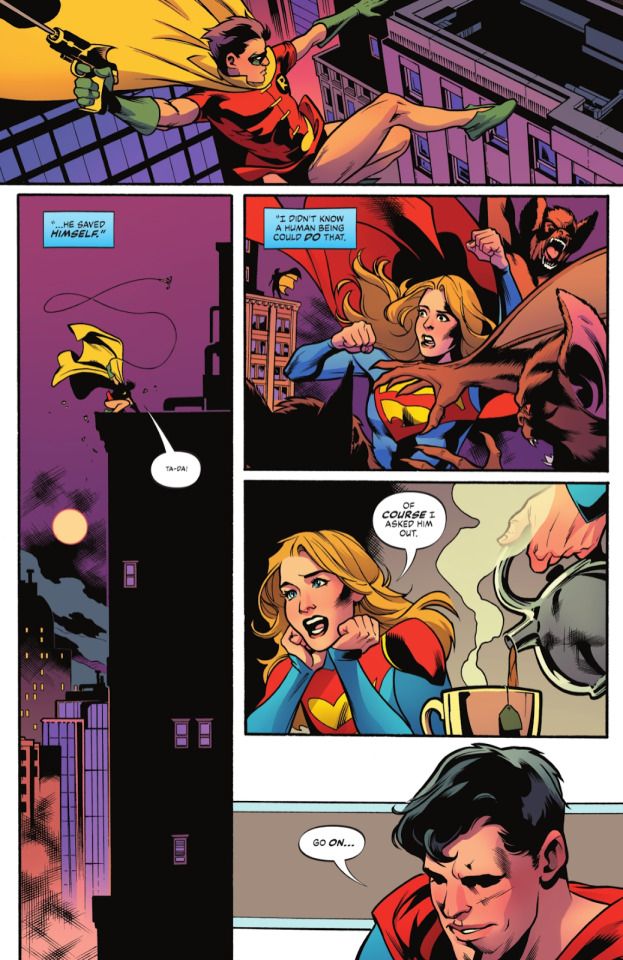
(Waid, Mark, writer. Lupacchino, Emanuela, illustrator. Scream of the Chaos Monkey. Batman/Superman: World’s Finest no. 12, e-book ed. DC Comics, 2023. pp. 06 - 07)
This disrespect and disregard towards “ordinary” humans explains why, rather than building a supporting cast with Bludhaven-natives, and rather than having Dick bond with the citizens, Taylor instead decides to move the Titans into Bludhaven, move Dick into the Titan’s Tower, and impose a physical and emotional distance between Dick and those he is meant to protect. It is as if Taylor does not think that ordinary citizens are worthy of writing about. While their flaws are scrubbed away so they can be “perfect victims,” their troubles can be used as backgrounds, to make the heroes look socially progressive, but any opportunity for meaningful interaction is cleanly removed from the story.
The ordinary people of Bludhaven are denied agency, denied voices, faces, individuality, diversity, and even names because Taylor’s narrative deems them invaluable due to their “ordinariness.” Their lack of “specialness” makes them unworthy of Taylor’s time and of Nightwing’s time. In Taylor’s story, ordinary people do not deserve screen time, they do not deserve to interact with Nightwing, Batgirl, or the Titans. Bea’s transformation is but the embodiment of Taylor’s complete lack of regards towards the people of Bludhaven, towards the city of Bludhaven, and, by extent, towards their hero.
To treat the ordinary people of Bludhaven with so much disregard is to fundamentally misunderstand what is so incredible about Dick Grayson. The appeal of most Bat characters is that, though they are just ordinary people, they are able to rise above the odds to do what seems impossible, and in doing so, they inspire us to take on the challenges we face in our lives. Dick, specifically, has always been a voice for those who felt ostracized by society. He defied all sorts of expectations, not just as a hero, but as Batman’s partner, and showed that one could still be different and be great. He empowered individuals who felt otherized not by being super-powered, but by being compassionate. Dick sees the value in every single individual, his compassion is unparalleled, and his desire to help everyone, in both big ways and small ways, is why he so often worked among the citizens of Bludhaven, and not apart from them. He was not better than them, he was not above them. He was one of them. He was Nightwing, yes, but he was also a bartender, a police officer, a gymnastics instructor, a taxi driver.
But Taylor does not allow Dick to be any of that. Just like Taylor does not allow Dick to have his toxic perfectionism or obsessive tendencies. Just like Taylor has Dick recite online-rhetoric without considering if that would be fitting of his character. Or how he has so Dick’s competence and individuality is sacrificed for a heternormative romance with Babs. In trying to paint himself as progressive while responding to online discussions, Taylor demonstrates his, at best lack of interest, at worst disdain, for who Dick Grayson is and what Dick Grayson fans love about him so much. Rather than embracing the uniqueness of Dick and of Nightwing, Taylor instead strips away everything that differentiates him from others, taking him away from those who love him and appropriates him, his values, and his relationships. In Taylor’s Nightwing, Dick is only a blank canvas stand-in protagonist for audiences to project themselves into, a wish-fulfillment fantasy that has nothing of Dick Grayson in sight.
28 notes
·
View notes
Text
A (Negative) Review of Tom Taylor's Nightwing Run - What Went Wrong? Villains
Introduction
Who is Dick Grayson?
What Went Wrong? Dick's Characterization
What Went Wrong? Barbara Gordon
What Went Wrong? Bludhaven (Part 1, Part 2)
What Went Wrong? Melinda Lin Grayson
What Went Wrong? Bea Bennett
What Went Wrong? Villains
Conclusion
Bibliography
During a discussion, Dick Grayson Fan C explained the importance of a balanced hero and villain dynamic by describing their relationship as inherently “symbiotic.” The two, after all, are interlinked, and the success and failures of one affects the way the audience perceives the other. When the audience knows that the hero will win the final confrontation, the questions surrounding how they will do so and what price they’ll pay to achieve said victory is what creates tension. In other words, the way in which a struggle unfolds is just as, if not sometimes more, important than its outcome.
Note that this symbiotic antagonistic dynamic is not limited to physical confrontations. A good hero-and-villain relationship is also an exploration of the protagonist’s psychology, their motivations, and the thematic questions of a story. A well-crafted villain should not only be providing a challenge to the hero in the battlefield, but also call into question the truths — or lies — that the hero believes in.
Taylor’s antagonists fail to provide Dick with any such challenges. And, as such, they fail to provide Dick with the opportunity to truly demonstrate who he is and what values Nightwing embodies
To prove my point, I wish to compare Taylor’s handling of Blockbuster with that of Chuck Dixon and Devin Grayson. While I considered also analyzing Heartless in detail as well, because the main Heartless confrontation is currently unfolding as time of writing, and because my main gripes with how Heartless was handled during the beginning of the run have already been addressed in other parts of this essay, I opted instead to keep my mentions of him brief. Furthermore, not only does Taylor’s parroting of Dixon’s and Grayson’s runs makes the comparisons between their Blockbusters unavoidable, but his take on Roland Desmond perfectly demonstrates how his simplistic morality contradicts the nuanced themes of social justice that seem to interest him.
(Similar to an earlier disclaimer I made on Dixon, I want to make it clear that just because I am comparing Grayson’s run favorably to Taylor’s, it does not mean that I am unaware of the issues present in her own story, nor that I disagree with much of the criticism directed at it. Despite enjoying much of what she wrote, I also readily concur that there are problematic elements to it, and I often found myself questioning her intentions as I was unable to discern them. But that is something that would deserve its own essay and I do not want to further derail this one by discussing the extensive controversies about Grayson’s run and the way it is often regarded by Dick Grayson fans. Regardless of one's opinion of Grayson’s statements, I believe it is unquestionable that she handled Blockbuster’s ruthlessness and the way he personally terrorized Dick through a form of targeted persecution that was mentally and emotionally torturous was leagues above the generic intimidation tactics employed by Taylor’s Blockbuster.)
When I claim that Taylor’s characterization of Blockbuster reveals his simplistic morality, I do not mean to imply that I wish for Blockbuster (or even Heartless, for that matter) to be sympathetic. I do not believe that they must have redeemable qualities that endear them to the reader in order for them to be interesting. While I enjoy the tragic villain trope, I’m also a big fan of the terrible villain who gets under your skin and inspires such hatred that you cannot wait to see them defeated. I believe that just as a person can enjoy both comedies and dramas without thinking one genre is superior to the other, we can also have all sorts of villains and enjoy them on their own terms.
That being said, I do expect villains to be interesting. I expect them to be meaningfully contributing to the story not only in terms of narrative conflict, but in challenging the protagonist, in creating stakes, and in being in conversation with the themes explored in a story, whatever those themes may be.
So know that when I am criticizing Taylor’s villains, I’m not doing so because I wish they were completely different characters from whom they were intended to be. When I critique their simplistic morality, I do so because Taylor invited such criticism when he coated his run in the veneer of social and political justice commentary by alluding to real world problems and trying to show how Dick Grayson would resolve them.
Let’s start by defining who Roland Desmond is, what conflicts his presence generates, and what he is meant to stand for in the narrative.
When examining Redondo’s design for this character, their intentions come through almost immediately: Blockbuster is meant to be threatening, corrupt, and ruthless. He is meant to be the type of oppressor who enriches himself at the expense of others. He yields his power to remain on top of the food chain, shamelessly bribing politicians and threatening his enemies. He will stop at nothing to retain control, he will not hesitate to destroy those who so much as dare to think about standing in his way. He has no sympathy for others, he does not care about their suffering, and he will gladly sacrifice their lives and the lives of their loved ones to get what he wants. All of these characteristics are physically manifested in his design, in which his oppressive frame demonstrates how he overpowers others and his giant hands are shown to be the type that could crush one’s bones just as his shadowy reign over Bludhaven crushes the city’s soul.
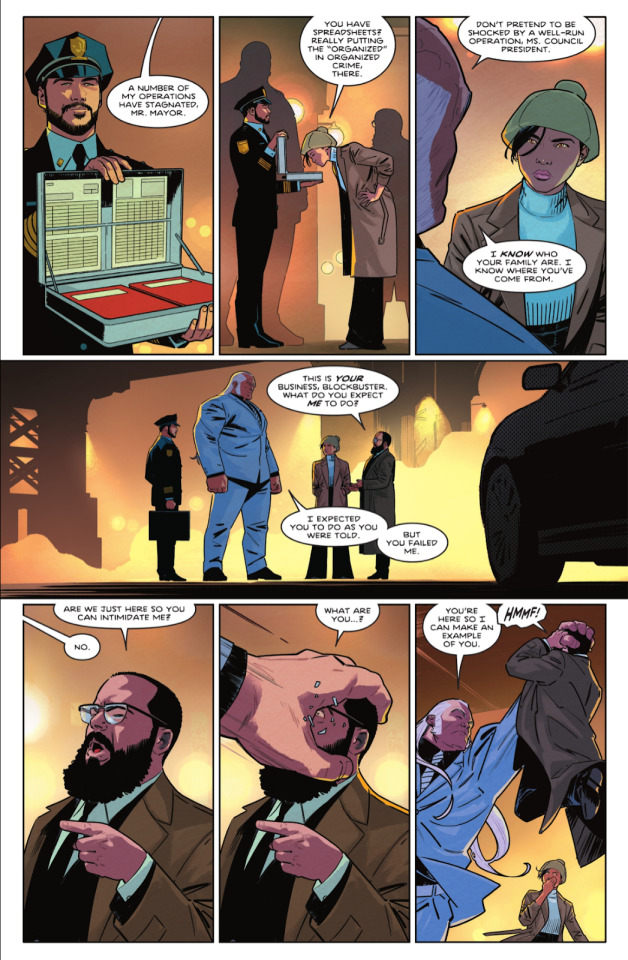
(Taylor, Tom, writer. Redondo, Bruno, illustrator. Leaping into the Light Part Two. Nightwing: Rebirth. 79, e-book ed. DC Comics, 2021. pp 14)
We can see this also through the dialogue of the story. For example, in #81, Melinda gets sworn in as mayor and Blockbuster’s men, in order to demonstrate the power they have over the politicians in the city, give her a suitcase full of money as a representation of the bribes that will be coming Melinda’s way.

(Taylor, Tom, writer. Bruno, illustrator. Leaping into the Light Part 4. Nightwing: Rebirth. 81, e-book ed. DC Comics, 2021. pp 04)
Melinda, in order to continue her work undercover, plays into that by stating in a line that is as devoid of personality as it is of subtlety that, as mayor, she will make them all wealthier.
Similarly, in #83, Blockbuster states (also with little personality and little subtlety) that he owns the courts, that he sees himself as entitled to Bludhaven, and that because of the power he yields, he sees himself as invincible.
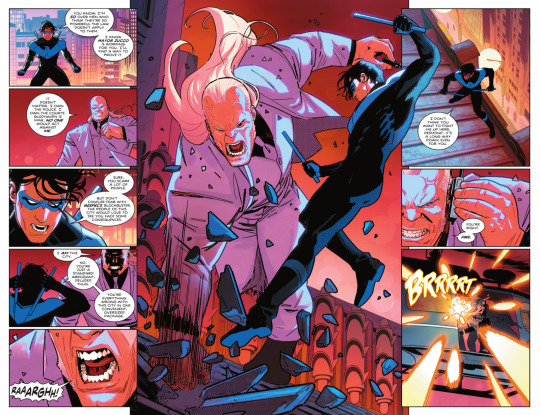
(Taylor, Tom, writer. Redondo, Bruno, illustrator. Leaping into the Light Part Six. Nightwing: Rebirth. 83, e-book ed. DC Comics, 2021. pp. 08)
Nightwing reaffirms this idea in that same issue when he says (also devoid of personality, subtlety, and this time charm or wit) that Blockbuster is “everything wrong with this city in one convenient, oversized package.”
This is what the conflict between Blockbuster and Nightwing is meant to symbolize — a struggle for the city’s future. Will Bludhaven continue to crumble under Blockbuster’s rule, or will Nightwing free it from his corrupt grip so that its citizens can finally have a chance to thrive? Even in the 1996 series, during both Dixon’s and Grayson’s runs, Blockbuster did not pose a threat to Dick’s morals or his world view. He did not make Dick question the way he saw people. Blockbuster’s targeting of Dick Grayson and his loved ones demonstrates how those with privilege go after the people who are fighting for change. Dick’s exhaustion and hopelessness mimics the same sense of helplessness one feels when it seems like the entire world is against you and the consequences for doing what is right can seem too great of a price to pay.
For this reason, Blockbuster does not need to be complex. He does not need to be sympathetic. But he does need to be powerful, threatening, and ruthless. He must push Dick to the edge, to make it seem like all it is lost, and in turn, when Dick finally pushes through and wins, it is a victory on both a personal and a societal level.
And this is where Taylor fails miserably.
Now, I have stated previously how, despite Taylor’s attempts, his rendition of Blockbuster comes off as flatly incompetent rather than threatening. I have discussed this under the context of how it influences the way Dick’s and Bludhaven’s portrayal. Now, I wish to dig deeper into this issue.
We are told of countless attempts on Dick’s life, but the only ones shown are overcome by Dick and his allies with ease. Either that, or the tension is undermined by a one-line joke or a general tone of casualness that fails to properly convey the stakes of the moment. Any threat that could have been created with Haley’s kidnapping or any intimidation tactic is destroyed by the gimmicky nature of the issue. This makes Blockbuster less of a threat.
And yet, we are told by Wally that Dick is stressed and overworked. But because there is not a lot of tension on screen, that telling rings hollow. The reader is not shown that Dick is overworked, and he is not shown truly struggling alone against the obstacles he does face, so this idea of Dick coming apart at the seams because of Blockbuster is not something the reader gets to truly experience. As a result, it often appears that Dick is coddled by his loved ones as everything always ends up alright with little effort made on their part. Rather than witnessing true danger take a toll on Dick, we are simply told this is something that is happening.
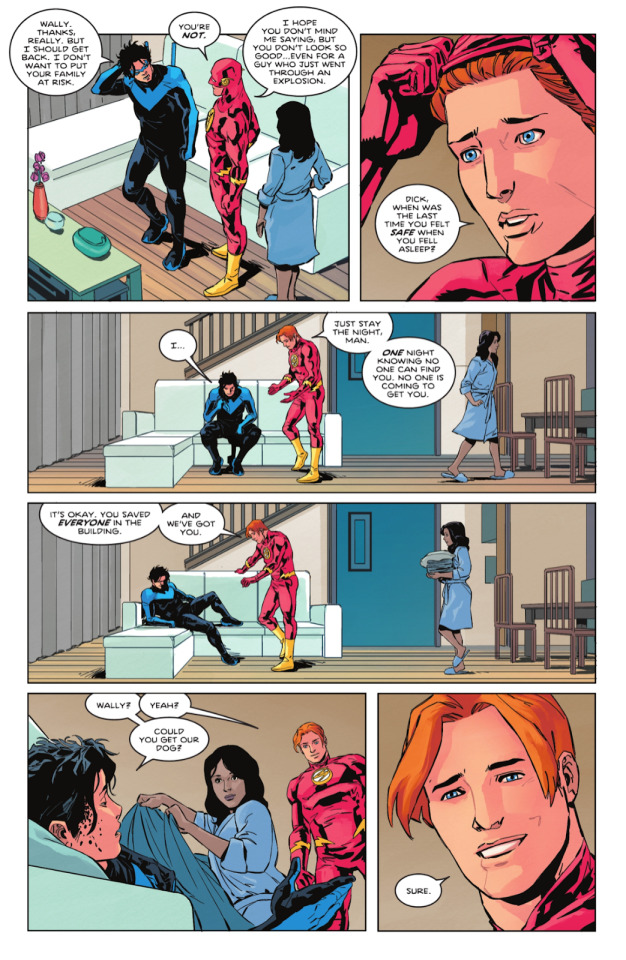
(Taylor, Tom, writer. Redondo, Bruno, illustrator. Get Grayson Act Three. Nightwing: Rebirth. 90, e-book ed. DC Comics, 2022. pp 16)
By comparison, when Grayson first wrote this same story nearly twenty years ago, she made it carry weight. She made it have consequences. While Dick was already coming apart from a myriad of different stress factors that unfolded on screen (overworking himself as Nightwing, as a police officer, saving Amy from Deathstroke, being fired from his job, Babs breaking up with him, and finally the circus fire), it was the explosion that made Dick fall apart, serving as the catalyst for his downward spiral. As Dick hunts down those Blockbuster employed, the readers get to see Dick’s exhaustion, Dick pushing himself to his limits, sleeping on fire-escapes while wearing his Nightwing uniform because he cannot bring himself to stop.
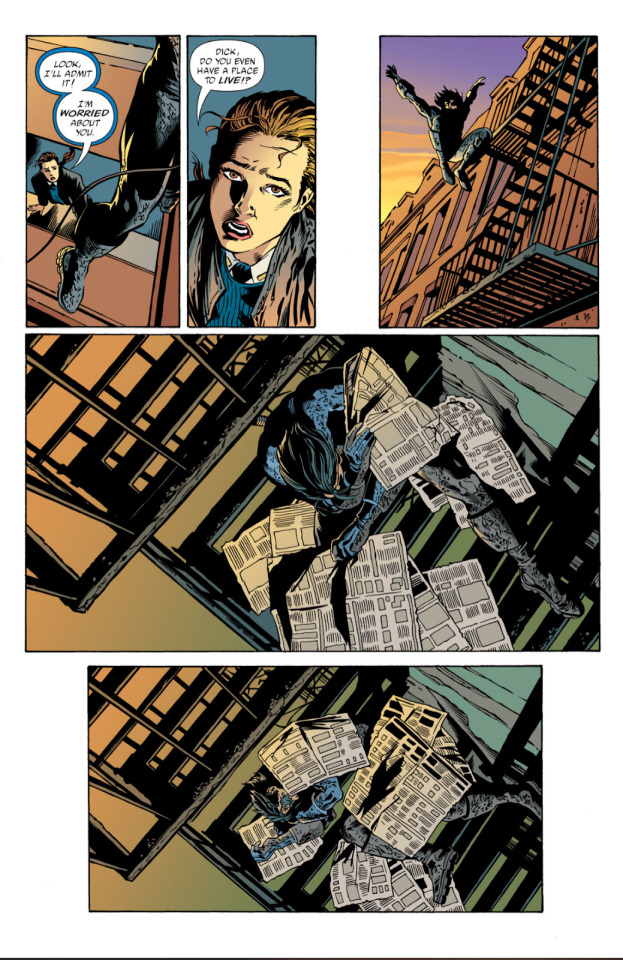
(Grayson, Devin, writer. Zircher, Patch, illustrator. Rekindle. Nightwing no 91, e-book ed. DC Comics, 2004. pp. 15)
Similarly, when the Judge returned to Bludhaven in The Untouchable, we see Dick keeping count of the bodies he left behind, we see Dick push through a bullet wound and beatings, we see him chase the Judge restlessly while neglecting his personal life. In both cases, we see the consequences of what Dick’s failure means, we see him struggle with those outcomes, we see what is at stake if Dick loses. And that, in turn, makes us not only care, but become invested in his success.
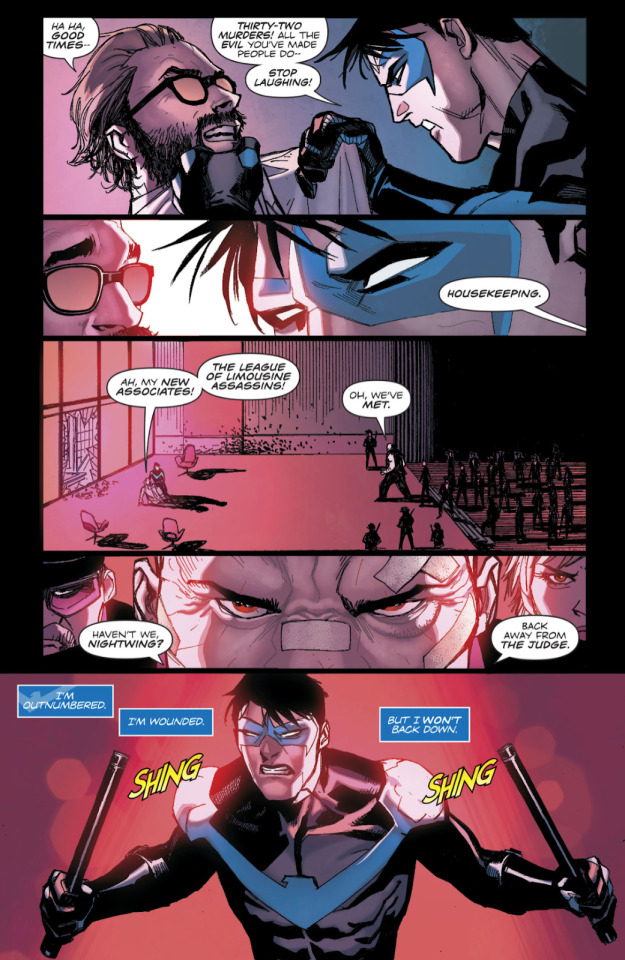
(Humphries, Sam, writer. Chang, Bernard, illustrator The Untouchable: Chapter Four: Infiltration. Nightwing: Rebirth no. 38, e-book ed. DC Comics, 2018. pp. 19)
By contrast, in Taylor’s run we never see any of that danger, and the few times we are presented with some threat, the conflict is handled with laughable ease. Blockbuster’s plots are foiled without Dick ever needing to do much of anything as he mostly relies on others to come to his aid. In this Nightwing solo series, the Titans, Batman, Robin, and Batgirl often do much of the hero-ing. Rather than putting the spotlight on Dick as a hero, Taylor lets others take the center stage, making this into an almost ensemble book. Because of this, the idea of Dick being near a breaking point, exhausted, and feeling unsafe wherever he goes is not supported by the narrative. By not giving Blockbuster a win, Taylor undermines the story he is attempting to tell.
This continues on through Nightwing #91. While Wally and Dick’s friendship were portrayed rather nicely, the villain that Taylor so ominously built up is taken down with an ease that is devoid of tension. The villain who is supposedly so good they’ve kept their existence a secret from Batman himself is quickly undermined by Taylor’s unwillingness to have his characters struggle.
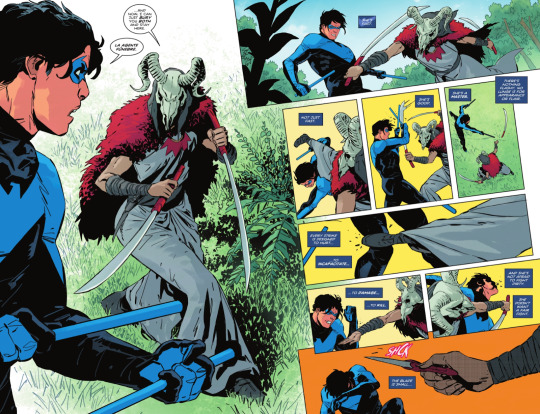
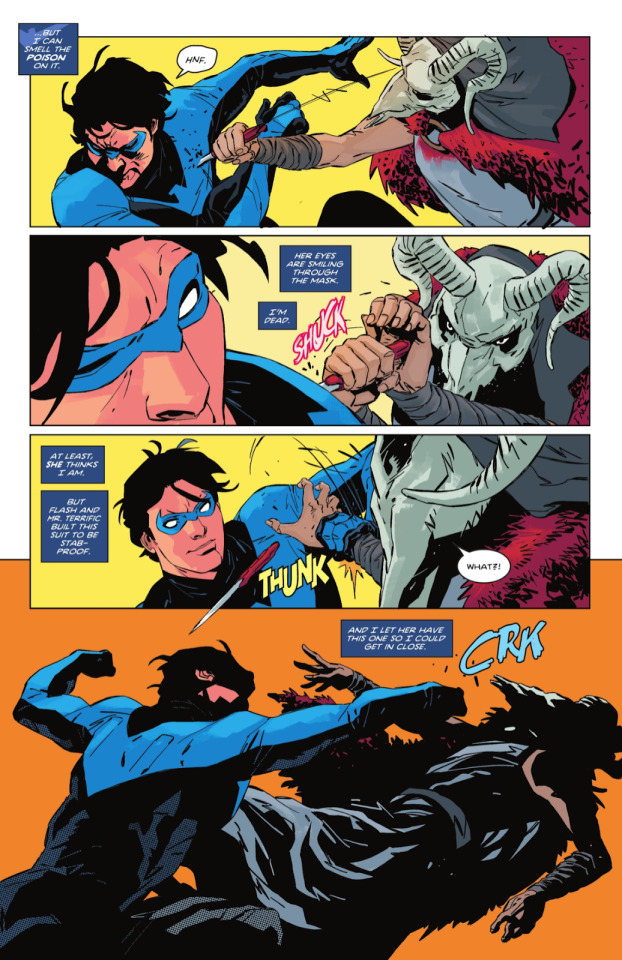
(Taylor, Tom, writer. Redondo, Bruno, illustrator. Get Grayson Act Three. Nightwing: Rebirth. 91, e-book ed. DC Comics, 2022. pp 16-17)
Besides the poor execution of his plans, however, it must be stated that Blockbuster’s plans and his motivations are poorly developed. Again, I’m not saying that Blockbuster needs to have a single sympathetic aspect to his character, but he does need to be threatening, and he must have some internal logic. Looking at the story Taylor has created, I wonder… Why does Blockbuster care that Dick Grayson created the Alfred Pennyworth Foundation? Why does he care about the creation of Haven? I understand that Blockbuster is meant to be a corrupt crime boss who wants to retain control of the city, but how does Dick building Haven interfere with his plans? Why was one billionaire throwing his money around to help homeless youths a bleep in his radar? Blockbuster already has politicians and the police force in his pocket while Bludhaven’s systems were constructed to benefit him and those who endear themselves to him. So why is he so focused on destroying Dick Grayson and not Nightwing?
I am trying to restrict my comparisons to DC Comics media, but in this, I cannot help but think of President Snow’s portrayal in the Hunger Games movie adaptations. In a movie-only scene, President Snow tells Seneca Crane about the importance of having a winner in the games. He explains how it is about letting the people have hope. As he put “A little hope is effective, a lot of hope is dangerous. A spark is fine, as long as it's contained.”
In other words, giving the people a spark of hope to keep them distracted can help prevent mass mobilization required to disrupt the system. Give them a goal to focus on, and you can redirect their attention. It would, then, be far more sinister and make far more sense from a narrative standpoint if Blockbuster allowed Dick to focus on his one project so that instead he would not turn his attention to Blockbuster. Perhaps he could have attempted to manipulate the project from within, folding it into Bludhaven’s corrupt social systems. Dick would have been that little spark that Blockbuster could have cultivated, giving the people of Bludhaven "hope" so that they would focus on that and not on what is going on behind the scenes. The narrative arc, then, would focus on Blockbuster failing to contain the spark as Dick became the flame that breathed true systematic change.
I do not want to dwell too much into fixes, as I merely wished to analyze Taylor’s run and not to go full on script-doctor and rewrite the entirety of his story. Rather, I just wished to use that as an example of how Blockbuster does not have sound plans or internal logic, and that, too, contributes to how his character comes across as incompetent and nonthreatening, and as a result, even his supposed ruthlessness is undercut.
Taylor’s Blockbuster does not have a concrete goal. He wants power and money, yes, but for what purposes? And how does he acquire said power and money? Why is he threatened by Dick Grayson’s personal project? How are his intimidation tactics challenging Dick in an interesting way? How are Blockbuster and Nightwing meant to narratively play off each other? How are Taylor’s Blockbuster tactics any different from a generic villain with any other name?
To be fair to Taylor, I do not believe Dixon managed to fully nail this part of Blockbuster’s character. I did not find Dixon’s writing of Blockbuster to be a particularly compelling part of his run. However, Dixon countered this lack of substance by leaning into what Blockbuster was meant to represent — the system inside the machine that allowed evil to flourish. Blockbuster’s influence may have been everywhere, but Blockbuster himself was hardly ever confronting Nightwing directly. Dick was fighting a war on multiple fronts, and while he could stop an enemy on his right, two more appeared on his left. The way the struggle between Blockbuster and Nightwing played out during Dixon’s run emphasized why protecting Bludhaven was so difficult — because there were so many immediate crises that needed to be dealt with on the surface, it was difficult to get to the root of the problem.
This was why, during Dixon’s run, Blockbuster could remain a threat even if he would remain unseen for long stretches of time. And this was why when Dick stopped one of the underlings, Blockbuster himself could remain an intimidating force. Blockbuster’s machinations were varied — some of his plans targeted Nightwing directly; others Dick only stumbled upon when investigating a matter he believed to be unrelated. Furthermore, the limited number of allies and the prospect that Blockbuster could only be taken down for good once his grip on other institutions of power and influence were weakened emphasized just how this was no ordinary fight, but rather a mission requiring Dick to operate on multiple fronts and strategize on a long-term basis.
Taking down Blockbuster was a multi-step process. Each of said steps offered their own challenges and opportunity for storytelling, for fleshing out Bludhaven, and for allowing Dick to grow as the protagonist of the story.
Dixon’s approach to Blockbuster requires Blockbuster to stay in the background, looming over the city as Dick fights his way forward. It’s why he remains present for all 70 issues of Dixon’s run without undermining Dick’s competence or his dedication to his city — as a stand-in for corrupt power, Blockbuster himself is not an immediate threat even if he is the powerful underlining one. Dick must constantly fight others in order to eventually be able to fight Blockbuster. To borrow video-game terminology, Blockbuster is the final boss, and Dick must first go through a myriad of levels and smaller enemies before he gets to finally take down Blockbuster for good.
It was Grayson who made the conflict between Dick and Blockbuster personal and, as a result, far more sinister. After the death of his mother in a car pile up caused by Nightwing’s activities, Blockbuster was determined to get his revenge on Nightwing. After finding out Nightwing’s civilian identity, Blockbuster came up with a chilling plan that was specifically made to destroy Dick from the inside out. Blockbuster understood that Dick did not value his own life, but rather, those of the people around him. And so, he decided that rather than killing Nightwing, he would instead kill everyone around Dick, tormenting and terrorizing him until he felt as if he were poisonous. What was so poetic about this strategy was that it mirrored what, in Blockbuster’s eyes, was Nightwing’s biggest sin: the danger he imposed on others through his actions which resulted in the death of Blockbuster’s mother.
As you can see, in this scenario, Blockbuster has become more of a proper character rather than just a stand in for corruption. That is not to say that wielding power for self-serving purposes at the expense of others isn’t a factor in his character during Grayson’s run, but rather that while Dixon’s Blockbuster was more of an embodiment of an idea, Grayson’s was more human, with more personal motivations. One approach is not inherently better than the other, they simply lean towards opposing sides of the spectrum, and that affected the type of story told and the type of confrontation Dick and Blockbuster had during their runs.
Because Grayson took a more personal approach towards Dick and Blockbuster’s dynamic, she also fleshed out their relationship to the point that it was not generic. Blockbuster’s campaign of terror against Dick was intimate, for it was something that could only have played out between these two characters. And while Dixon laid out the groundwork to build Blockbuster into a threatening figure by the time Grayson took over the title, Grayson’s strategy to have Blockbuster go after those around Dick allowed her to have Dick win and lose simultaneously.
Blockbuster starts his campaign of terror slowly. First, getting Tarantula to contribute to Dick and Babs’ breakup. While she is not the sole reason why they break apart — they are shown to have had some tension long beforehand that comes from incompatible personalities and desires — she does become a factor in their falling out. This ends up isolating Dick even further, who was already stressed due to the fact he lost his job once his boss and superior Amy discovered he was Nightwing.
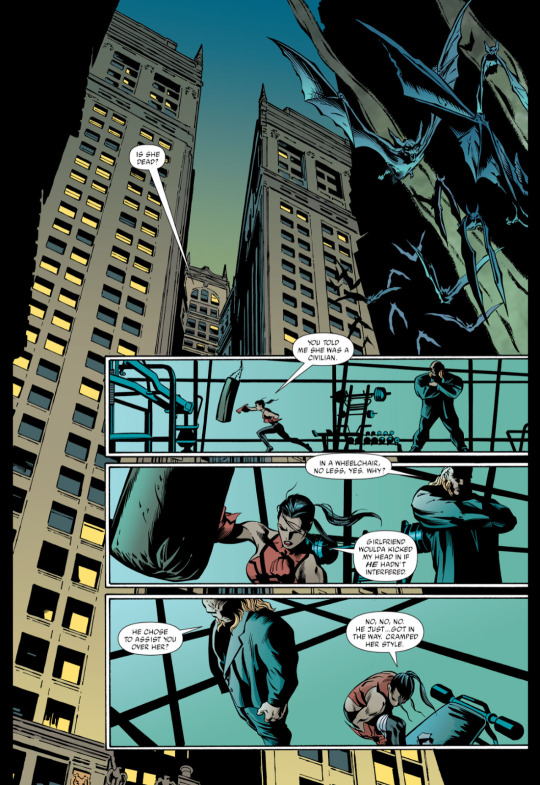
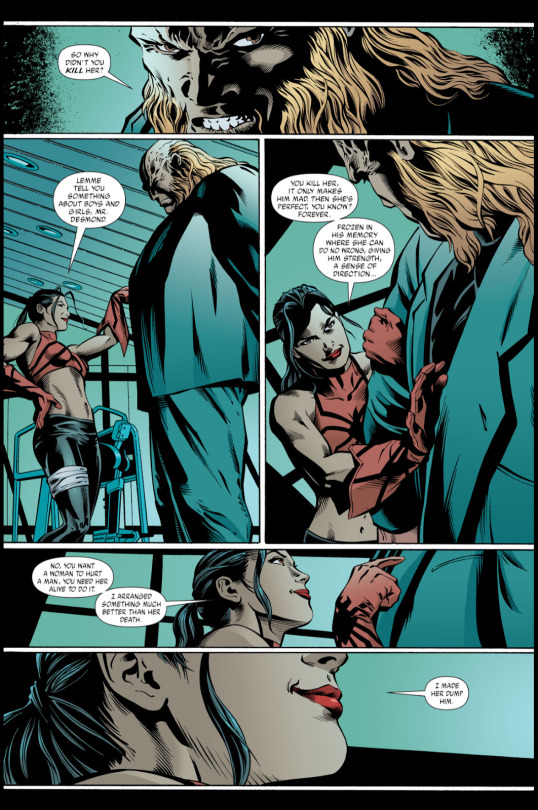
(Grayson, Devin, writer. Zircher, Patch Snowball. Nightwing. 87, e-book ed. DC Comics, 2003. pp 17 - 18)
Then, Blockbuster strikes closer to home by hiring Firefly to set fire to the circus Dick grew up in. While Dick was able to save many people who were inside the tent (and had his own life saved by Zitka), over twenty people lost their lives in this incident.
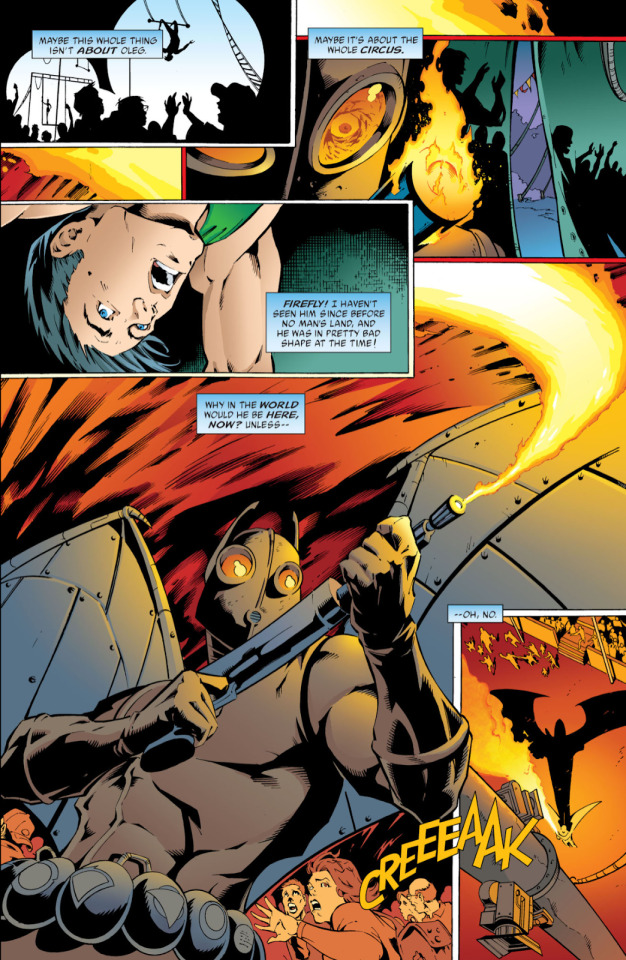
(Grayson, Devin, writer. Davis, Shane, illustrator. Flurry. Nightwing no 88, e-book ed. DC Comics, 2003. pp. 16)
While that certainly worked in breaking Dick’s spirit, it wasn’t until Dick’s building exploded that he realized this was a targeted attempt to get to him. All of those innocent people died not because Blockbuster was trying to kill Dick, but rather, because Blockbuster knew that their deaths would destroy him.
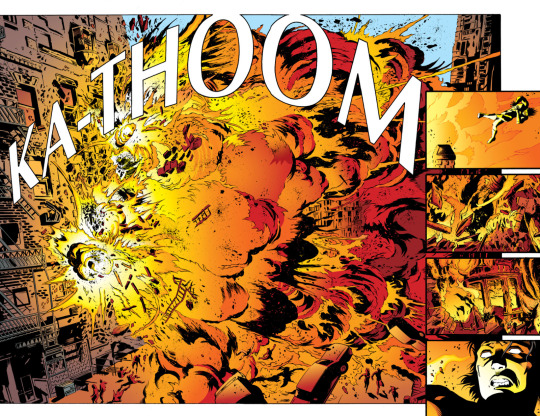
(Grayson, Devin, writer. Zircher, Patch, illustrator Avalanche. Nightwing no 89, e-book ed. DC Comics, 2004. pp. 12)
What follows is a downward spiral that demonstrates just how thoroughly Blockbuster is able to break Dick. Even as Dick gains new ground by taking out some of Blockbuster’s hired assassins, the threat still looms over him. And even when it seemed like Dick finally found a way to take down Blockbuster for good, that hope is snatched from him. The anger and helplessness Dick experiences in this moment truly speaks to the same feeling many of those who stand up against their oppressors feel whenever they are faced with setbacks in their constant battle.
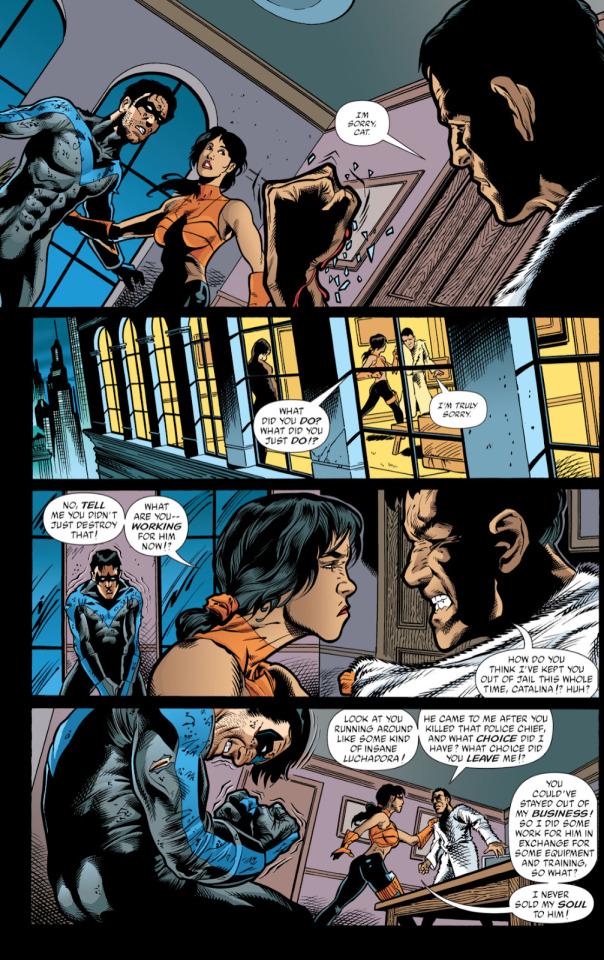
(Grayson, Devin, writer. Garcia, Manuel, illustrator Flashpoint. Nightwing no 92, e-book ed. DC Comics, 2004. pp. 21)
The carnage continues. The reporter who had uncovered Nightwing’s identity and just so happened to be standing next to Dick is mercilessly shot dead in front of Dick’s eyes.

(Grayson, Devin, writer. Zircher, Patch, illustrator. Slowburn. Nightwing no 93, e-book ed. DC Comics, 2004. pp. 07)
And as Blockbuster chases Dick down, putting others in harm, we can see as Dick tries to protect innocent people around them that Blockbuster will not stop. He will not rest.
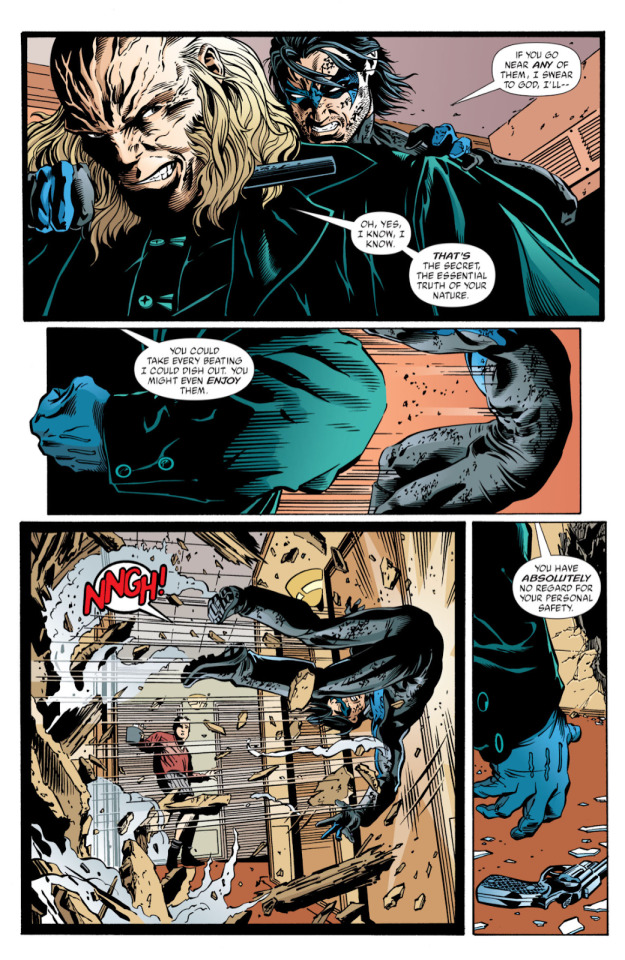
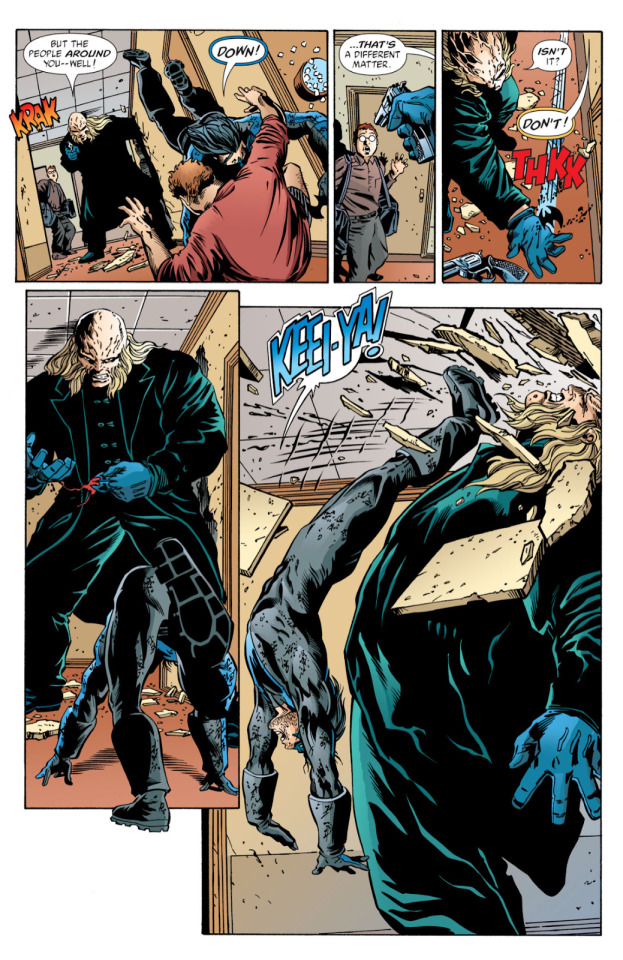
(Grayson, Devin, writer. Zircher, Patch, illustrator. Slow Burn. Nightwing no 93, e-book ed. DC Comics, 2004. pp. 10-11)
Blockbuster says it himself in a speech where he lays out exactly what his plans for Dick are. Dick is at a breaking point. The enemy, huge and impossible to overcome, towers over him. As the climax reaches its crescendo, Blockbuster asserts his power by mocking Dick and laying out a future in which Dick can never escape this hopeless terror. This city belongs to Blockbuster. Dick is powerless. There is no winning.

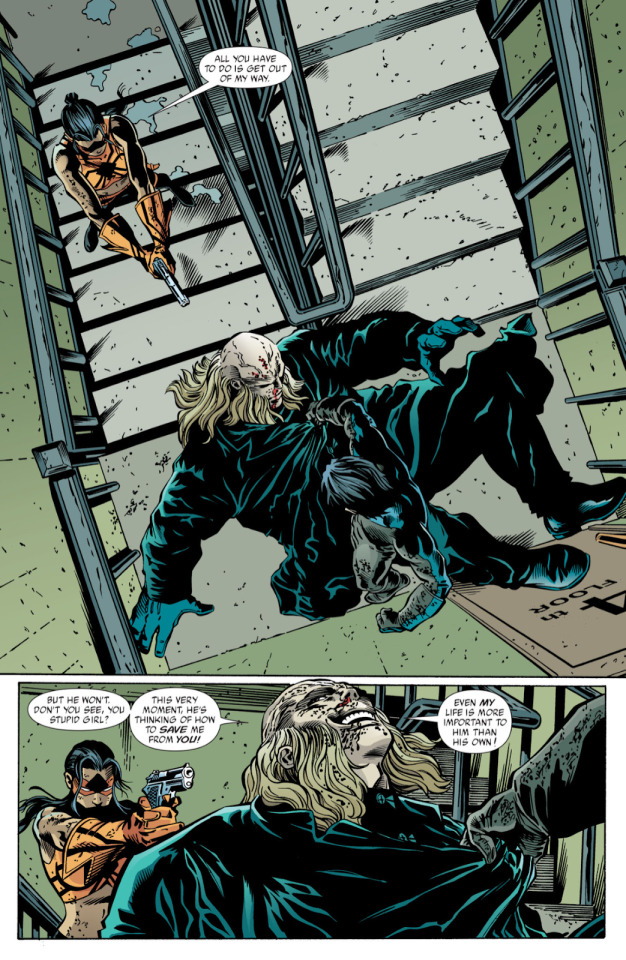

(Grayson, Devin, writer. Zircher, Patch, illustrator. Slow Burn. Nightwing no 93, e-book ed. DC Comics, 2004. pp. 13 - 15)
This speech is visceral. Personal. Evocative and filled with character and emotion. These words could not have been uttered by anyone else but Grayson’s version of Blockbuster. And they could have not been directed at anyone but Dick at this very moment. This speech has specificity that was purposefully crafted to raise the tension of this moment to its fullest potential.
By comparison, Taylor’s “I am this city” line is generic. Like much of his dialogue, it lacks character — nothing about what Blockbuster says feels distinctive to him. Nothing sets it apart from how other characters speak in Taylor’s world, and nothing about it is unique to this particular confrontation. Even the way he bangs his hands on the ground like a toddler throwing a tantrum (and resulting in Dick’s second unmasking in this run) is childish and undermines the tension of what is meant to be a climatic moment.
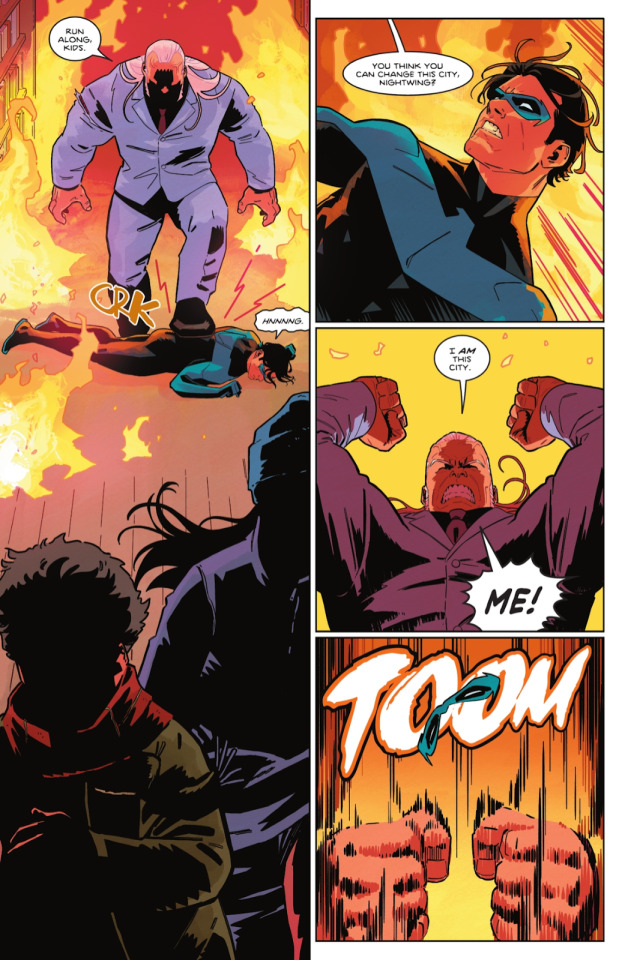
(Taylor, Tom, writer. Redondo, Bruno, illustrator. The Battle for Bludhaven’s Heart Part Four. Nightwing: Rebirth. 95, e-book ed. DC Comics, 2022. pp 20)
The themes in Grayson’s run are not the same as the themes in Taylor’s run. However, Blockbuster still invokes the threat of an oppressor. By isolating Dick from his support system, his terror and the helplessness it generates are intensified. Rather than making Dick question his own morality, he makes Dick doubt his abilities to be a hero.
While Dixon used Blockbuster’s intimidating build and power to explore the ways in which systematic corruption is responsible for the immediate evils we encounter in everyday life, Grayson used those very same characteristics to explore how one copes with being oppressed on a personal scale. Grayson’s Blockbuster pushes Dick to the darkest place he’s ever been, and the aim of her run was to see how he would be able to put himself back together again after he lost faith in his ability to make a difference.
Those two runs demonstrate how Blockbuster’s grip on power can be used to oppose Nightwing in two very different ways. Dixon’s approach requires Blockbuster to stand at a distance, the unseen machine that Dick will have to eventually destroy. This allowed Blockbuster to remain Nightwing’s main opponent for all 70 issues of Dixon’s run without ever calling into question Dick’s competence or his dedication to his mission as Blockbuster, the themes he embodied, and the struggle Dixon built clearly signaled that, no matter how great Nightwing was or how much he might wish to do so, the circumstances were not at a point where Dick could take on Blockbuster and succeed. By contrast, Grayson shifted Blockbuster from a long term, simmering threat to an immediate and personal one. This, though, also meant that the conflicts in Grayson’s run were more internal than those of Dixon’s. While Blockbuster was the enemy, the true antagonistic force that Dick would be forced to battle throughout Grayson’s run was Dick’s depression, his self-loathing, and his self-doubt. For this reason, rather than standing in the background while others did his bidding, Grayson’s run pushed Blockbuster to center stage. As he became an urgent threat who was costing people their lives every minute he roamed around free, apprehending him was no longer something Dick could afford to create a strategy around — it was something that demanded prioritization.
Nearly twenty years later, Taylor’s attempts to merge these two approaches only serves to lessen Dick’s competence and Blockbuster’s threat. Like Dixon, Taylor uses Blockbuster to represent, as it was plainly stated in his run, everything that is wrong with Bludhaven – the men in power who “have everything and still want to take more.”
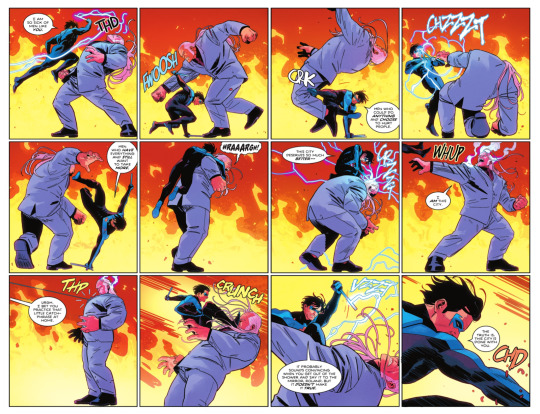
(Taylor, Tom, writer. Redondo, Bruno, illustrator. Battle for Bludhaven’s Heart Finale. Nightwing: Rebirth. 96, e-book ed. DC Comics, 2022 pp. 08)
And yet, it is Grayson’s plot beats that he copies by having Blockbuster personally target Dick in a myriad of unsuccessful ways.
While Grayson’s Blockbuster targets Haly’s Circus, Taylor’s Blockbuster targets Dick’s dog, Haly. While Grayson’s Blockbuster successfully kills Dick’s neighbors, Taylor’s Blockbuster fails to kill Dick’s neighbors thanks to Melinda and Wally’s intervention.
Because of this personal persecution, Blockbuster becomes Dick and his allies’ priority. However, because Taylor’s Blockbuster’s actions never have any negative consequences; because the humorous tone is always undermining the tension; and because the reader does not get see Dick struggle or fail against Blockbuster’s attempts the way he does in Grayson’s run, Blockbuster’s does not come across as the larger than life villain he is meant to be. Rather, his constant failures, his generic dialogue and unclear motivations, and his straightforward intimidation tactics make him more into a fumbling fool whose powerful position is incidental rather than the result of merciless oppression.
And yet, he becomes Nightwing’s priority. Thematically, Taylor’s Blockbuster is meant to imitate Dixon’s, but the narratively he acts like Grayson’s Blockbuster. This makes it so he is more of an immediate threat than Dixon’s villain, but less effective in his terror tactics than Grayson’s.
With the consequences of Blockbuster’s crimes being non-existent plot-wise, the stakes of the plot are never elevated. Blockbuster’s threat remains abstract because in Taylor’s run, everyone who is not an explicit bad guy has plot armor so thick that they cannot be forced into an uncomfortable on-screen situation for more than two or three pages at a time.
The clashing of theme and plot create enough of a dissonance as it is, but the presence of Heartless, who is actively and brutally murdering people and leaving children orphan, only deepens the problem. Heartless’ gory crimes not only overshadow Blockbuster’s failed assassination attempts, but the sheer amount of people who have fallen victim to his deeds creates an urgency and a tension that demands to be resolved.
Though Dick is aware of Heartless' existence, he does not make the serial killer his priority. When Grayson made Blockbuster’s threat more immediate and Dick became aware of the rising body count, stopping Blockbuster became his sole focus, to the detriment of his own health. Dick’s obsession with catching Blockbuster at all costs helped add to that intimidating aura around him.
Humphries understood this when crafting the dynamic between Dick and the Judge in The Untouchable. Heroes and their villains have a symbiotic relationship. When the Judge kills people in brutal ways, Dick jumps into action and stops at nothing until he catches him. This shows the audience that the Judge is a threat to be taken seriously, and it shows Dick to be a hero who will always put others first. When Dick fails to take the same approach with Heartless and instead focuses on Blockbuster, Dick comes across as an incompetent and self-centered.
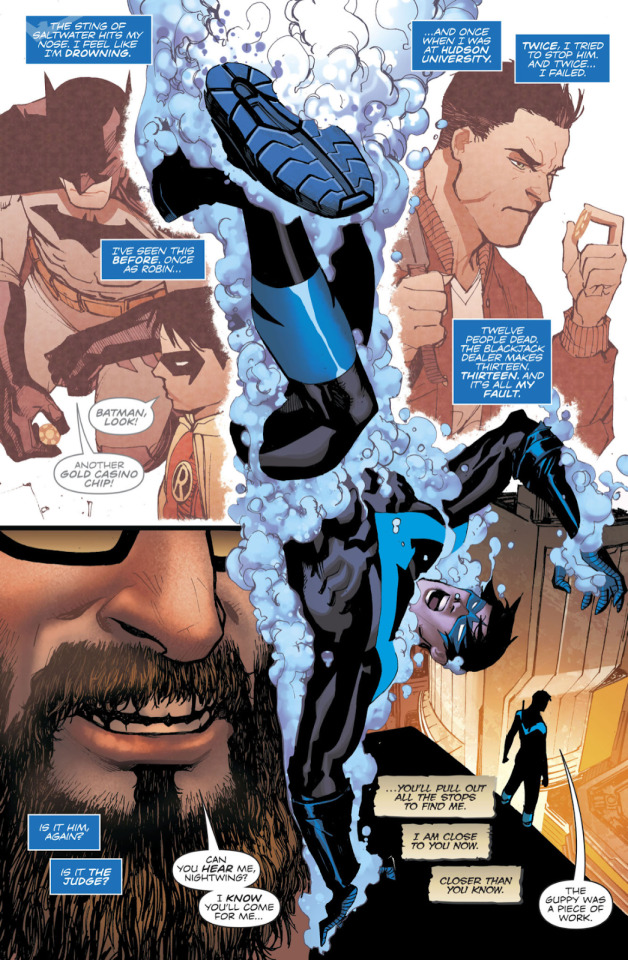
(Humphries, Sam, writer. Chang, Bernard, illustrator. The Untouchable: Chapter One: Hunter. Nightwing: Rebirth no. 35, e-book ed. DC Comics, 2018 pp. 20)
At this point, one might be wondering why high stake conflicts and ruthless villains are even needed in a Nightwing comic. I have seen many people defend Taylor’s writing by claiming that they enjoy the fact that it has no tension. They like the easiness of it, the slice-of-life nature of his storytelling. And while even his slice-of-life writing is not really my cup-of-tea, I can understand this sentiment. Taylor seems to truly enjoy writing the more sitcom-aspects of Dick and Babs’ life together. It is not the fights, the mystery, the intrigues, the nuances of living a double life that interest him — it’s the taking care of the rescue puppy, the sharing of a pizza in the park, the two childhood friends finally getting to live an idealistic millennial adult life together without having to worry about everyday problems like work, rent, family troubles, or disagreements. He thrives when writing stories that remain static, with simple episodic plots that never truly lead to character development or a change in the status-quo. He excels in quippy yet straight-forward dialogue where things don’t need to be taken seriously.
And to be clear, I don’t think that is a bad thing. I don’t think slice-of-life or sitcoms are a lesser art form than dramas or action series. Like many people, I too, have been comforted by that type of entertainment. I, too, find escape in those sorts of stories. I daydreamed about a life where I could just enjoy time with my friends without thinking about work, where the worst problem I face is how to avoid going to a party without appearing rude. Those stories have value, they have their place in our culture… But Nightwing's solo series is not that place.
Now, this will probably be the one of the most controversial things I will say in this entire essay, but despite my love for Nightwing, I do not believe that the Nightwing mantle is Dick’s ultimate true form.
In DC Secret Files: Nightwing Secret Files #1, Dixon explores the aftermath of Dick being fired as Robin by having Dick confess, with a certain amount of shame, that he always thought that he would eventually become Batman. Bruce understood that and he was preparing Dick to be his successor. Losing Robin, then, means losing any certainty Dick has for his future. Suddenly, he is adrift, not only having lost Robin, but also Batman. And that’s when Clark tells him the story of Nightwing.

(Dixon, Chuck; Grayson, Devin; Peterson, Scott; writers. Ha, Gene; Scott, Damion; Land, Greg; Stelfreeze, Brian; Guice, Jackson; Eaglesham, Dale; Floyd, John; Jimenez, Phil; Brown, Eliot R.; McDaniel, Scott; Nolan, Graham; Rosado, William; Kuhn, Andy, illustrators. DC Secret Files: Nightwing Secret Files #1. DC Secret Files: Nightwing Secret Files #1 no. 01, e-book ed. DC Comics, 1999. pp 15)
Personally, I think there’s something really special about that idea. The Nightwing story grounded Dick during one of the most uncertain times in his life. Dick wanted Robin and Batman, but once both were taken from him, he created Nightwing as a way of coping with the trauma of having his identity, future, and certainty taken from him.
Braxi concludes his essay On Superman, Shootings, and the Reality of Superheroes by saying that “I don’t need Batman to end homelessness. I need Batman and Superman to provide moral and spiritual guidance to show us a better world is possible. I read Batman to transform trauma into will power.” (Braxi, Steve, “On Superman, Shootings, and the Reality of Superheroes” Comics Bookcase, September 2021)
The same, I believe, is true for Dick. As the character created to accompany Bruce and mirror him in as many regards as he foils him, Dick transforms trauma into power. He makes his own suffering a source of good.
As I said, I do not believe Nightwing to be Dick’s ultimate, truest form. I believe that to claim that Dick’s only happy ending is to have him be Nightwing not only diminishes the importance that Robin and Batman played in his life, but it also undermines what is so unique about Nightwing as a mantle.
Dick loves being Nightwing. Nightwing is an extension of who he is. But Nightwing is not the only happy ending Dick could have had, and to treat Nightwing as inevitable is to ignore the fact that Nightwing was born out of a trauma and a loss that could have been prevented had the circumstances that led to Dick losing Robin been different. Nightwing means transformation. He means change. Nightwing is a phoenix-like Kryptonian myth, raising himself from the ashes. But for the ashes to exist, a deadly fire must first occur. Nightwing, this great hero of light, can only be born out of pain. He can only arise from conflict.
This is one of the things that makes Dick so special. When he is overpowered, he does not give up. When he is hurt, he transforms that pain into power. No matter how many times he loses, no matter how many times he is lost, he always rises again, with a beautiful smile and an unwavering kindness that inspires others — including Superman, especially Batman — to do the same.
That is why a Nightwing story needs conflict. This is why he needs ruthless villains. That’s why a Nightwing story needs the occasional failure. Because it is only when we see Dick at his lowest that we also get to see him overcoming darkness, showing why he is the best of the best and why we love him so much.
20 notes
·
View notes
Text
A (Negative) Review of Tom Taylor's Nightwing Run - Conclusion
Introduction
Who is Dick Grayson?
What Went Wrong? Dick's Characterization
What Went Wrong? Barbara Gordon
What Went Wrong? Bludhaven (Part 1, Part 2)
What Went Wrong? Melinda Lin Grayson
What Went Wrong? Bea Bennett
What Went Wrong? Villains
Conclusion
Bibliography
Though it may not appear so given the length of this essay, I did try to be fair to Taylor and Redondo. I focused my criticism on Taylor because my knowledge of written storytelling far exceeds my knowledge of visual storytelling, especially when it comes to sequential art. As such, I did not think it was my place to criticize something that I did not feel entirely comfortable addressing.
As I implied in the introduction, this essay was both an intellectual exercise and a cathartic one. Much of the information in it were reworded discussions I had with other Dick Grayson fans throughout the past couple of years. I must also thank them for allowing me to quote them when appropriate, as none of this would have been possible without their contribution. The essay itself was written in the time span of months, and sometimes I went weeks without even opening the document, only doing so again when a new issue came out and I wanted to vent.
As I worked on this, I was able to articulate a frustration that has been building up inside of me and, I know, many Dick Grayson fans for years. These frustrations are not exclusive to Taylor's writing. Rather, Taylor’s writing is but the most obvious and prominent example of said problem, with new and old symptoms drawing glaring attention to themselves on a monthly basis. The real problem behind all of these grievances and, quite frankly, the hurt Dick Grayson fans feel at the moment is rooted in the fact that DC Comics as a whole seems determined to undermine, if not completely erase, the importance of this amazing character.
There are other ways in which this can be observed. One of the Dick Grayson fans I know has been collecting examples of this erasure that span decades. I, myself, have thoughts on the motivations behind these actions and how they are reflective of a societal dislike for those who are othered, and especially those who challenge patriarchal ideals, the gender binary, and heteronormative culture.
Perhaps one day I will address those subjects. Or perhaps not. As cathartic as writing this was, I do want to write more about the things I love rather than the things I hate. But I also believe it is important to express dissatisfaction when experienced, to vent when required, and to critique when necessary.
If you stuck around this far, then I do not believe that this needs stating, but just in case, I must assert that I reject any claims that comics should not be analyzed in this much depth. I do not, for a second, believe that comics are above serious criticism simply due to their format or their content. Comics, like every form of storytelling, are worthy of being examined and dissected. They are a part of our culture. They are literature and as such, they deserve to be studied.
This essay explored Taylor’s current, ongoing run of Nightwing. I believe it proved not only its failure as a good story, but also as a good Nightwing story. Taylor’s superficial characterization, weak plot, and simplistic morality that undermines the story’s stated themes, demonstrate that Taylor does not care about Dick Grayson. He does not see Dick as a character worthy of his care and attention. At the very best Taylor lacks the knowledge to understand Dick. At the very best, Taylor has no interest in getting to know him, nor any respect for his predecessors to learn how they handled Dick and incorporating their work into his continuity. At worst, he despises the character so much that he wishes to re-invent him into something different, tossing away everything that was special to his fans in order to bring in a new crowd that never cared about Dick Grayson before he was made palatable to them.
And that attitude is not isolated to Taylor. It is, I believe, observable throughout much of DC. Not all current writers, editors, and artists are like this, of course, but for years — decades, actually — there have been attempts to erase Dick’s importance to certain characters, to replace him, to downplay his achievements and his uniqueness in order to prop up others, and to water him down until he becomes but a shadow of who he was. Sometimes, it feels like DC is trying to kill Dick Grayson, remove his parts and give to other characters. This character gets his unique relationship with Bruce. This character gets to keep Dick’s relevance to Robin. These characters can have Bludhaven. For how long, I must wonder, do Dick Grayson fans have to put up with this silently? Must we just quietly watch this continue until Dick is all hollowed out and is only a memory living in the hearts of those who love him?
Because we do love him. We love him for all the special characteristics that made him different, that did not make him into a blank canvas, an every-man hero. I do not hate Taylor personally, but I believe that his clear disinterest in Nightwing is not an isolated case, and that DC, at this moment in time, is unwilling to engage with Dick’s character and his fans. They want a brand new and palatable hero to step into his place, not the long standing bastion who has been around longer than most of DC’s characters. They don’t want Dick Grayson. They do not respect or care for him. And as such, I believe Dick’s fans have a right to be angry and to feel like DC does not care or respect them.
I do not know how long these attempts at erasing Dick will last. I do not know how long-lasting the effects of Taylor’s run will be. But trends come and go, and Dick has been around for nearly a century. He’s a strong enough character to survive this long, and I believe, despite previous and current attempts, that he will survive this as well.
And as he does, I will be there, cheering him on.
22 notes
·
View notes
Text
A (Negative) Review of Tom Taylor's Nightwing Run - Bibliography
Introduction
Who is Dick Grayson?
What Went Wrong? Dick's Characterization
What Went Wrong? Barbara Gordon
What Went Wrong? Bludhaven (Part 1, Part 2)
What Went Wrong? Melinda Lin Grayson
What Went Wrong? Bea Bennett
What Went Wrong? Villains
Conclusion
Bibliography
Below the cut is a list of all sources used for the essay A Negative Review of Tom Taylor's Nightwing Run
Andreyko, Marc, writer. Bennett, Joe, illustrator Hero’s Journey. Nightwing Annual. 2, e-book ed. DC Comics, 2007
Ashley [TheBat_Family]. Twitter, 13 October 2020, https://twitter.com/TheBat_Family/status/1316006509923520512
Bells, JL “Success in Stasis: Dick Grayson’s Thirty Years as a Boy Wonder.”Dick Grayson, Boy Wonder: Scholars and Creators on 75 years of Robin, Nightwing, and Batman edited by Kristen L. Geaman, McFarland & Company, Inc., Publishers, 2015, pp. 08-27
Borsellino, Mary “‘A lot like Robin if you close your eyes.’ Displacement of meaning in the Post-Modern Age, 2006
Baxi, Steve, “TRADE COLLECTION REVIEW: Nightwing Vol. 1 - Leaping Into The Light” Comics Bookcase, August 2021
Braxi, Steve, “On Superman, Shootings, and the Reality of Superheroes” Comics Bookcase, September 2021
Castellucci, Cecil, writer. Sauvage, Marguerite; Lupacchino, Emanuela; Aneke, illustrators. Little Wonders. Batgirl: Rebirth. 50, e-book ed. DC Comics, 2020
Chen, Jess [jesswchen]. “Tweet Message.” Twitter, 18 March 2023, https://twitter.com/jesswchen/status/1636971185782259716?s=20
Dixon, Chuck, writer. Leonardi, Rick, illustrator. The Gun. Birds of Prey. 39, e-book ed. DC Comics, 2002
Dixon, Chuck; Grayson, Devin; Peterson, Scott; writers. Ha, Gene; Scott, Damion; Land, Greg; Stelfreeze, Brian; Guice, Jackson; Eaglesham, Dale; Floyd, John; Jimenez, Phil; Brown, Eliot R.; McDaniel, Scott; Nolan, Graham; Rosado, William; Kuhn, Andy, illustrators. DC Secret Files: Nightwing Secret Files #1. DC Secret Files: Nightwing Secret Files #1 no. 01, e-book ed. DC Comics, 1999
Dixon, Chuck, writer. McDaniel, Scott, illustrator The Freebooters. Nightwing. 03, e-book ed. DC Comics, 1996
Dixon, Chuck, writer. McDaniel, Scott, illustrator The Visitor. Nightwing. 06, e-book ed. DC Comics, 1996
Dixon, Chuck, writer. McDaniel, Scott, illustrator. False Starts. Nightwing. 21, e-book ed. DC Comics, 1998
Dixon, Chuck, writer. McDaniel, Scott, illustrator. The Forgotten Dead. Nightwing. 24, e-book ed. DC Comics, 1998.
Dixon, Chuck, writer. McCarthy, Trevor, illustrator. The Threshold. Nightwing. 60, e-book ed. DC Comics, 2001
Dixon, Chuck, writer. Burchett, Rick, illustrator. The Unusual Suspects. Nightwing. 66, e-book ed. DC Comics, 2002
Downey, Mason “In Defense of Dick Grayson: Objectification, Sexuality, and Subtext” Women Write About Comics. December 2015
Gail, Simone, writer. Timm, Bruce; Lopez, David; Melo, Adriana, illustrators. A Wakeful Time. Birds of Prey. 86, e-book ed. DC Comics, 2005
Gail, Simone, writer. Bennett, Joe; Barrows, Eddy, illustrator. Perfect Pitch: Part One. Birds of Prey. 87, e-book ed. DC Comics, 2005
Grayson, Devin, writer. Eaglesham, Dale, illustrator. Fear of Flames Part One: Fanning the Flames. Batman: Legends of the Dark Knight. 116, e-book ed. DC Comics, 1999.
Grayson, Devin. Incrimination. Nightwing no 83, e-book ed. DC Comics, 2003
Grayson, Devin, writer. Zitcher, Path, illustrator The Calm Before. Nightwing. 86, e-book ed. DC Comics, 2003
Grayson, Devin, writer. Zitcher, Patch, illustrator. Snowball. Nightwing. 87, e-book ed. DC Comics, 2003
Grayson, Devin, writer. Davis, Shane, illustrator Flurry. Nightwing no 88, e-book ed. DC Comics, 2003
Grayson, Devin, writer. Zircher, Patch, illustrator Avalanche. Nightwing no 89, e-book ed. DC Comics, 2004
Grayson, Devin, writer. Zircher, Patch, illustrator. Rekindle. Nightwing no 91, e-book ed. DC Comics, 2004
Grayson, Devin, writer. Garcia, Manuel, illustrator Flashpoint. Nightwing no 92, e-book ed. DC Comics, 2004
Grayson, Devin, writer. Zircher, Patch, illustrator. Slow Burn. Nightwing no 93, e-book ed. DC Comics, 2004
Grayson, Devin, writer. Hester, Phil, illustrator. Cold Turkey. Nightwing. 109, e-book ed. DC Comics, 2005.
Grayson, Devin, writer. Chiang, Cliff, illustrator. Signed, Sophia. Nightwing. 111, e-book ed. DC Comics, 2005
Grayson, Devin, writer. Chiang, Cliff, illustrator The Scorpion and the Frog. Nightwing no 113, e-book ed. DC Comics, 2005
Grayson, Devin; Barr, Mike W., writers. Davis, Alan; Robinson, Roger, illustrator. Procedure. Batman: Gotham Knights no. 25, e-book ed. DC Comics, 2002. pp. 20
Grayson, Devin; Jimenez, Phil, writer. Jimenez, Phil; Brown, Eliot R., illustrator. The Generation Gap. JLA/Titans no. 02, e-book ed. DC Comics, 1998
Humphries, Sam, writer. Chang, Bernard, illustrator The Untouchable: Chapter One: Hunter. Nightwing: Rebirth no. 35, e-book ed. DC Comics, 2018
Humphries, Sam, writer. Chang, Bernard, illustrator. The Untouchable: Chapter Two: Relentless. Nightwing: Rebirth no. 36, e-book ed. DC Comics, 2018
Humphries, Sam, writer. Janson, Klaus; Campbell, Jamal, illustrators. Ruthless. Nightwing: Rebirth no. 37, e-book ed. DC Comics, 2018.
Humphries, Sam, writer. Chang, Bernard, illustrator The Untouchable: Chapter Four: Infiltration. Nightwing: Rebirth no. 38, e-book ed. DC Comics, 2018
Humphries, Sam, writer. Jimenez, Phil; Campbell, Jamal, illustrator. The Untouchable: Chapter Five:Face Off. Nightwing: Rebirth no. 39, e-book ed. DC Comics, 201
Humphries, Sam, writer. Chang, Bernard, illustrator. The Untouchable: Chapter Six: Deep Dive. Nightwing: Rebirth no. 40, e-book ed. DC Comics, 2018.
Humphries, Sam, writer. Chang, Bernard; Campbell, Jamal, illustrator. The Untouchable: Chapter Seven: Final Judgment. Nightwing: Rebirth no. 41, e-book ed. DC Comics, 2018
Johns, Geoff; Wolfman, Marv, writers. Nauck, Todd, illustrator. The Brave and the Bold. Teen Titans no. 33, e-book ed. DC Comics, 2006
Jonathan [@Nightwingdagoat]. Twitter, 21 June 2022, https://twitter.com/Nightwingdagoat/status/1539267708310765568
Jurgens, Dan, writer. Cliquet, Ronan, illustrator. War for the Mind Nightwing: Rebirth. 71, e-book ed. DC Comics, 2020
Jurgens, Dan, writer. Cliquer, Ronan; Moore, Travis, illustrators. Who is Dick Grayson? Nightwing: Rebirth. 75, e-book ed. DC Comics, 2020
King, Tom; Seeley, Tim, writers. Janin, Mikel, illustrator. The Raid. Grayson no. 04, e-book ed. DC Comics, 2014
Loeb, Jeph, writer. Sale, Tim, illustrator. Orphans. Batman: Dark Victory. 09, e-book ed. DC Comics, 2000
Neb | 🏳️🌈 [@NebsGoodTakes]. Twitter, 20 June 2022, https://twitter.com/NebsGoodTakes/status/1538939571789934593
Pangborn, Joshua R “Fashioning Himself a Hero: Robin’s Costume and its Role in Shaping His Identity”Dick Grayson, Boy Wonder: Scholars and Creators on 75 years of Robin, Nightwing, and Batman edited by Kristen L. Geaman, McFarland & Company, Inc., Publishers, 2015 pp. 40 - 53
Seeley, Tim, writer. To, Marcus, illustrator Bludhaven: Part One. Nightwing: Rebirth. 10, e-book ed. DC Comics, 2016.
Snyder, Scott. Knife Trick. Batman. 01, e-book ed. DC Comics, 2011
Tom Taylor [@TomTaylorMade] Twitter, 25 January 2024 https://twitter.com/TomTaylorMade/status/1750685937292718094?t=q1n5w_a6NeZRLstUL0h_4g&s=19
Tom Taylor [@TomTaylorMade]. Twitter, 21 June 2022, https://twitter.com/Nightwingdagoat/status/1539267708310765568
Taylor, Tom [TomTaylorMade]. Twitter, 22 June 2023, https://twitter.com/jesswchen/status/1636971185782259716?s=20
Taylor, Tom. writer, Redondo, Bruno, illustrator Leaping into the Light Part Two. Nightwing: Rebirth. 79, e-book ed. DC Comics, 2021
Taylor, Tom, writer. Redondo, Bruno, illustrator. Leaping into the Light Part Three. Nightwing: Rebirth. 80, e-book ed. DC Comics, 2021
Taylor, Tom, writer. Redondo, Bruno, illustrator Leaping into the Light Part 4. Nightwing: Rebirth. 81, e-book ed. DC Comics, 2021
Taylor, Tom, writer. Redondo, Bruno, illustrator. Leaping into the Light Part 5. Nightwing: Rebirth. 82, e-book ed. DC Comics, 2021
Taylor, Tom, writer. Redondo, Bruno, illustrator Leaping into the Light Part Six. Nightwing: Rebirth. 83, e-book ed. DC Comics, 2021.
Taylor, Tom, writer. Rodriguez, Robbi, illustrator. Fear State Part 1 of 3. Nightwing: Rebirth. 84, e-book ed. DC Comics, 2021
Taylor, Tom, writer. Redondo, Bruno, illustrator Get Grayson. Nightwing: Rebirth. 87, e-book ed. DC Comics, 2021
Taylor, Tom, writer. Redondo, Bruno, illustrator. Get Grayson Act Two. Nightwing: Rebirth. 88, e-book ed. DC Comics, 2022
Taylor, Tom, writer. Redondo, Bruno, illustrator Get Grayson Act Three. Nightwing: Rebirth. 90, e-book ed. DC Comics, 2022.
Taylor, Tom, writer. Redondo, Bruno, illustrator. Get Grayson Act Three. Nightwing: Rebirth. 91, e-book ed. DC Comics, 2022
Taylor, Tom, writer. Redondo, Bruno, illustrator The Battle for Bludhaven’s Heart. Nightwing: Rebirth. 92, e-book ed. DC Comics, 2022
Taylor, Tom, writer. Redondo, Bruno, illustrator. The Battle for Bludhaven’s Heart Part Two. Nightwing: Rebirth. 93, e-book ed. DC Comics
Taylor, Tom, writer. Redondo, Bruno, illustrator. The Battle for Bludhaven’s Heart Part Three. Nightwing: Rebirth. 94, e-book ed. DC Comics, 2022
Taylor, Tom, writer. Redondo, Bruno, illustrator. The Battle for Bludhaven’s Heart Part Four. Nightwing: Rebirth. 95, e-book ed. DC Comics, 2022
Taylor, Tom, writer. Redondo, Bruno, illustrator. Battle for Bludhaven’s Heart Finale. Nightwing: Rebirth. 96, e-book ed. DC Comics, 2022.
Taylor, Tom, writer. Redondo, Bruno, illustrator Power Vacuum: Part Four: The Leap. Nightwing: Rebirth. 100, e-book ed. DC Comics, 2023
Taylor, Tom; Pacat, C. S., writers. Pansica, Eduardo; HDR, Daniel; Moore, Travis, illustrators.
Superwing in Rise of the Underworld Finale. Nightwing: Rebirth. 104, e-book ed. DC Comics, 2023
Taylor, Tom; Conrad, Michael, writers. Redondo, Bruno; Acuna, Serg, illustrator. You are
Nightwing. Nightwing: Rebirth. 105, e-book ed. DC Comics, 2023
Taylor, Tom, writer. Byrne, Stephen, illustrator. The Crew of the Crossed Part One. Nightwing: Rebirth. 106, e-book ed. DC Comics, 2023
Taylor, Tom; Conrad, Michael, writers. Byrne, Stephen; Acuna, Serg, illustrator. The Crew of the
Crossed Part Three. Nightwing: Rebirth. 107, e-book ed. DC Comics, 2023
Taylor, Tom, writer. Basri, Sami Nightwing. Nightwing: Rebirth. 111, e-book ed. DC Comics,
2023
Waid, Mark, writer. Mora, Dan, illustrator. Team Spirit. Batman/Superman: World’s Finest no. 08, e-book ed. DC Comics, 2022
Waid, Mark, writer. Lupacchino, Emanuela, illustrator. Scream of the Chaos Monkey.
Batman/Superman: World’s Finest no. 12, e-book ed. DC Comics, 2023
Waid, Mark, writer. Mora, Dan, illustrator. Manhunt. Batman/Superman: World’s Finest no. 14, e-book ed. DC Comics, 2023
Wolfman, Marv, writer. Igle, Jamal, illustrator. Bride and Groom: Part One: The Courtship. Nightwing no. 129, e-book ed. DC Comics, 2007.
Wolfman, Marv, writer. Luque, Paco Diaz, illustrator. Bride and Groom: Part Four. Nightwing no. 132, e-book ed. DC Comics, 2007
Wolfram, Amy, writer. Kerschl, Karl, illustrator. In the Beginning… Part Three. Teen Titans: Year One no. 03, e-book ed. DC Comics, 2008.
Williamson, Joshua, writer. Sampere, Daniel; Herbert, Jack; Camuncoli, Giuseppe; Sandoval, Rafa, illustrators. Dawn of the DCU. Dark Crisis on Infinite Earth no. 7, e-book ed. DC Comics, 2022
Willems, Patrick H. “The Secret Ingredient That Makes Raimi's SPIDER-MAN So Great (Season Premiere)” Youtube, uploaded by Patrick (H) Willems, 20 September 2022
Winick, Judd, writer. Battle, Eric, illustrator. All They Do is Watch Us Kill: Part 3: It Only Hurts
When I Laugh. Batman no. 650, e-book ed. DC Comics, 2006.
Zdarsky, Chip, writer. Di Giandomenico, Carmine. The Knight Part 9. Batman: The Knight. 09, e-book ed. DC Comics, 2022.
6 notes
·
View notes